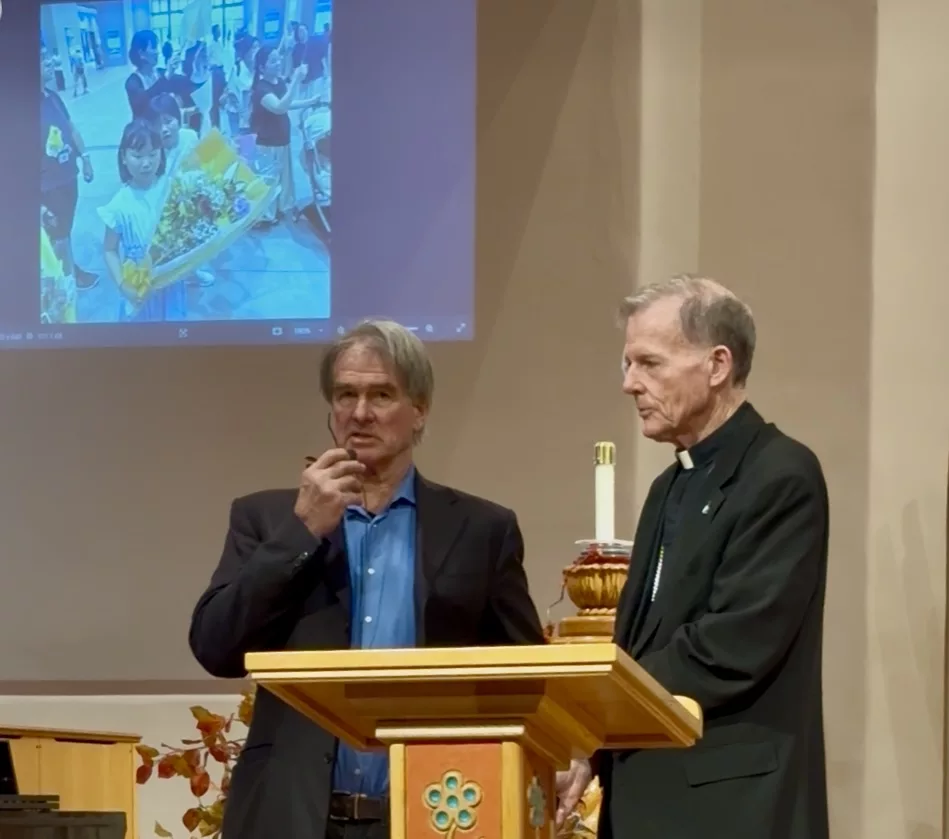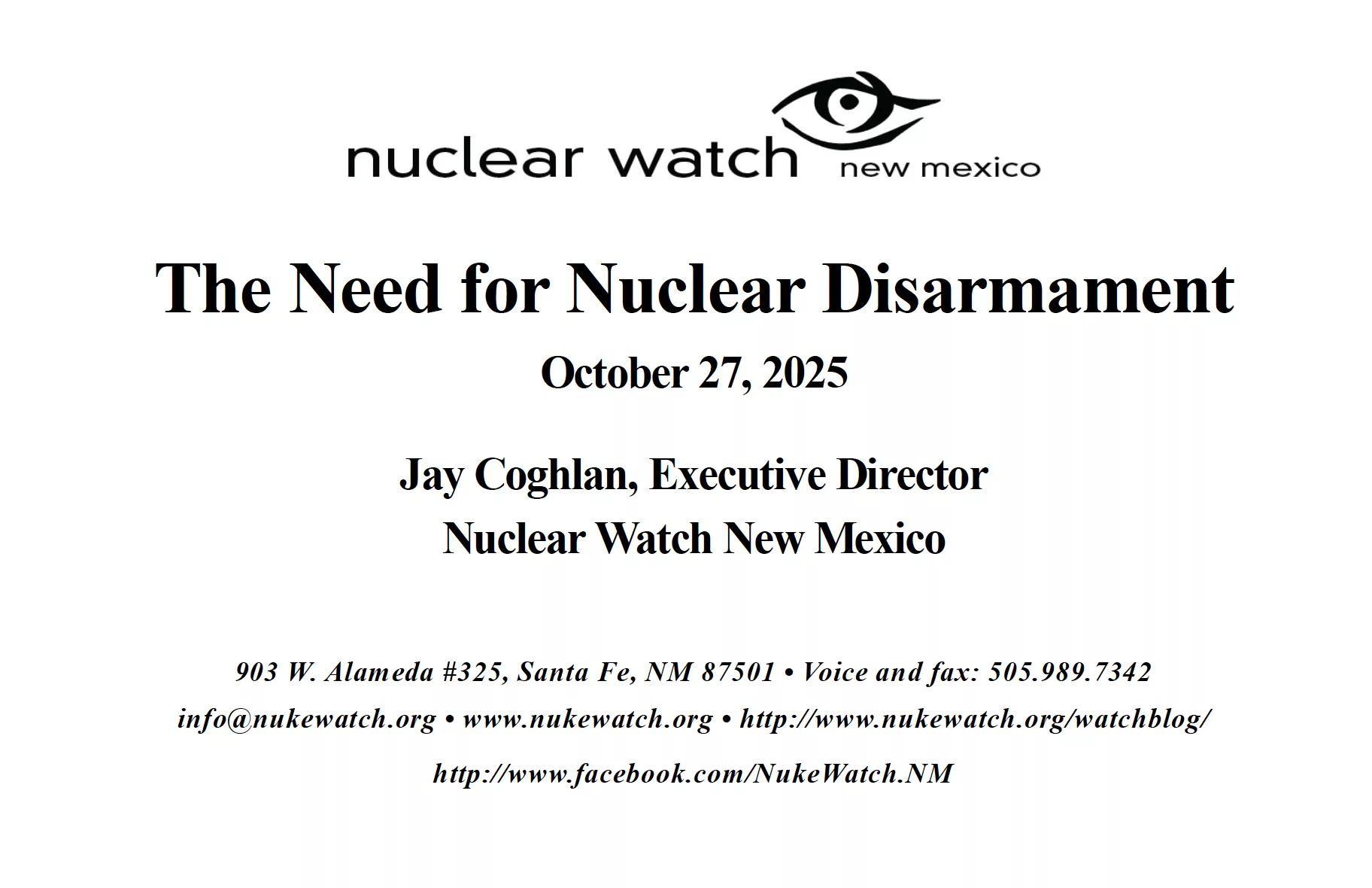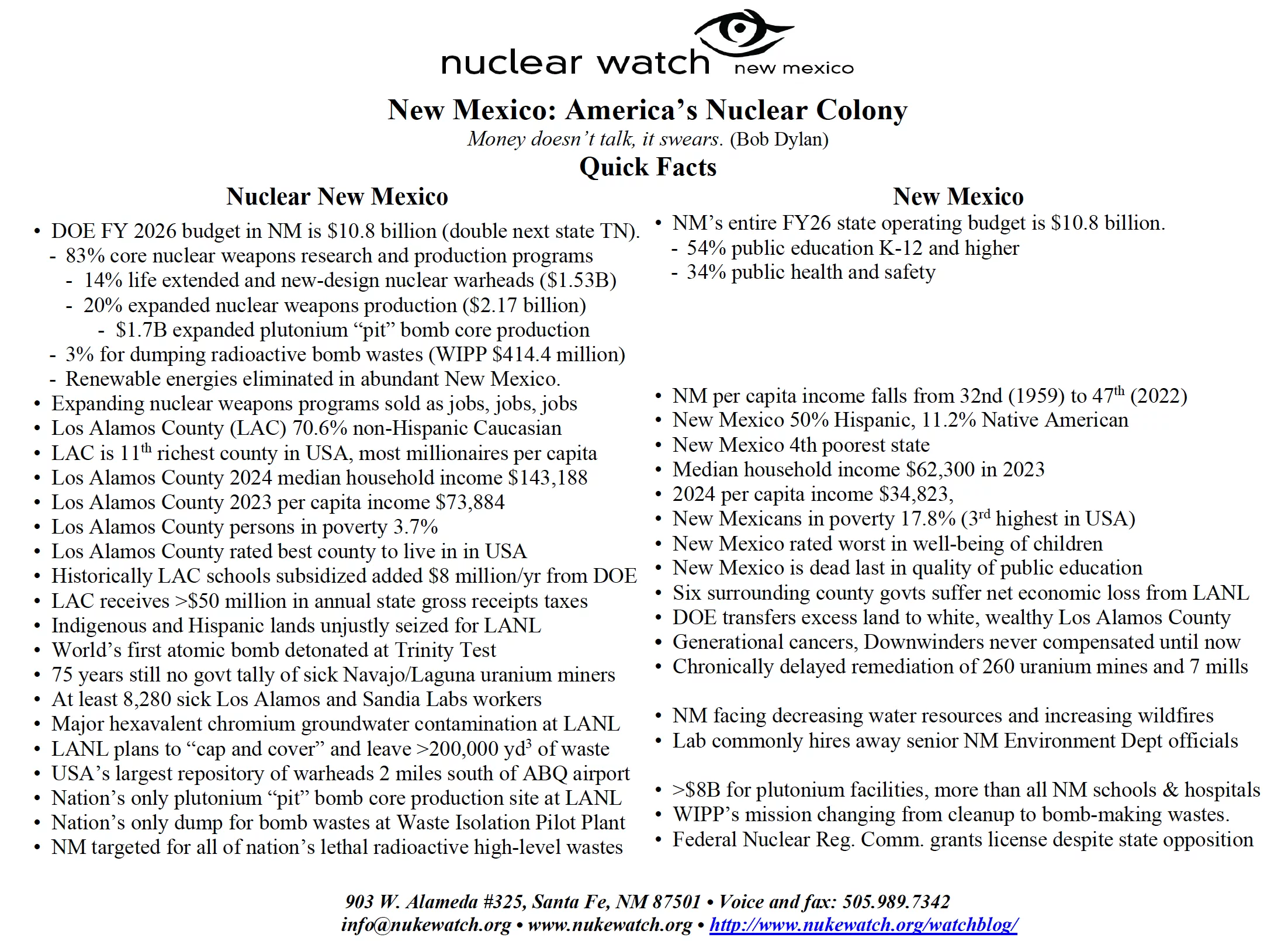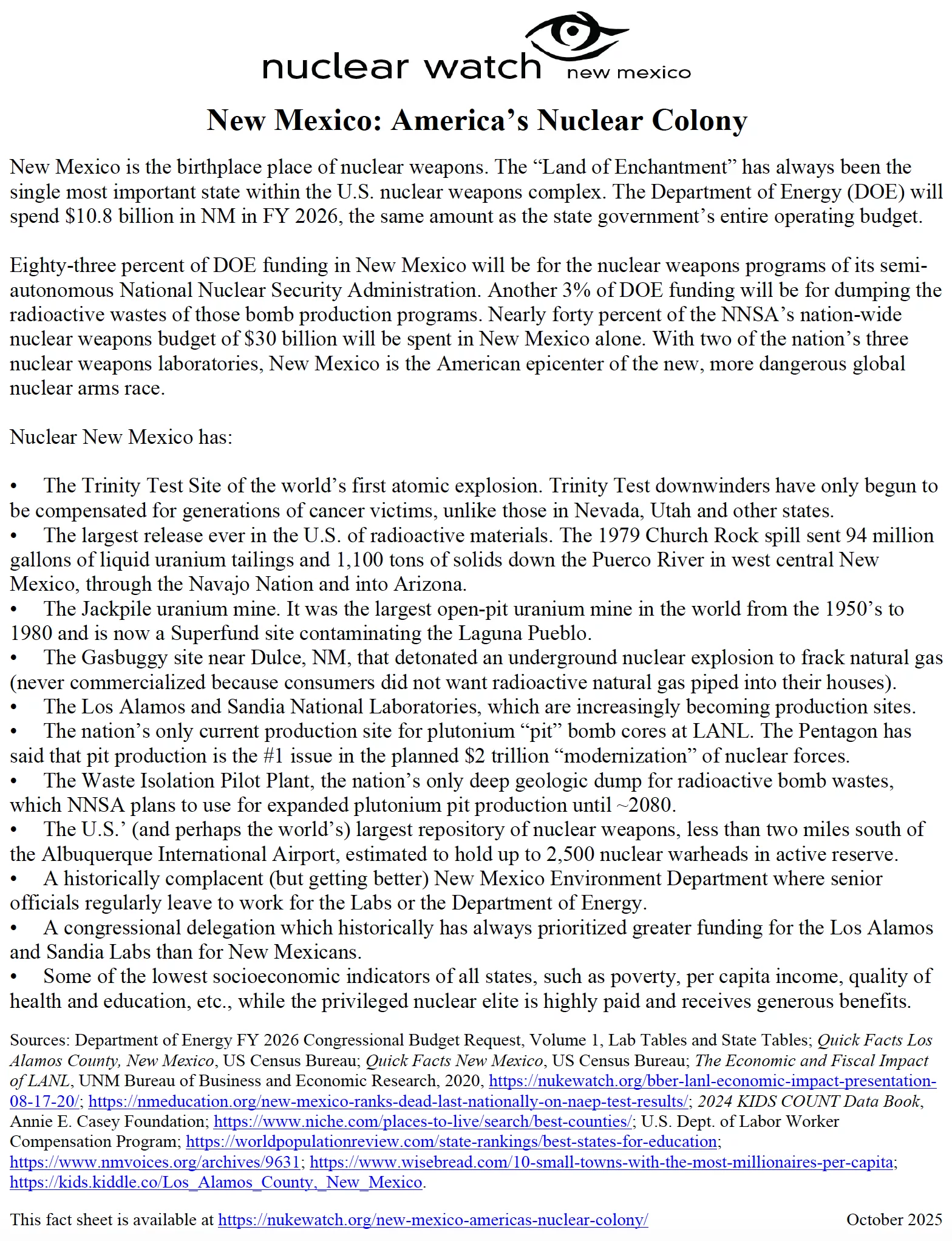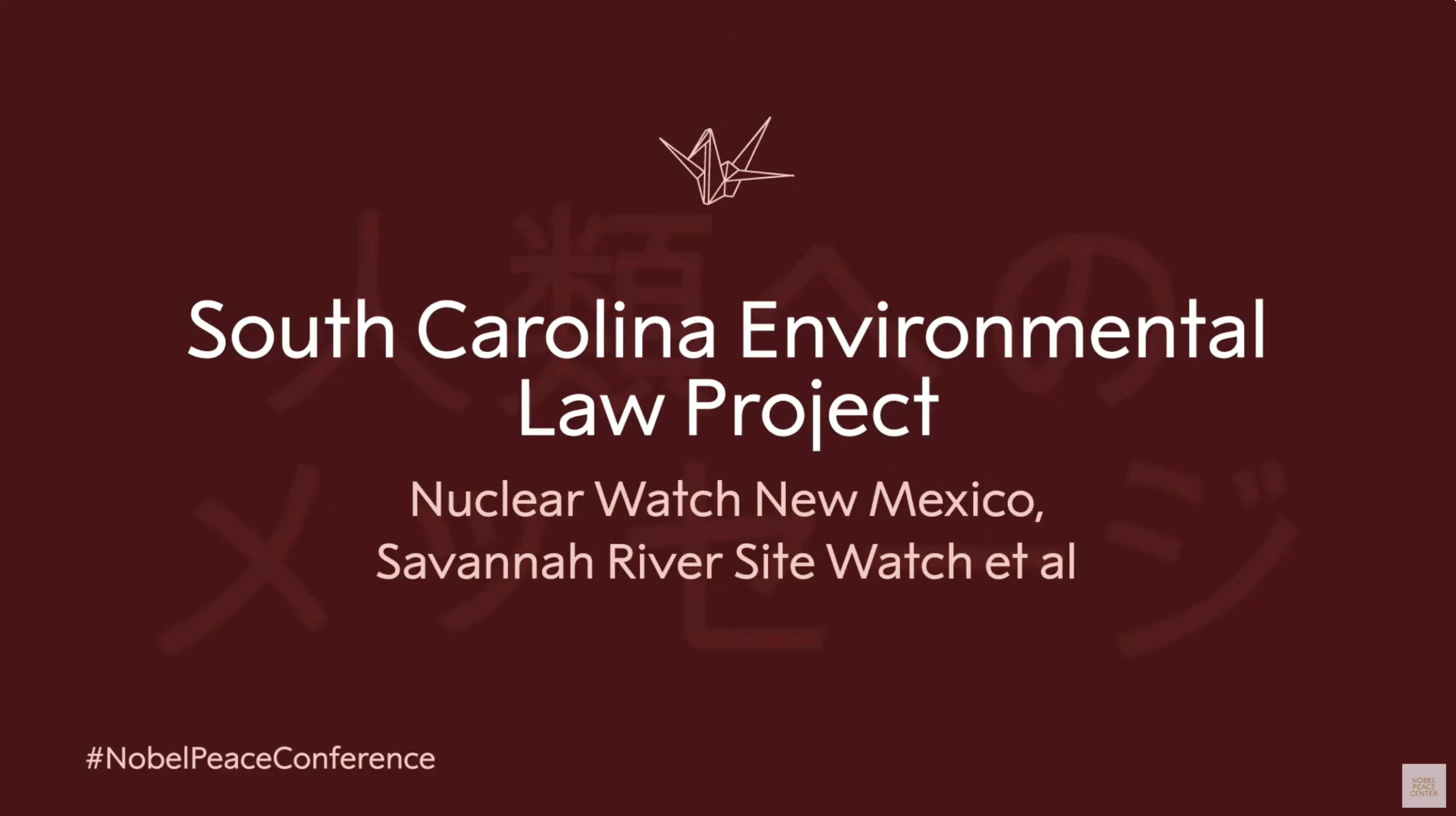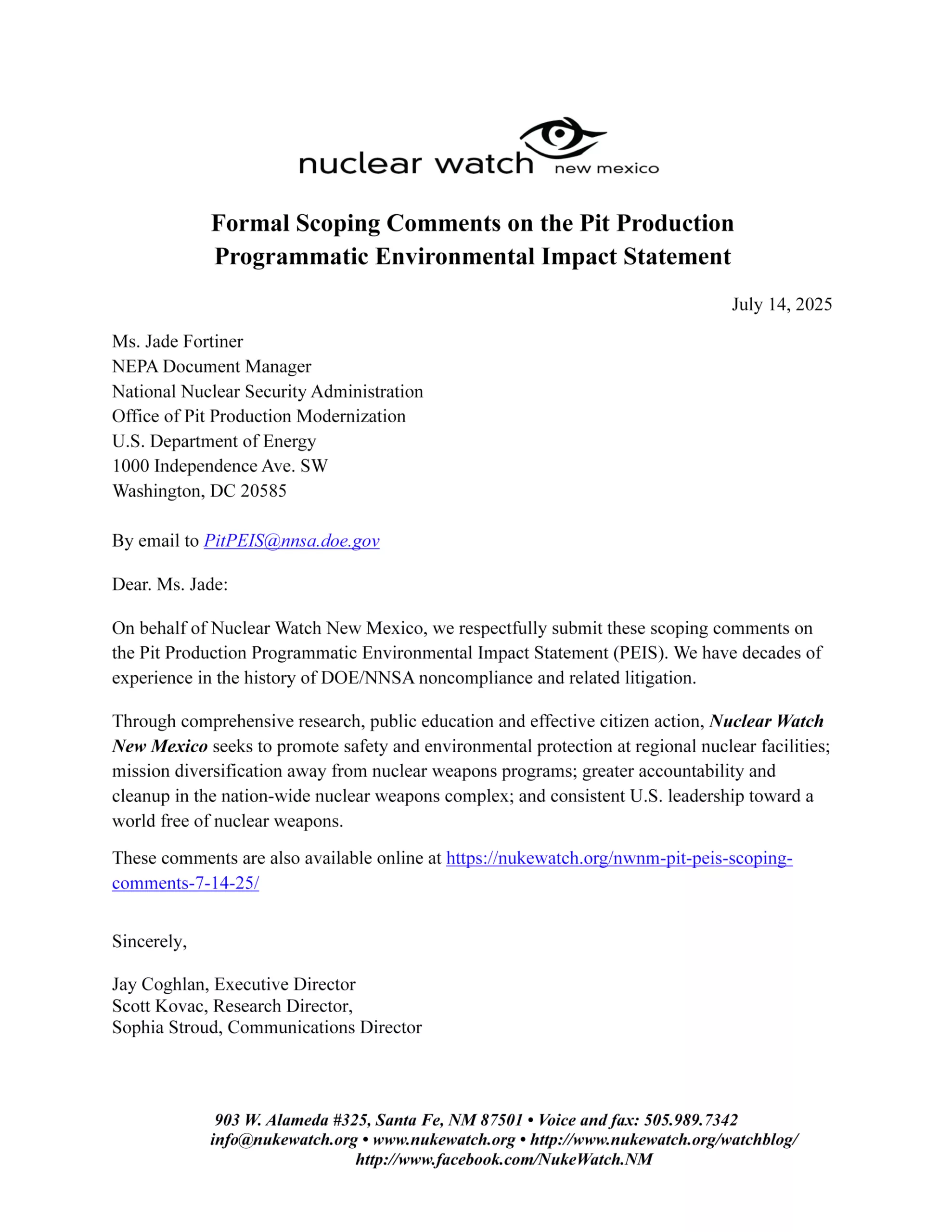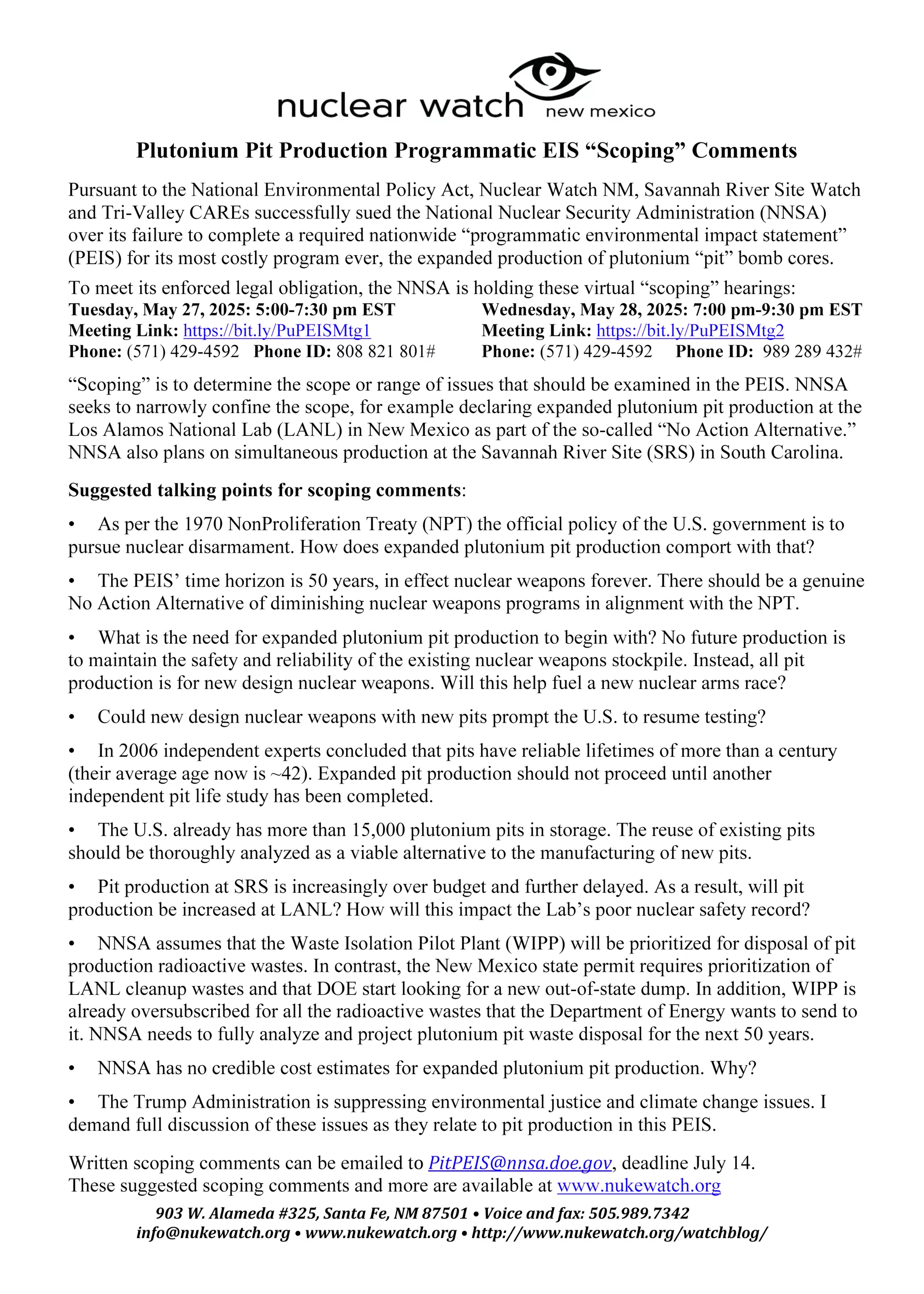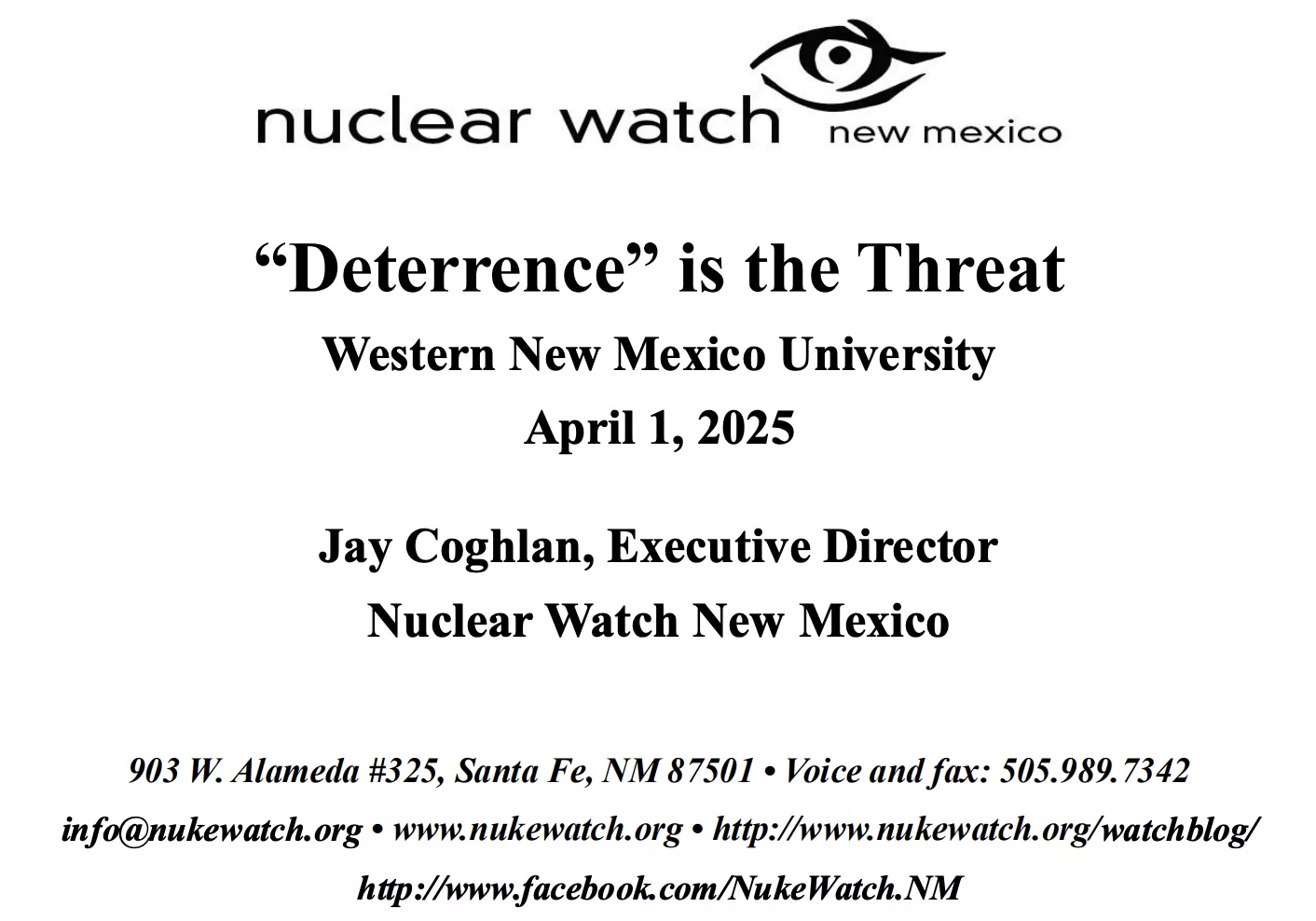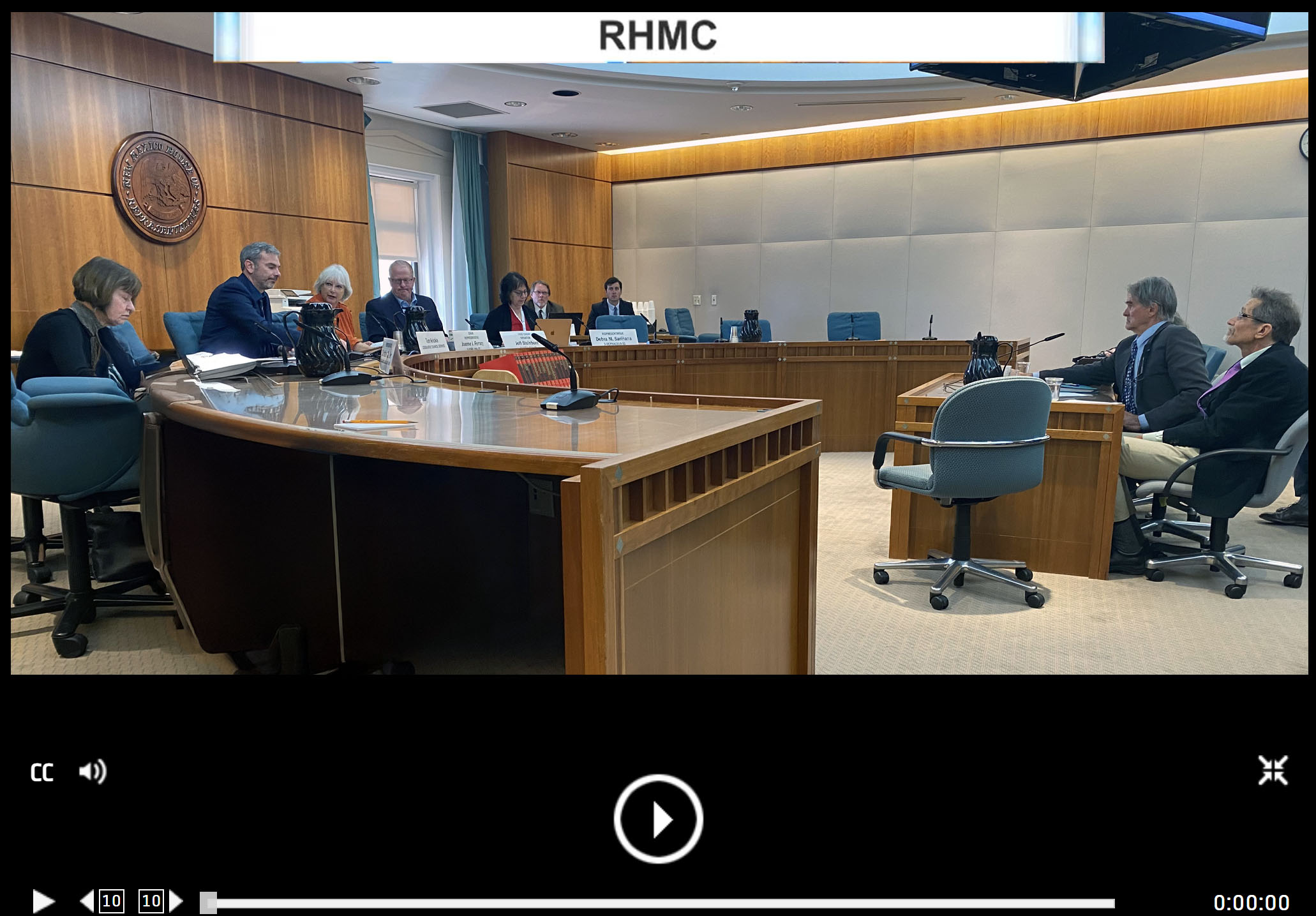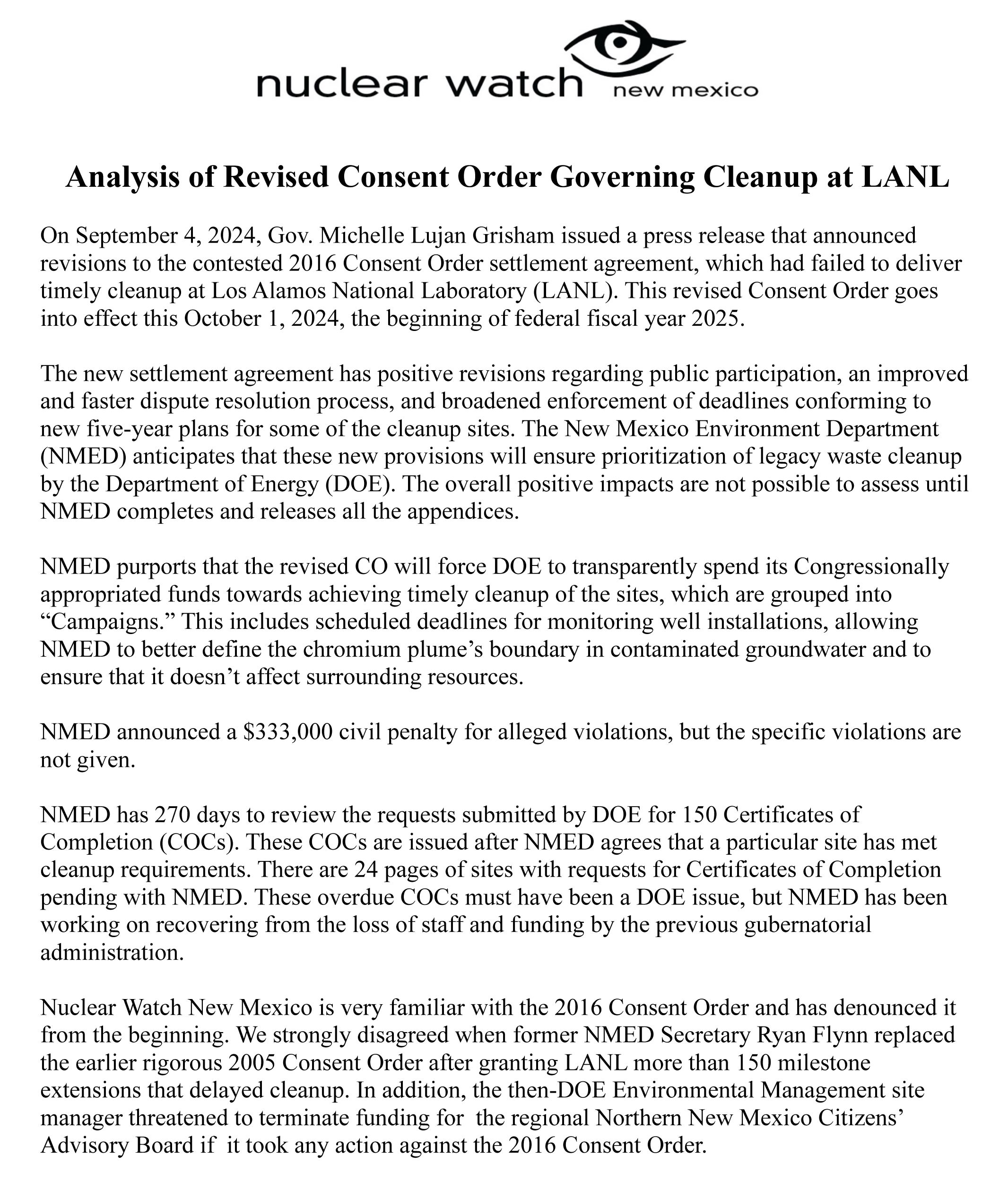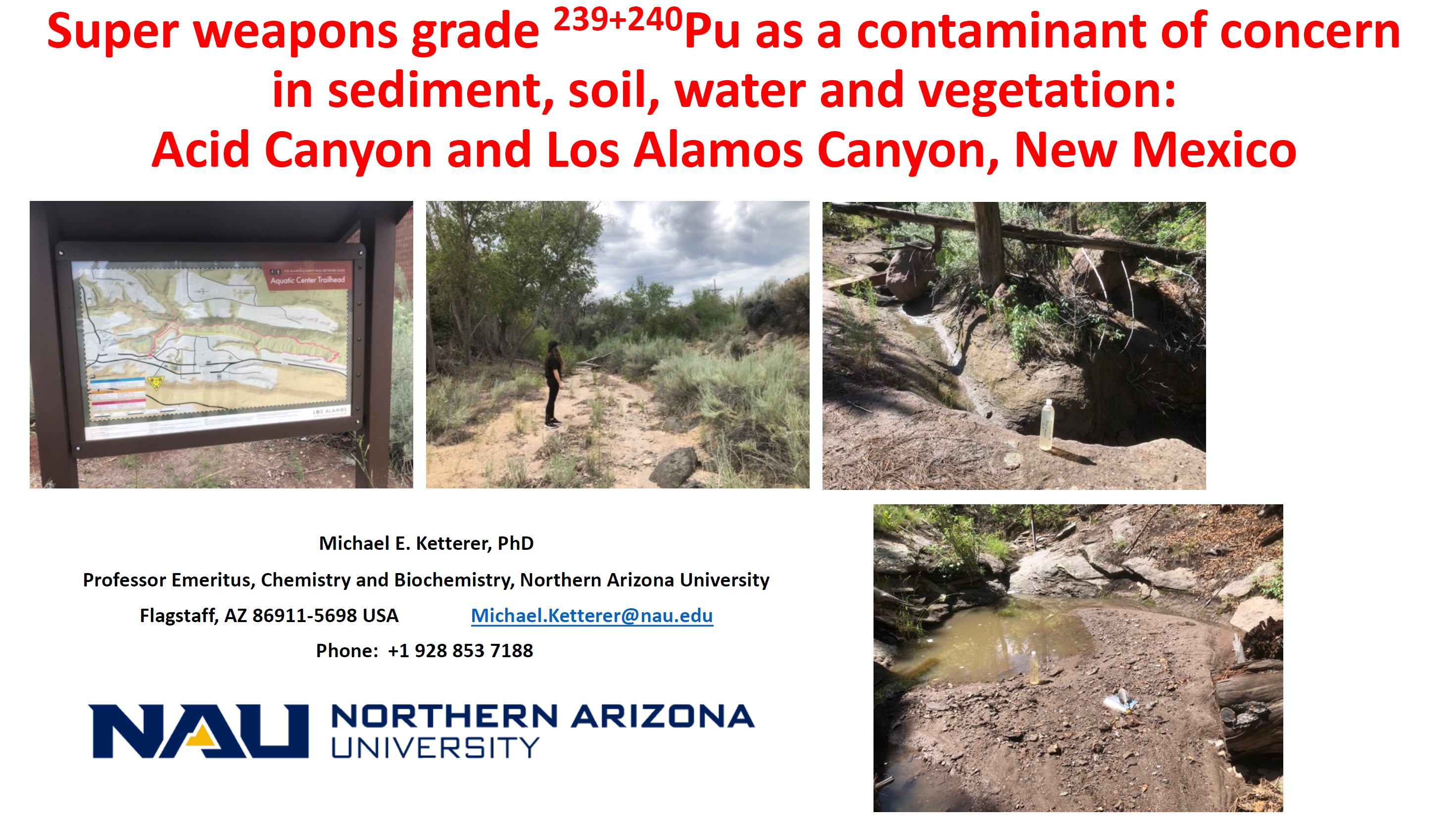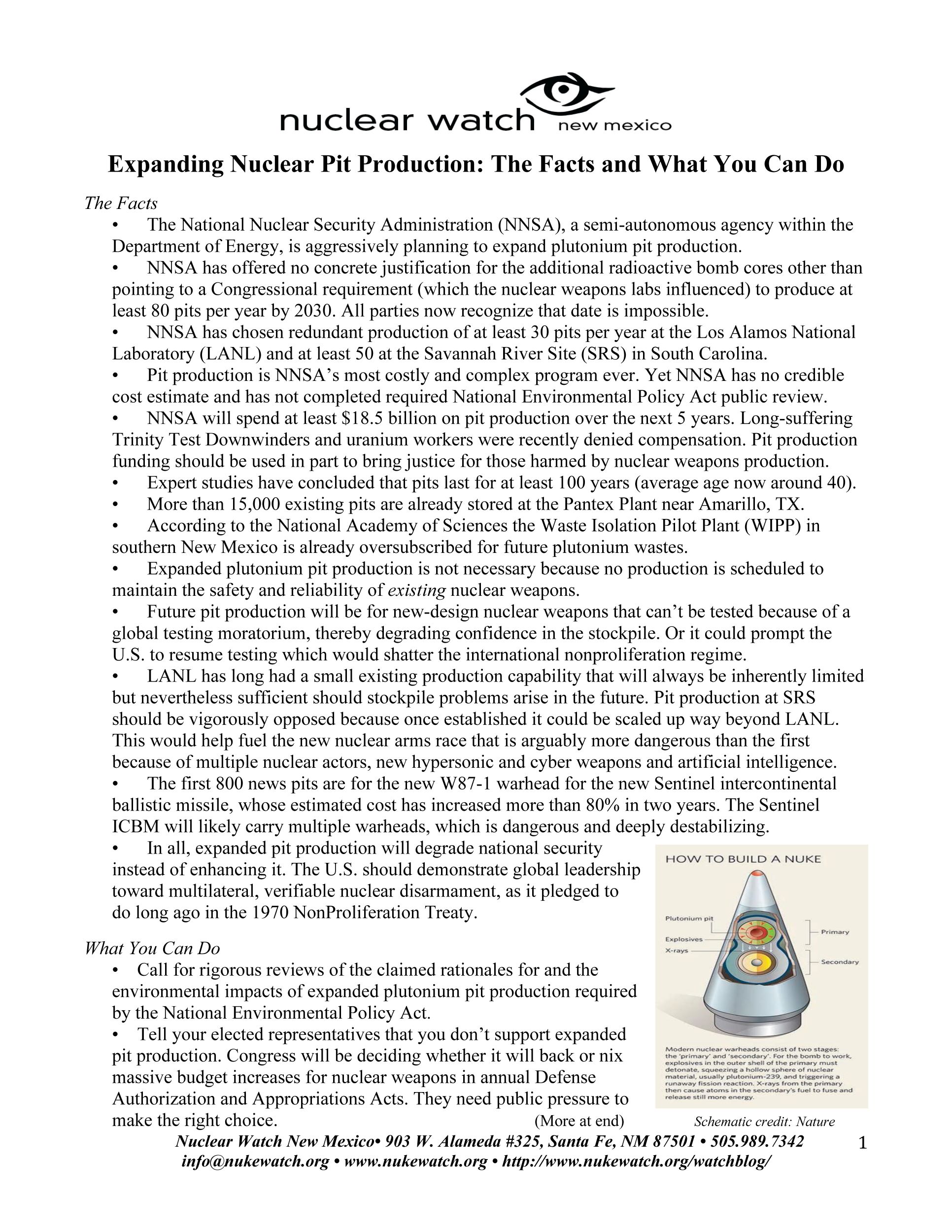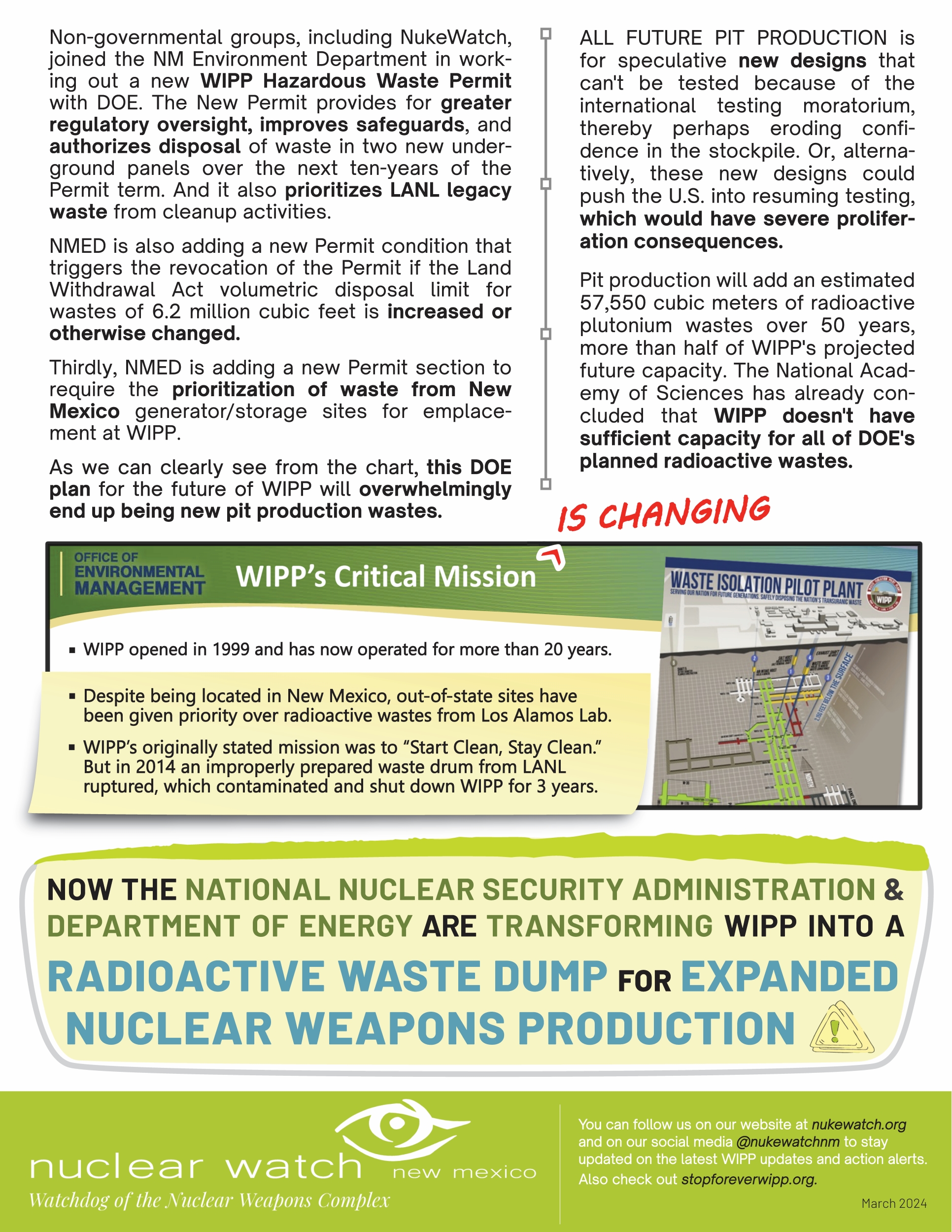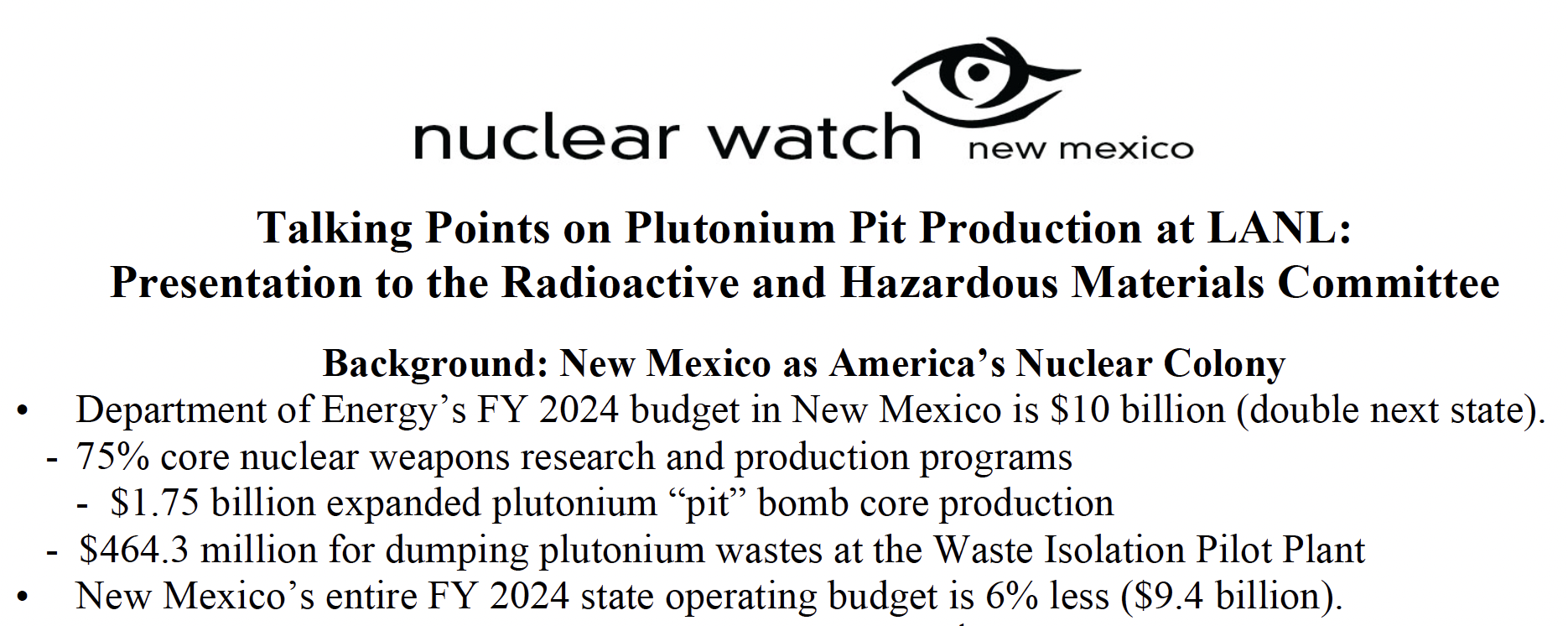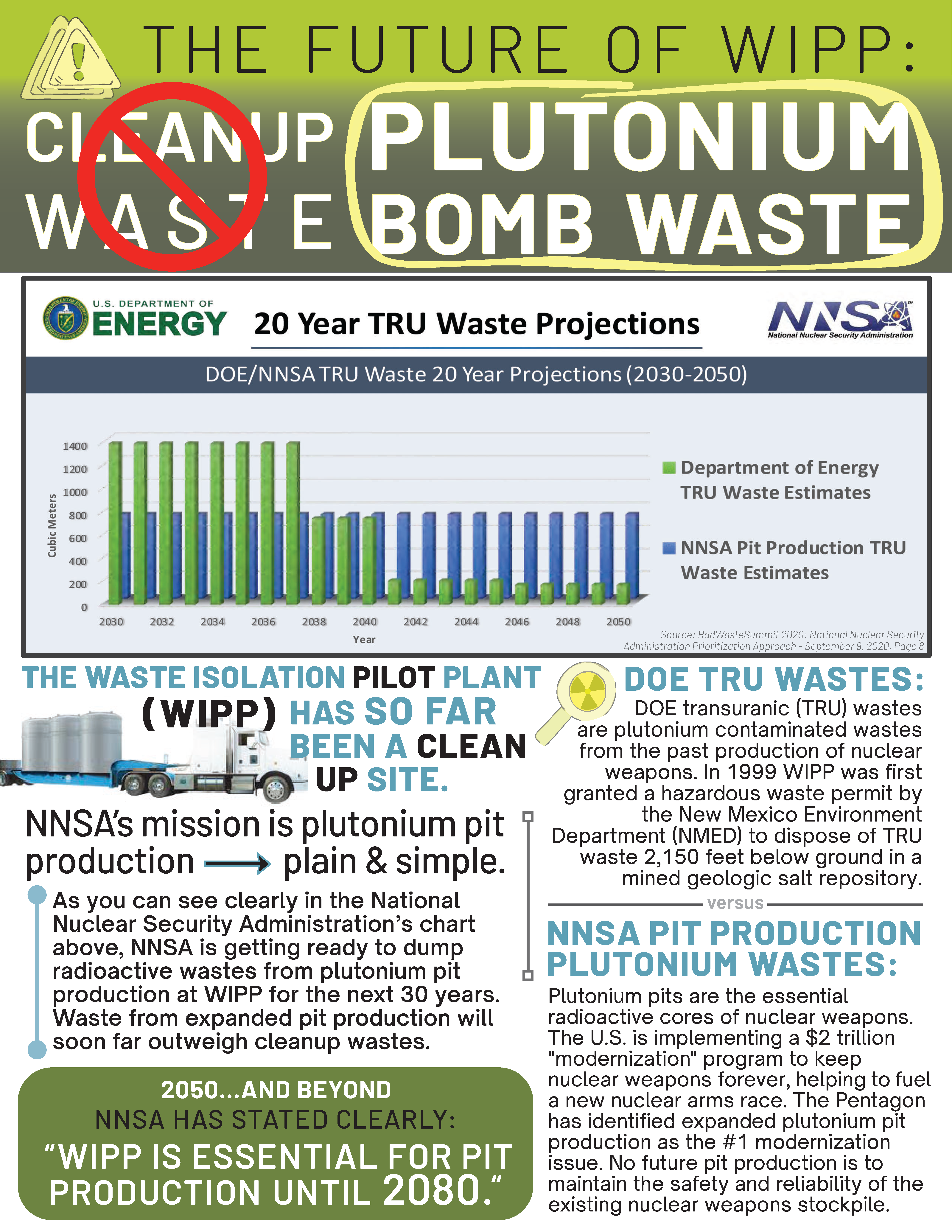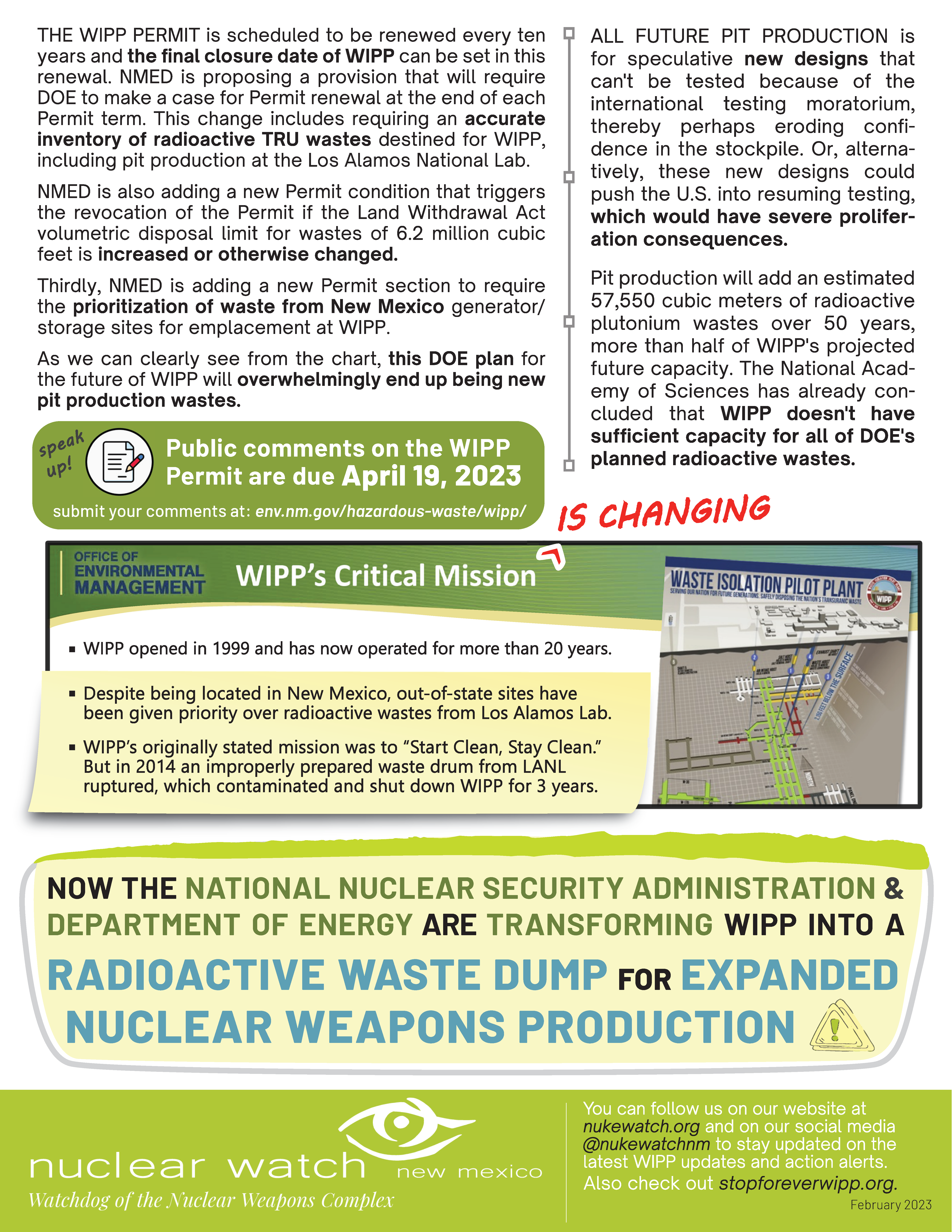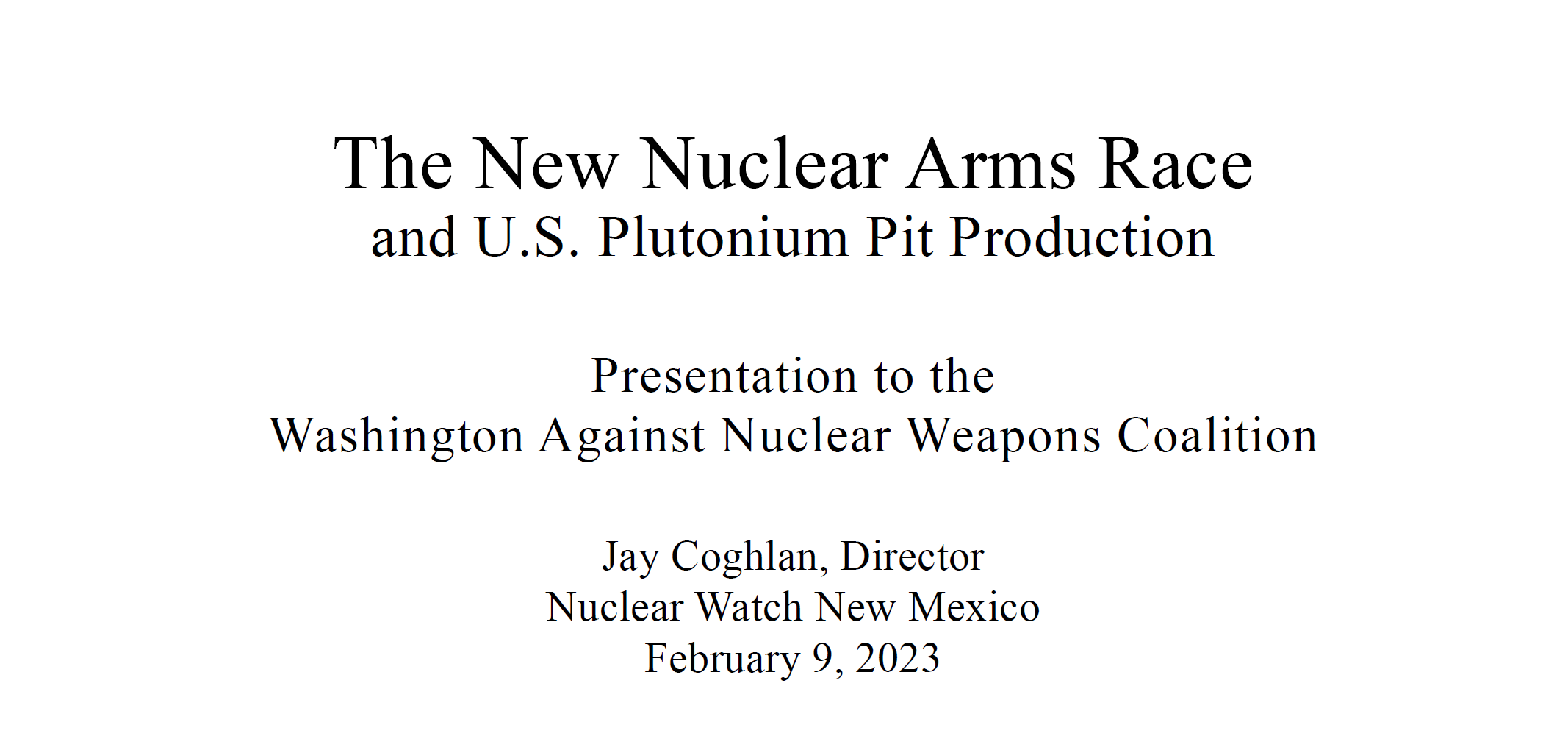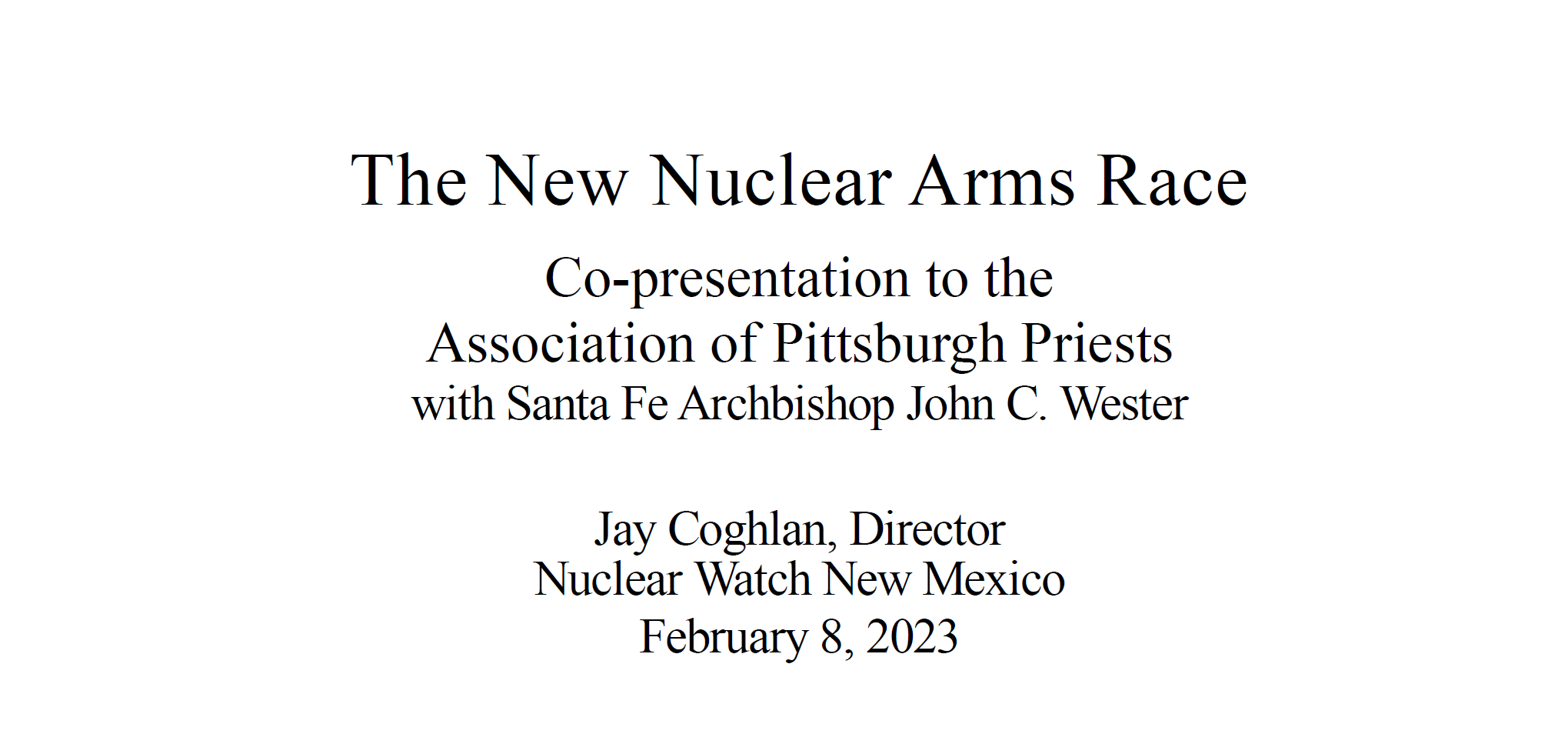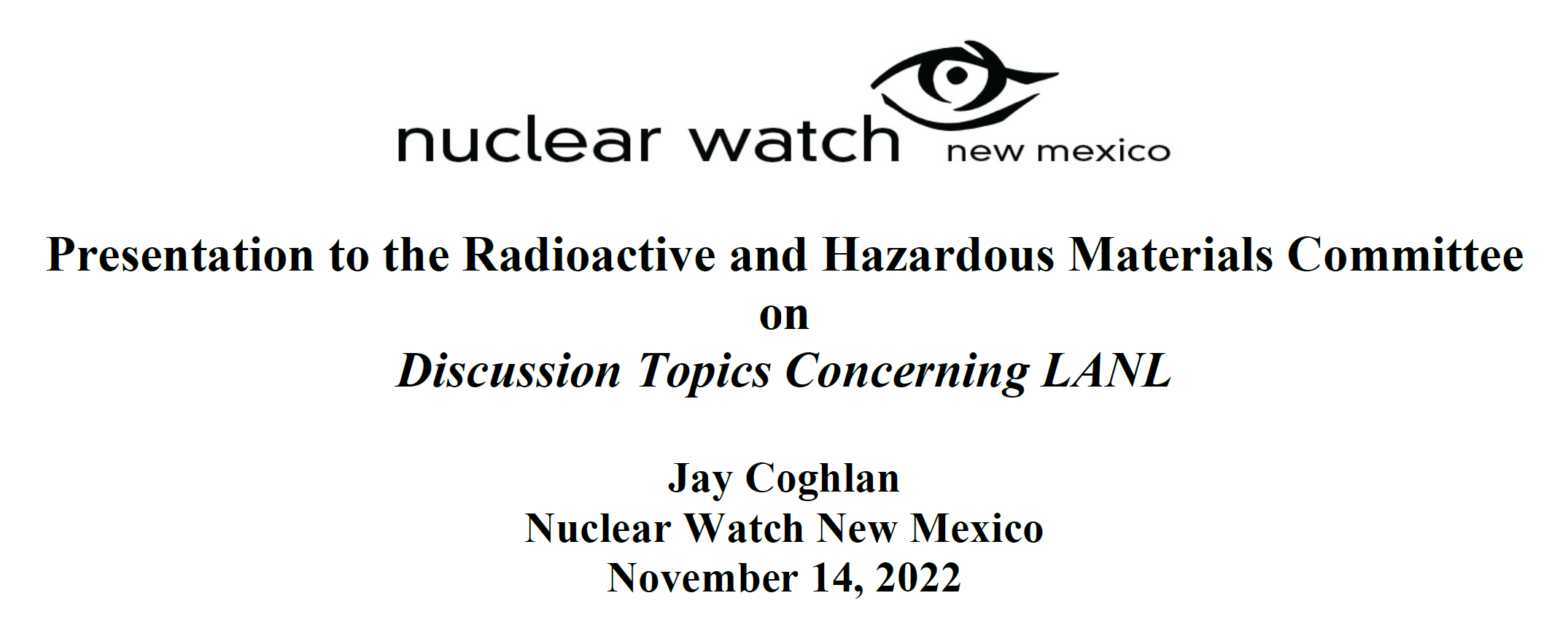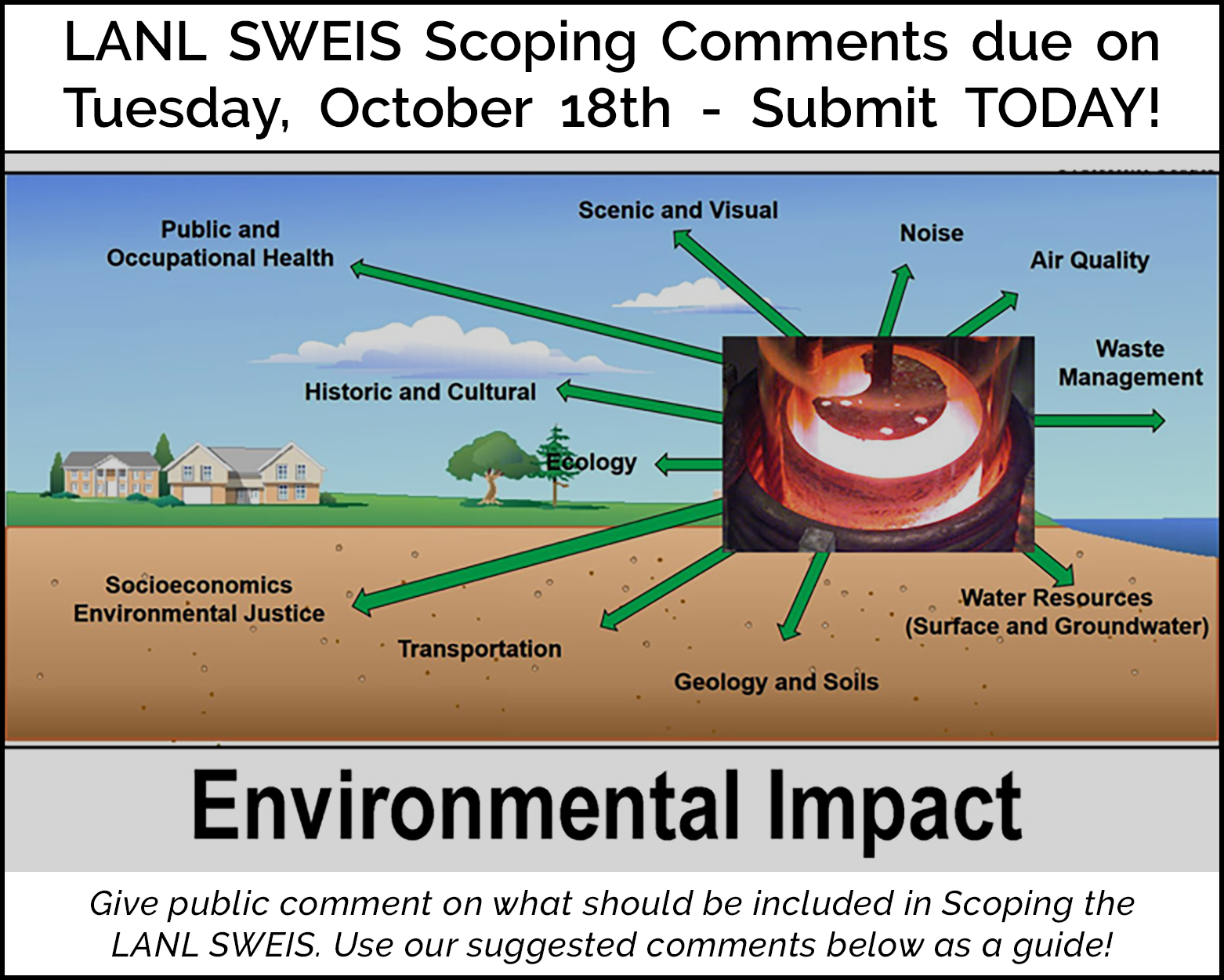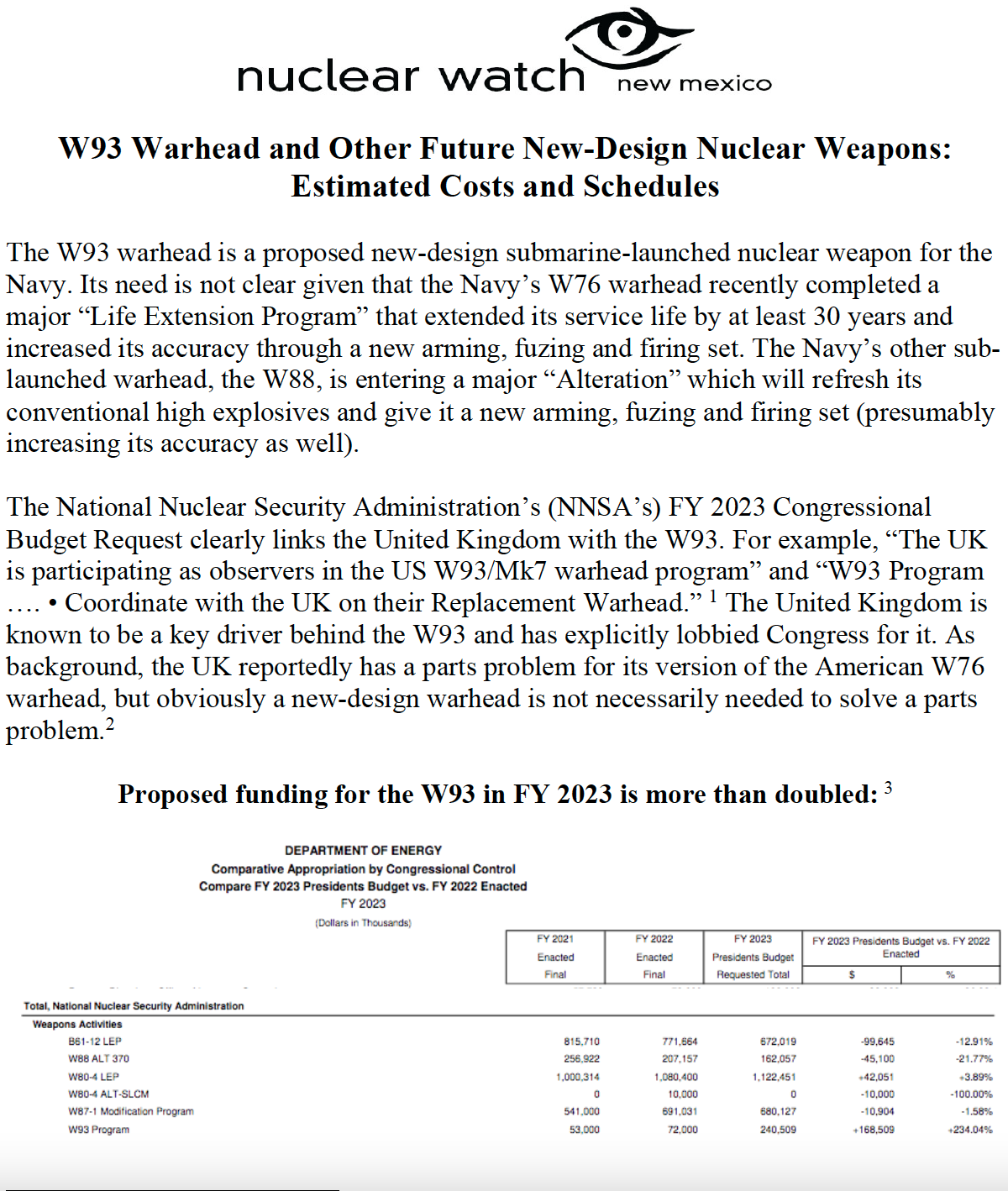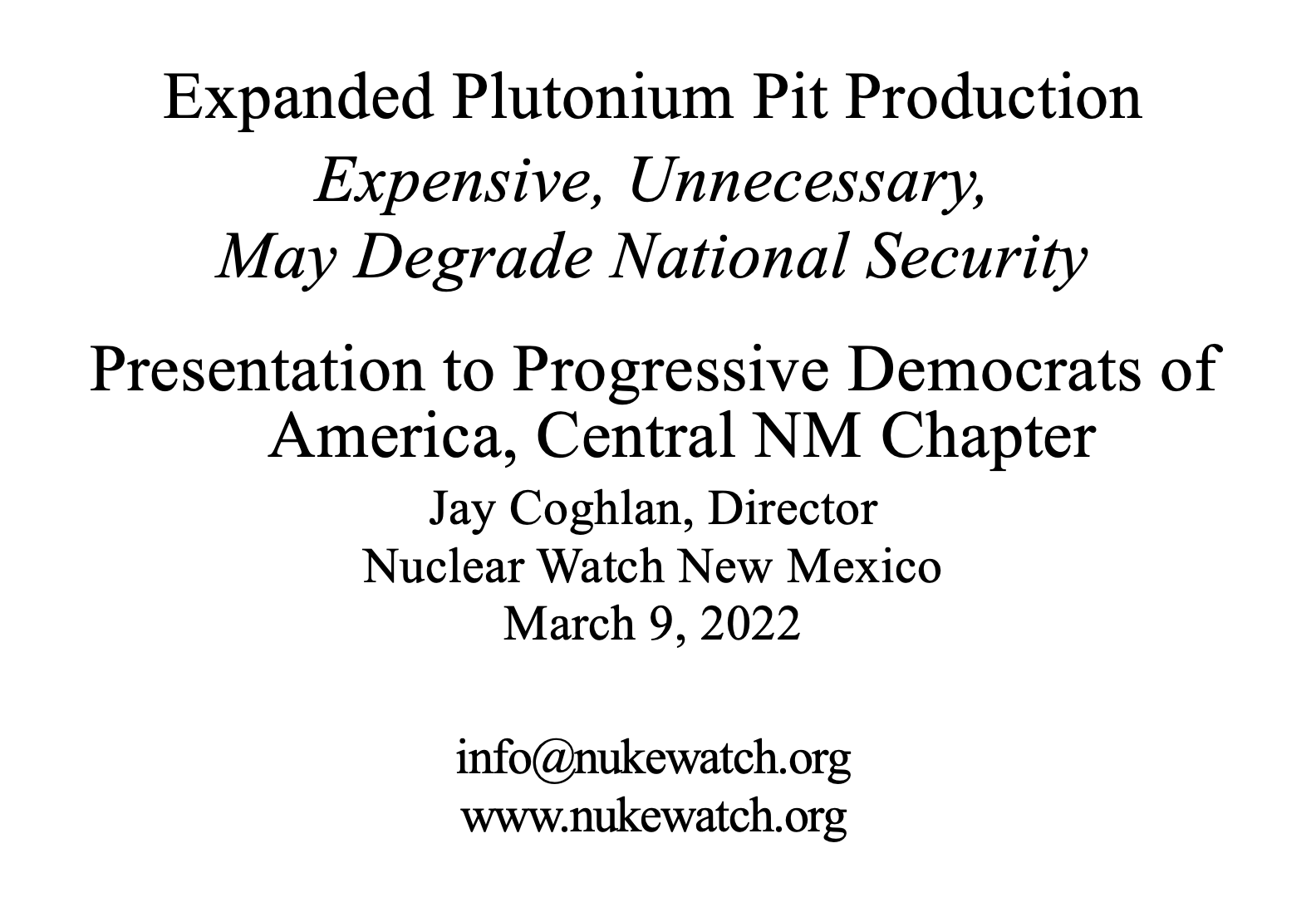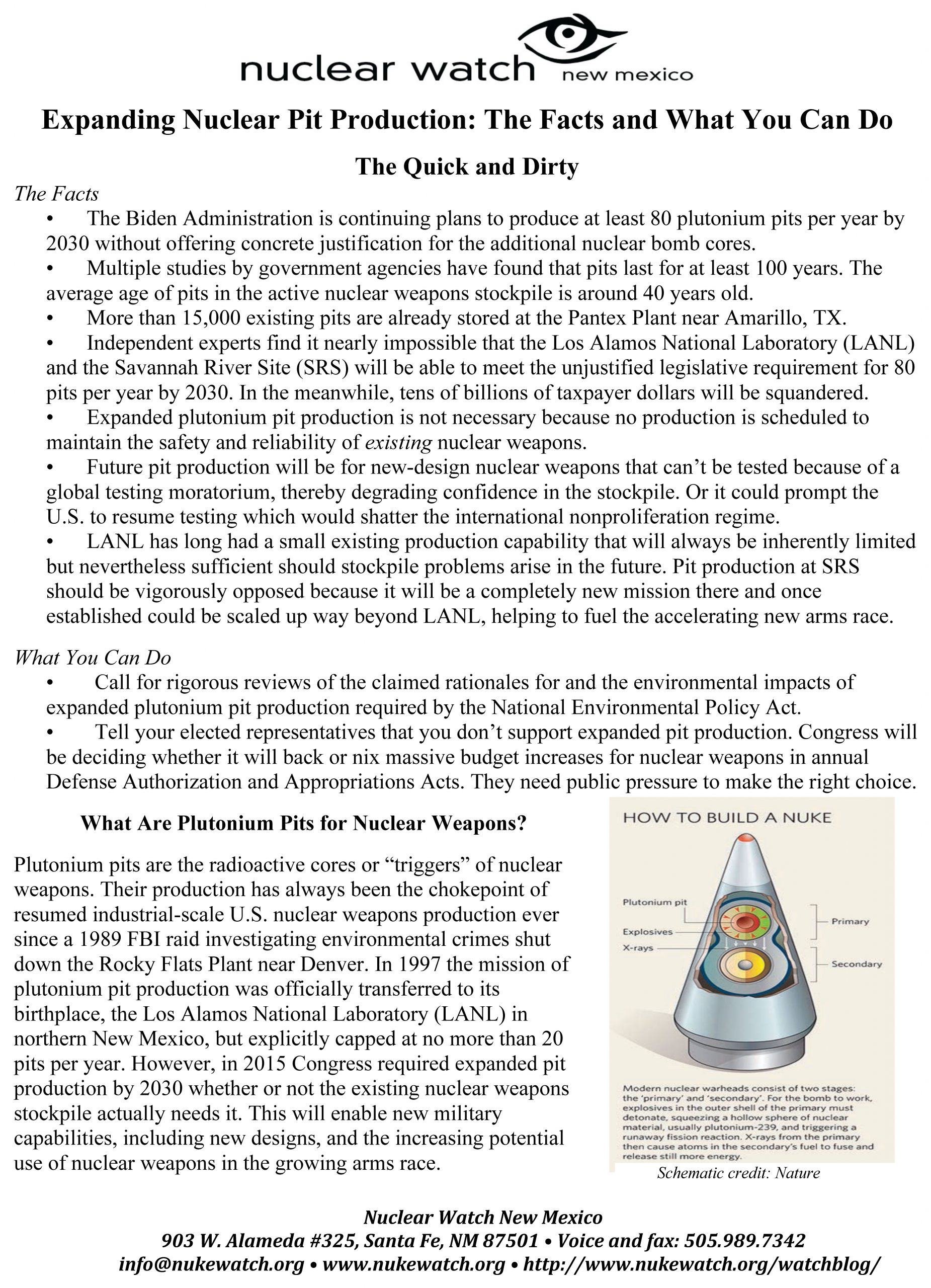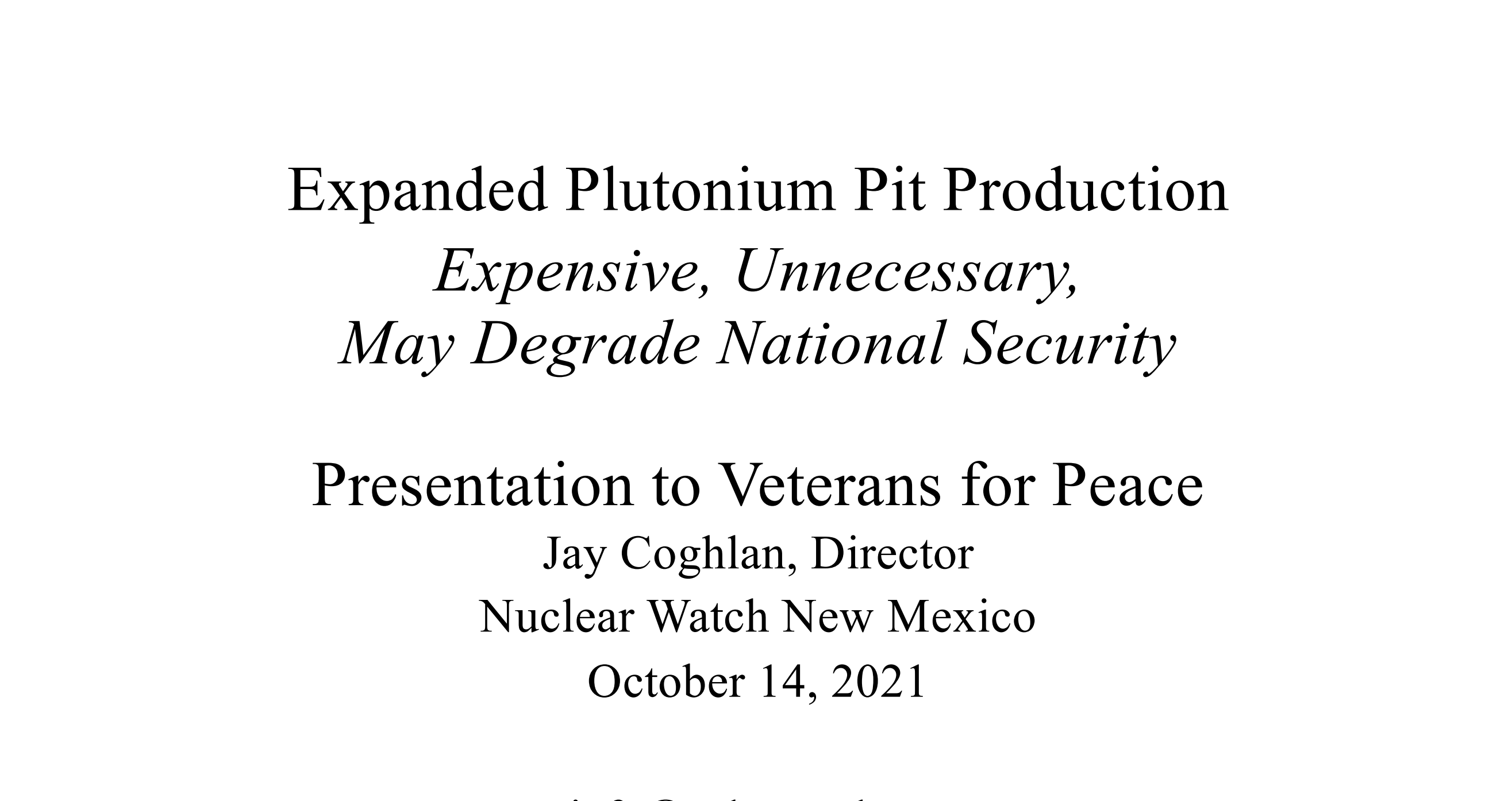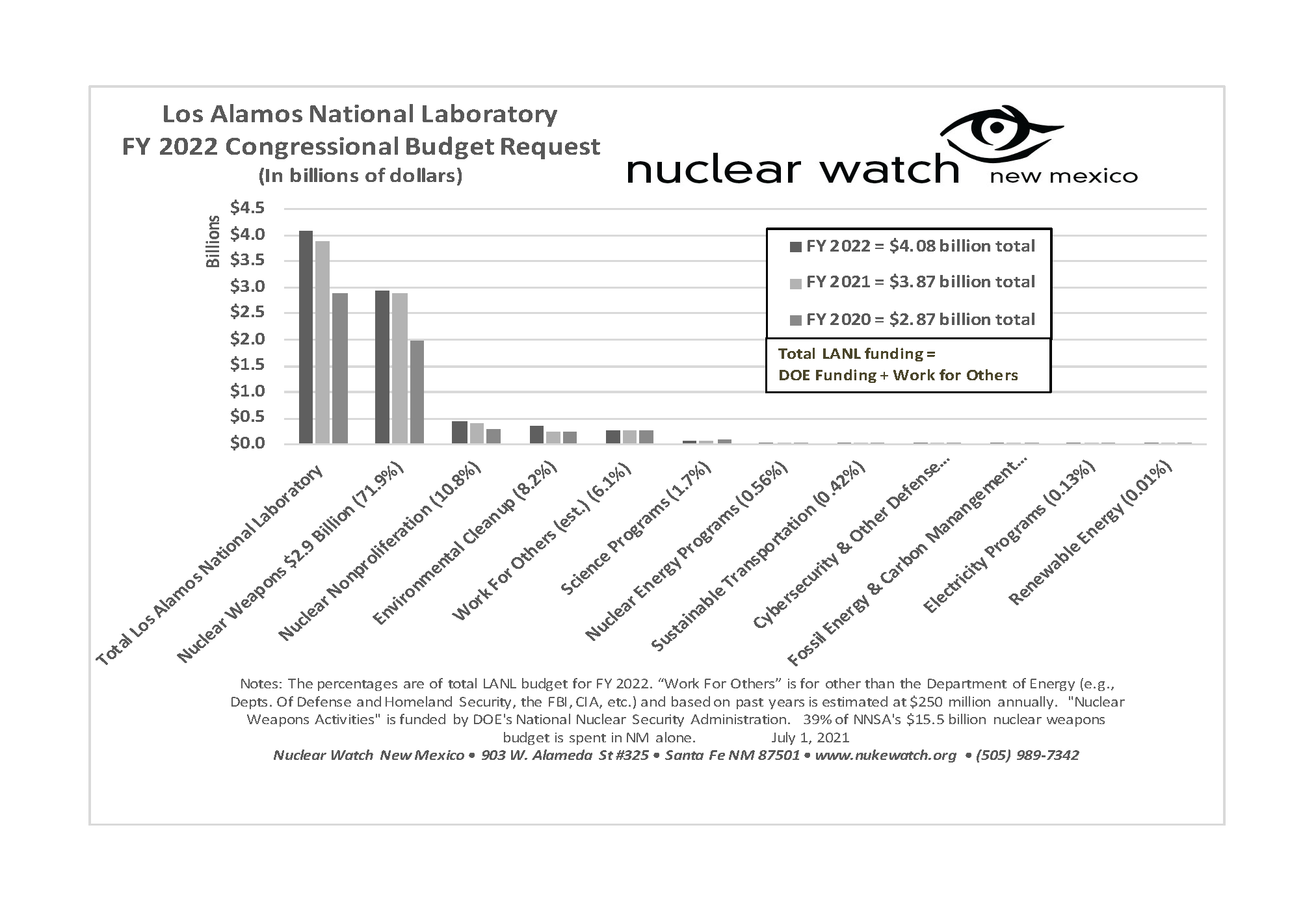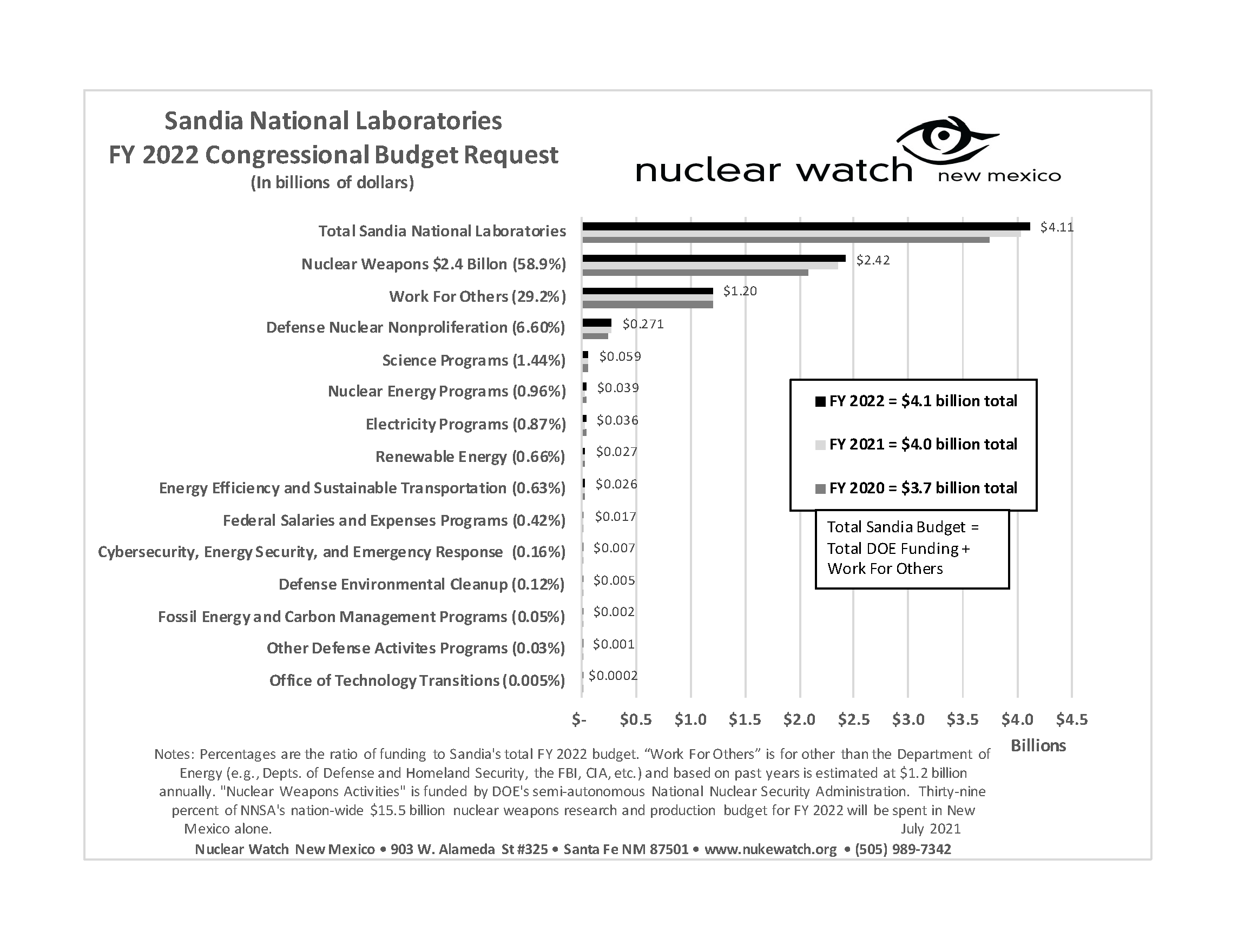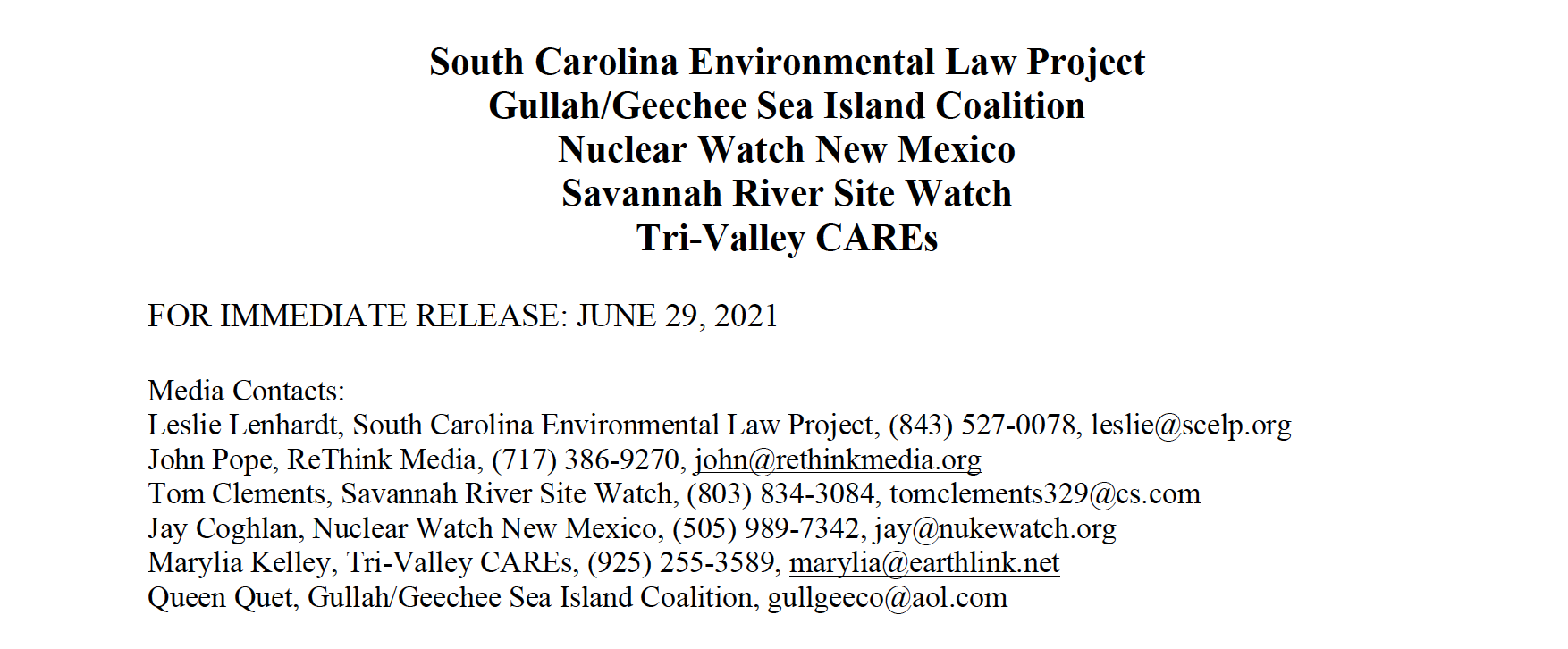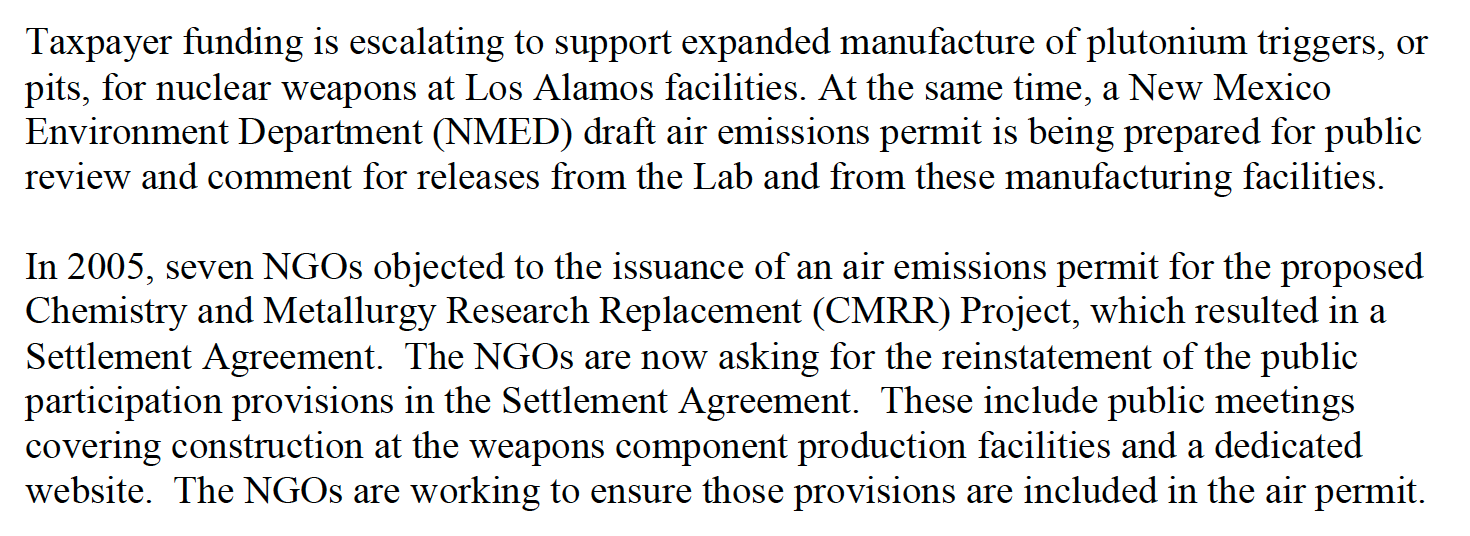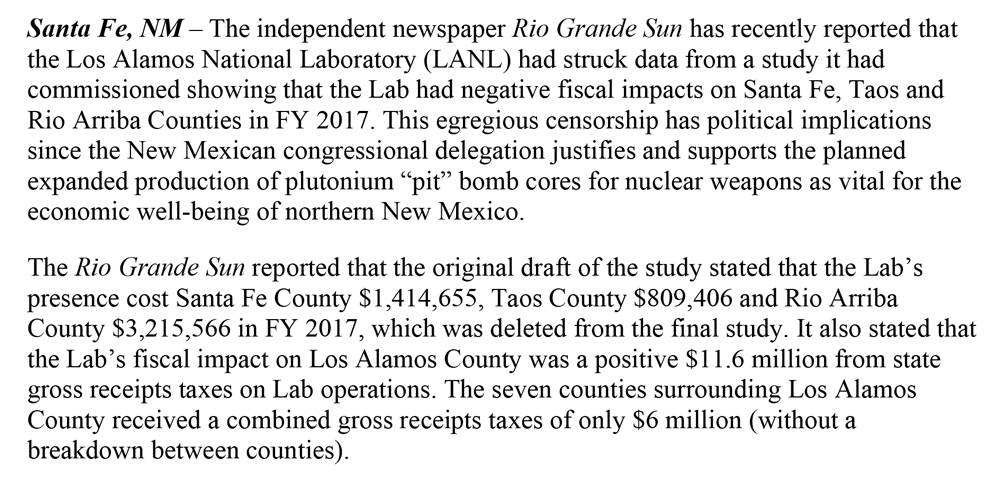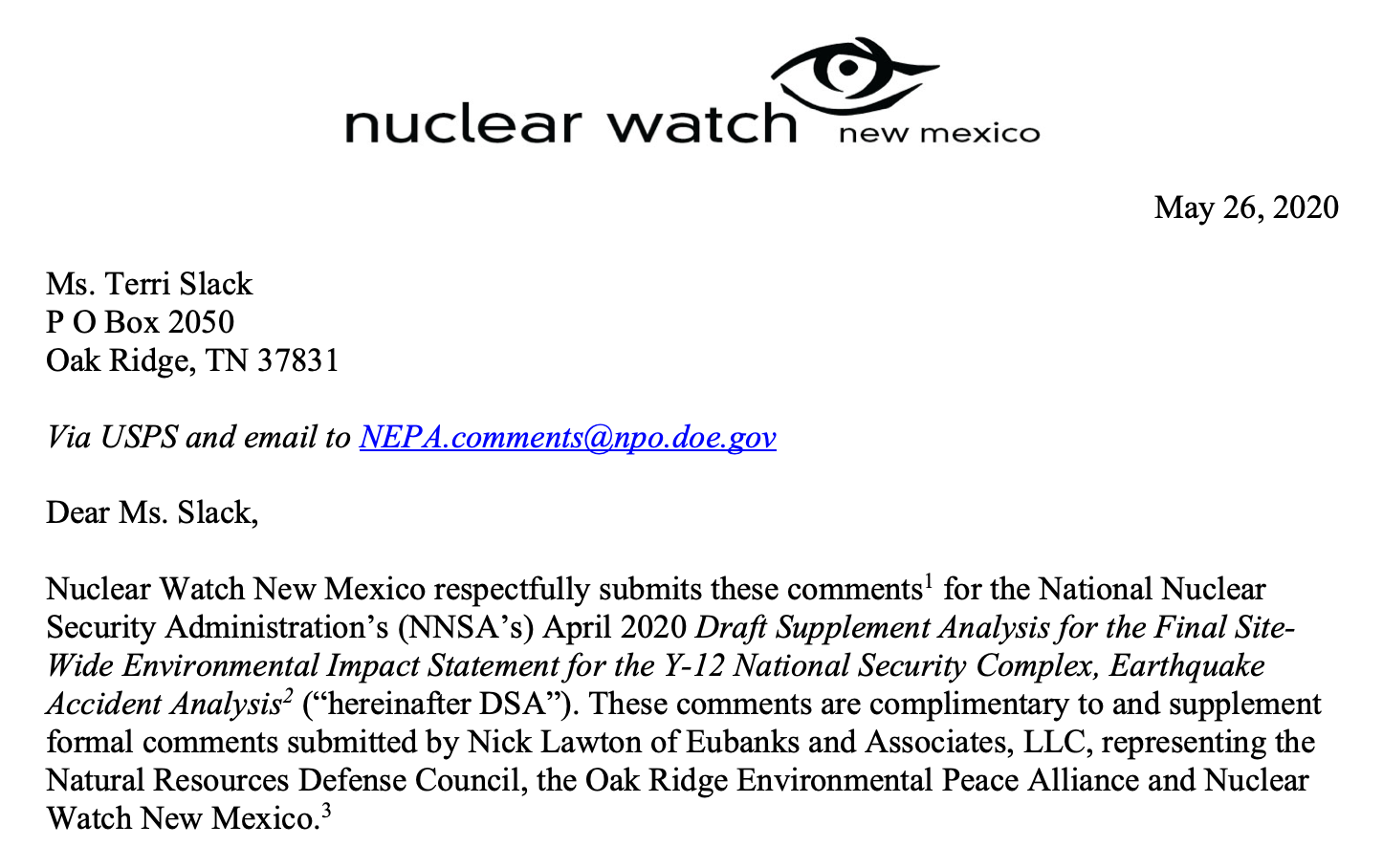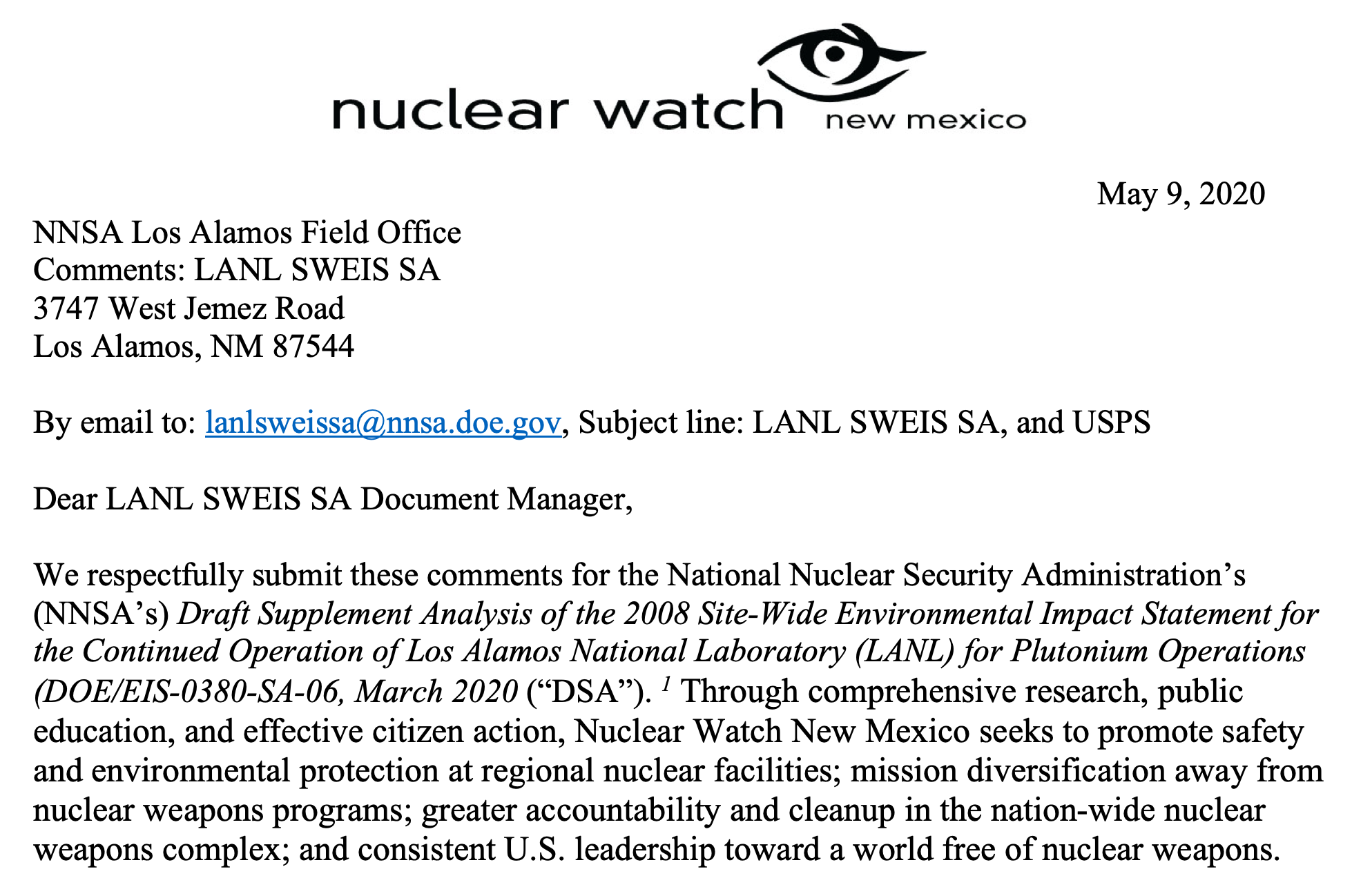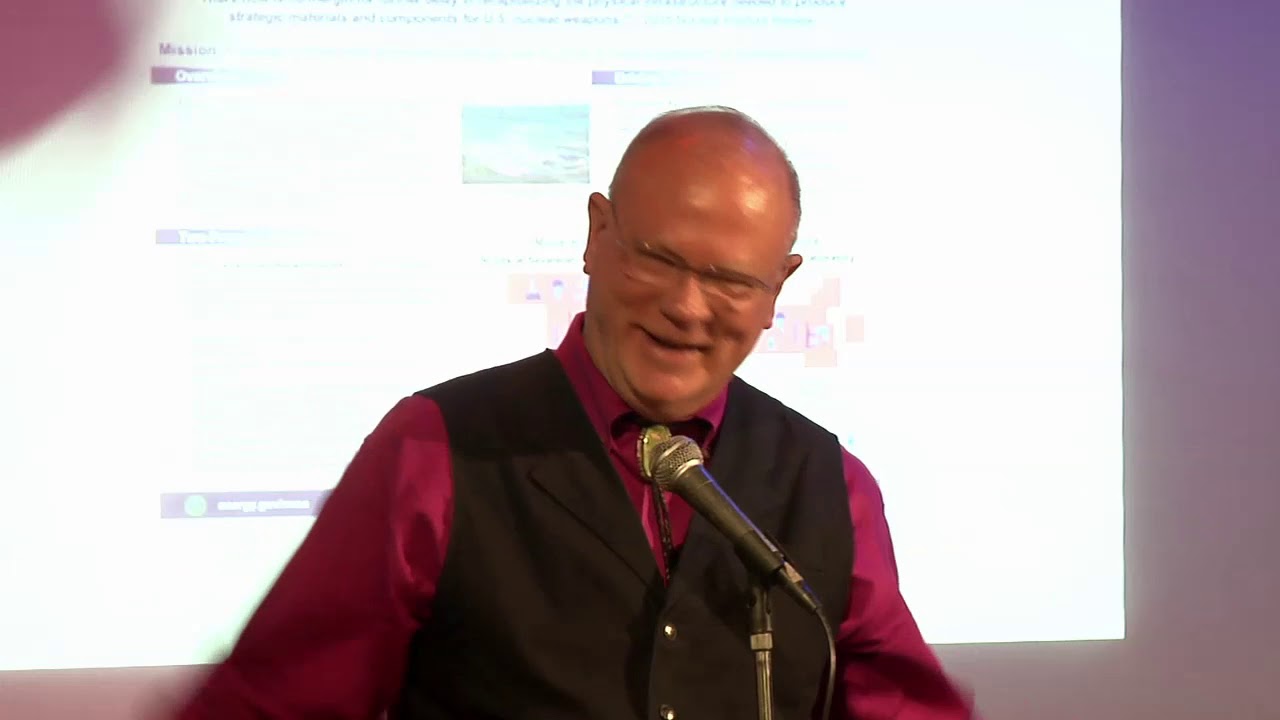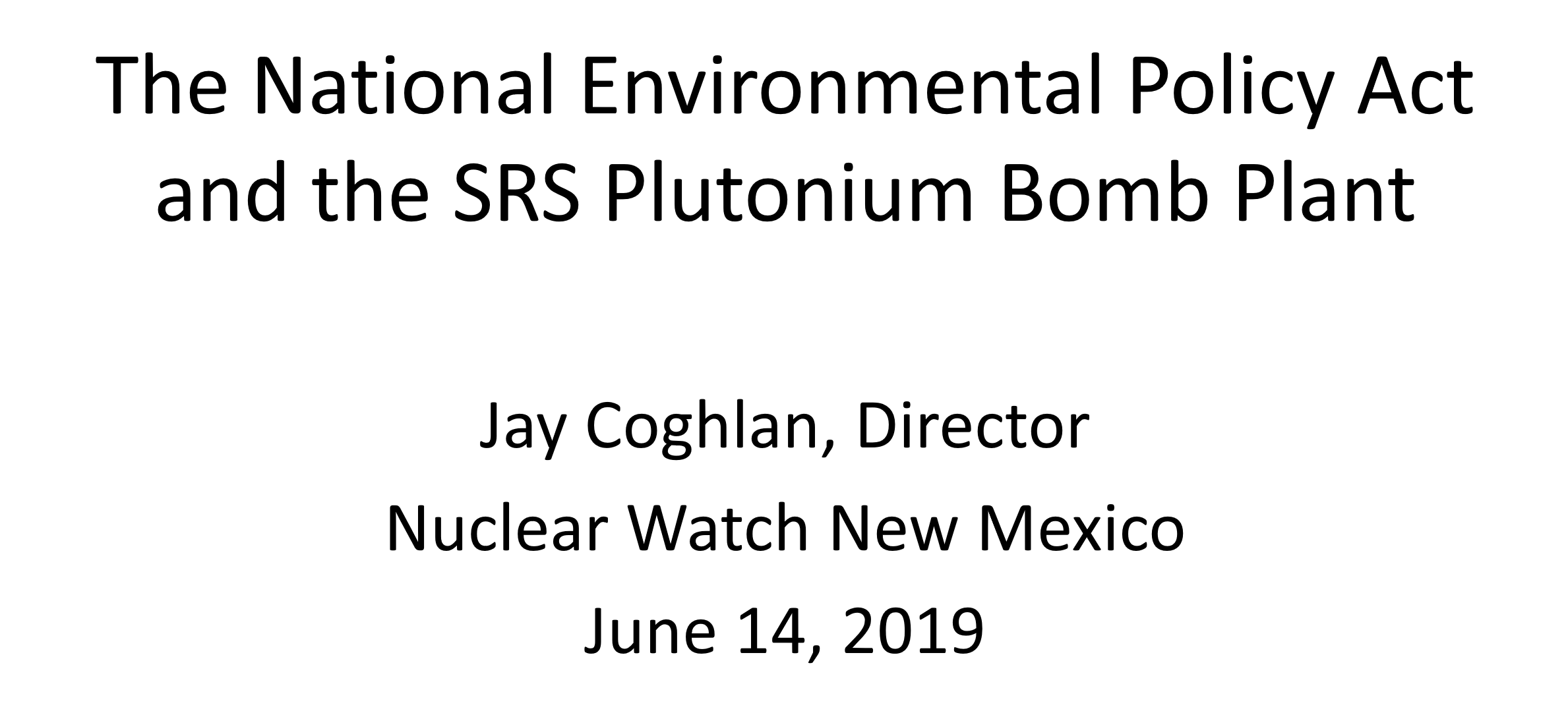RECENT WORK
Department of Energy Seeks to Eliminate Radiation Protections Requiring Controls “As Low As Reasonably Achievable”
FOR IMMEDIATE RELEASE, November 21, 2025
Contact: Jay Coghlan, 505.989.7342, c. 505.470.3154 | Email
Santa Fe, NM – An internal Department of Energy (DOE) memorandum eliminates worker and public radiation protection rules known “As Low As Reasonably Achievable” (ALARA). This fundamental departure from decades of accepted health physics practices is being promoted by senior DOE political appointees with little background in health or radiation control. It is marked as “URGENCY: High” under the auspices of the DOE Deputy Secretary, the Under Secretary for Science, and the Administrator of the National Nuclear Security Administration. The memorandum awaits the final signature of DOE Secretary Chris Wright.
The memo’s stated goal is to:
“…remove the ALARA principle from all DOE directives and regulations, including DOE Order 458.1, Radiation Protection of the Public and the Environment, NE [Office of Nuclear Energy] Order 458.1, Radiation Protection of the Public, and, upon completion of the rulemaking process, 10 CFR [Code of Federal Regulations] 835, Occupational Radiation Protection.” [1]
It follows the playbook of the Heritage Foundation’s Project 2025, which called for:
“Set[ting] clear radiation exposure and protection standards by eliminating ALARA (“as low as reasonably achievable”) as a regulatory principle and setting clear standards according to radiological risk and dose rather than arbitrary objectives.” [2]
Lab Chromium Contamination Confirmed on San Ildefonso Pueblo Land
Comprehensive Cleanup Needed Instead of More Nuclear Weapons
FOR IMMEDIATE RELEASE, November 14, 2025
Contact: Jay Coghlan, 505.989.7342, c. 505.470.3154 | Email
Contact: Scott Kovac, 505.316.4148 | Email
Santa Fe, NM – The New Mexico Environment Department has announced:
“A toxic chromium plume from Los Alamos National Laboratory has spread beyond Lab boundaries onto Pueblo de San Ildefonso land for the first time, with contamination exceeding state groundwater standards… These new results are conclusive evidence that the U.S. Department of Energy’s efforts to contain the chromium plume have been inadequate.”
In reality, chromium groundwater contamination probably migrated beyond the LANL/San Ildefonso Pueblo boundary long ago, with past Lab maps of the plume “magically’ stopping at the border. In the past, tribal leadership has commented that it was fortunate that the contamination stopped there, but that any future indications of groundwater contamination on Pueblo land could have serious consequences. The San Ildefonso Pueblo is a sovereign Native American tribal government.
As late as the late 1990s the Lab was falsely claiming that groundwater contamination was impossible because underlying volcanic tuff is “impermeable.” [1] This ignored the obvious fact that the Parajito Plateau is heavily seismically fractured, providing ready pathways for contaminant migration to deep groundwater. By 2005 even LANL acknowledged that continuing increasing contamination of the regional aquifer is inevitable.[2] Some 300,000 northern New Mexicans rely upon the aquifer for safe drinking water. The potential serious human health effects (including cancer) caused by chromium contamination was the subject of the popular movie Erin Brockovich.
Trump Orders Nuclear Weapons Testing for New Nuclear Arms Race
New Plutonium “Pit” Bomb Cores at Los Alamos Lab Could Make It Real
FOR IMMEDIATE RELEASE, October 30, 2025
Contact: Jay Coghlan, 505.989.7342, c. 505.470.3154 | Email
Santa Fe, NM – Just minutes before meeting with Chinese President Xi Jinping, Trump posted on his Truth Social media platform that “Because of other countries testing programs, I have instructed the Department of War to start testing our Nuclear Weapons on an equal basis. That process will begin immediately.” House Speaker Mike Johnson soon followed on CNN saying, “I think it is an obvious and logical thing to ensure that our weapons systems work.”
No other countries are currently testing nuclear weapons (the last was by North Korea in 2017). Further, any nuclear weapons tests by the U.S. would be performed by the Department of Energy (whose last test was in 1992), not the Department of War (until recently the Department of Defense). Trump was likely referring to Vladimir Putin’s recent claims of a new nuclear powered cruise missile and a tsunami-causing nuclear-armed torpedo that could threaten America’s coastal cities. In addition, China is dramatically expanding its own fleet of intercontinental ballistic missiles.
But central to all this is the U.S.’ own $2 trillion “modernization” program that will rebuild every nuclear warhead in the planned stockpile with new military capabilities and produce new-design nuclear weapons as well. This so-called modernization program will also build new nuclear weapons production facilities expected to be operational until ~2080, and buy new missiles, subs, and bombers from the usual rich defense contractors, all to keep nuclear weapons forever.
VIEW THE RECORDING: Santa Fe Ecumenical Conversations Towards Nuclear Disarmament at Santa Maria de la Paz Catholic Community – Monday, October 27
Archbishop John C. Wester and NukeWatch New Mexico presented a special evening at Santa Maria de la Paz Catholic Community on Monday, October 27, from 6:00 to 8:00 p.m. MT. Following a presentation from NukeWatch executive director Jay Coghlan on U.S. nuclear weapons “modernization,” the Archbishop shared reflections from his pastoral letter, Living in the Light of Christ’s Peace, and speak about the importance of dialogue and hope in working toward nuclear disarmament.
View the recording at https://www.youtube.com/watch?v=9LFmQzMoJds&t=1s
Full Event Recording: Press Conference & Commemoration – Hiroshima Atomic Bombing 80th Anniversary Event (August 6, 2025)
Nobel Peace Conference: A Message to Humanity – Featuring a Video with Nuclear Watch New Mexico on Our Plutonium Pit Federal Lawsuit to Show What Citizen Action on the Legal Front Can Accomplish for Nuclear Disarmament
The video above shows the entire conference (but begins playing at our portion); to view our video alone on YouTube CLICK HERE or watch below!
LANL Expands Nuclear Bomb Production, Rejects Cleanup, Still Plans to Release Tritium
FOR IMMEDIATE RELEASE, August 3, 2025
Contact: Scott Kovac – 505.316.4148 | Email
Santa Fe, NM – Eighty years after the first radioactive waste was buried at the Los Alamos National Laboratory (LANL), Lab officials have released plans to “defer” cleanup of one of the older radioactive dumps. Material Disposal Area C (“Area C”) is an 11.8-acre site that was active from 1948 to 1974. It contains metals, hazardous constituents, and radioactively and chemically contaminated materials in six unlined disposal pits and 108 shafts. The total waste and fill in the pits and shafts are estimated at 198,104 cubic meters. Area C also has a serious gas plume of industrial solvents. Given the amount of long-lived plutonium wastes that are likely to be in Area C, leaving it buried 25 feet deep in a landfill rated for only 1,000 years is not acceptable.
On June 18, 2025, the Department of Energy (DOE) sent the New Mexico Environment Department (NMED) a letter outlining its plans to “defer corrective action” (i.e. cleanup) at Area C. It stated that the dump “is associated with active Facility operations and will be deferred from further corrective action under [NMED’s] Consent Order [governing cleanup] until MDA C is no longer associated with active Facility operations.”
Planned Nuclear Weapons Activities Increase to 84% of Lab’s Budget; All Other Programs Cut
FOR IMMEDIATE RELEASE, June 30, 2025
Contact: Scott Kovac – 505.316.4148 | Email
The Department of Energy and Los Alamos National Laboratory have released the LANL congressional budget request for the upcoming fiscal year, 2026, which begins on October 1, 2025. The request shows a continued major increase and expansion of the plutonium pit production program (plutonium pits are the triggers of nuclear weapons). LANL is frantically trying to increase its capabilities to begin making 30 pits per year by 2028.
NukeWatch created the above chart to give a visual of how taxpayer dollars are annually spent at the Lab. LANL’s FY 2026 total budget request is $6 billion, which is a 17% increase over the FY 2025 $5.2 billion total budget. This includes a 24% increase in the nuclear weapons budget over FY 2025.
Planned Nuclear Weapons Activities Increase to 84% of Lab’s Budget; All Other Programs Cut

The Department of Energy and Los Alamos National Laboratory have released the LANL congressional budget request for the upcoming fiscal year, 2026, which begins on October 1, 2025. The request shows a continued major increase and expansion of the plutonium pit production program (plutonium pits are the triggers of nuclear weapons). LANL is frantically trying to increase its capabilities to begin making 30 pits per year by 2028.
NukeWatch created the attached chart to give a visual of how taxpayer dollars are annually spent at the Lab. LANL’s FY 2026 total budget request is $6 billion, which is a 17% increase over the FY 2025 $5.2 billion total budget. This includes a 24% increase in the nuclear weapons budget over FY 2025.
Continue reading
NNSA’s Nuclear Weapons Programs Slated for 53% Increase
FOR IMMEDIATE RELEASE, June 3, 2025
Contact: Jay Coghlan – 505.989.7342 | Email
Santa Fe, NM – Topline budget figures for the Department of Energy (DOE) have been released under the headline of “Unleashing a Golden Era of Energy Dominance and Energy Innovation and Protecting the Nation.” But as a baseline, 65% of the Department’s proposed $46 billion budget is earmarked for its semi-autonomous nuclear weapons agency, the National Nuclear Security Administration (NNSA). In turn, more than 80% of NNSA’s proposed FY 2026 funding is for its nuclear weapons research and production programs, with a 25% funding increase over FY 2025.
But that is not all. The Trump Administration is adding another $4.8 billion from so-called “reconciliation” funding, bringing NNSA’s “Total Weapons Activities” to just under $30 billion. Taken together, this is a 53% increase above FY 2025 for NNSA’s nuclear weapons research and production programs. To help pay for this, nonproliferation and cleanup programs are being cut by 5%, science by 14%, cybersecurity and emergency response by 25%, and energy efficiency and renewable energy programs by 74%.
Plutonium Pit PEIS Scoping Hearing Presentation: Slides and Recording
Get Prepared: A coalition of advocacy groups, including Union of Concerned Scientists, Tri-Valley CAREs, and NukeWatch New Mexico recently held a training to help participants prepare effective comments.
Watch the recording here
Password: gP=&0LYZ
Lawsuit Compels Nationwide Public Review of Plutonium Bomb Core Production
FOR IMMEDIATE RELEASE, May 9, 2025
Media Contacts:
Ben Cunningham, Esquire, SCELP, 843-527-0078, ben@scelp.org
Queen Quet, Gullah/Geechee Sea Island Coalition, 843-838-1171, GullGeeCo@aol.com
Tom Clements, Savannah River Site Watch, 803-834-3084, tomclements329@cs.com
Jay Coghlan, Nuclear Watch New Mexico, 505-989-7342, jay@nukewatch.org
Scott Yundt, Tri-Valley CAREs, 925-443-7148, scott@trivalleycares.org
AIKEN, S.C. — Today the National Nuclear Security Administration (NNSA), the semi-autonomous nuclear weapons agency within the Department of Energy, published a formal Notice of Intent in the Federal Register to complete a nationwide “programmatic environmental impact statement” on the expanded production of plutonium “pit” bomb cores. Pits are the essential radioactive triggers of modern nuclear weapons. The NNSA is aggressively seeking their expanded production for new-design nuclear weapons for the new nuclear arms race.
The South Carolina Environmental Law Project (SCELP) successfully represented the Gullah/Geechee Sea Island Coalition and Nuclear Watch New Mexico, Savannah River Site Watch and Tri-Valley Communities Against a Radioactive Environment in a legal challenge to NNSA’s attempt to improperly jump start dual site pit production. On September 30, 2024, United States District Court Judge Mary Geiger Lewis ruled that the NNSA had violated the National Environmental Policy Act (NEPA) by failing to properly consider alternatives before proceeding with its plan to produce at least 30 pits per year at the Los Alamos National Laboratory (LANL) in New Mexico and at least 50 pits per year at the Savannah River Site (SRS) in South Carolina.
NukeWatch Los Alamos Lab Site-Wide EIS Workshop – February 6, 2025
Full Video Recording: NukeWatch Los Alamos Lab Site-Wide EIS Workshop |
NukeWatch Presentation: Los Alamos Lab Site-Wide EIS Workshop |
|---|---|
|
NukeWatch Los Alamos Lab Site-Wide EIS Workshop |
 |
Historic Settlement Reached in NEPA Lawsuit Over Plutonium “Pit” Bomb Core Production
FOR IMMEDIATE RELEASE, January 17, 2025
Media Contacts:
Ben Cunningham, Esquire, SCELP, 843-527-0078, ben@scelp.org
Tom Clements, Savannah River Site Watch, 803-834-3084, tomclements329@cs.com
Jay Coghlan, Nuclear Watch New Mexico, 505-989-7342, jay@nukewatch.org
Scott Yundt, Tri-Valley CAREs, 925-443-7148, scott@trivalleycares.org
Queen Quet, Gullah/Geechee Sea Island Coalition, 843-838-1171, GullGeeCo@aol.com
AIKEN, S.C. — Nonprofit public interest groups have reached an historic settlement agreement with the Department of Energy’s semi-autonomous nuclear weapons agency, the National Nuclear Security Administration (NNSA). This is the successful result of a lawsuit against NNSA over its failure to complete a programmatic environmental impact statement on the expanded production of plutonium “pit” bomb cores, as required by the National Environmental Policy Act (NEPA). This agreement and a joint motion to dismiss have been submitted to Judge Mary Lewis Geiger of the Federal District of South Carolina. Should the Court enter the dismissal and retain jurisdiction to enforce the settlement, the agreement will go into effect.
This lawsuit was first filed in June 2021 by co-plaintiffs Savannah River Site Watch of Columbia, SC; Nuclear Watch New Mexico of Santa Fe, NM; Tri-Valley Communities Against a Radioactive Environment (CAREs), based in Livermore, CA; and the Gullah/Geechee Sea Island Coalition of coastal Georgia. NNSA promptly moved to have the case dismissed which in February 2023 Judge Lewis rejected, calling her decision “not a close call.”
New Draft LANL Site-Wide Environmental Impact Statement is Released
NNSA’s Preferred Future for the Lab is Radically Expanded Nuclear Weapons Programs
FOR IMMEDIATE RELEASE, January 10, 2025
Jay Coghlan – 505.989.7342 | Email
Santa Fe, NM – The National Nuclear Security Administration (NNSA) has finally released its Draft Site-Wide Environmental Impact Statement (SWEIS) for Continued Operation of the Los Alamos National Laboratory. This is more than two years after it was first announced and sixteen years after the last site-wide EIS. During that time the Lab has become more and more a nuclear weapons production site for the new global nuclear arms race. Accordingly, the central point of the new draft LANL SWEIS is “NNSA has identified the Expanded Operations Alternative as the preferred alternative for the continuing operations of LANL.” Draft LANL SWEIS, page S-13.
Independent Review of Chromium Groundwater Contamination Fails to Make Final Cleanup Recommendation
After 20 Years Los Alamos Lab Still Doesn’t Know Size of Plume
At Present Rate Cleanup Will Take More Than a Century
FOR IMMEDIATE RELEASE, January 2, 2025
Contact: Jay Coghlan, Nuclear Watch New Mexico, 505-989-7342, jay@nukewatch.org
Santa Fe, NM – On December 30, 2024, in the middle of the holiday season, the Los Alamos National Laboratory (LANL) posted the report Independent Review of the Chromium Interim Measures Remediation System to its largely unknown Legacy Cleanup Electronic Public Reading Room. This report attempts to address the Lab’s extensive contamination of the region’s deep groundwater aquifer by a large plume of hexavalent chromium, whose potentially serious human health effects (including cancer) was the subject of the popular movie Erin Brockovich.
2024 & EARLIER
Court Rules U.S. Nuclear Weapons Production Plan Violates Federal Law
FOR IMMEDIATE RELEASE, October 3, 2024
Media Contacts:
Ben Cunningham, Esquire, SCELP, 843-527-0078, ben@scelp.org
Tom Clements, Savannah River Site Watch, 803-834-3084, tomclements329@cs.com
Jay Coghlan, Nuclear Watch New Mexico, 505-989-7342, jay@nukewatch.org
Scott Yundt, Tri-Valley CAREs, 925-443-7148, scott@trivalleycares.org
Queen Quet, Gullah/Geechee Sea Island Coalition, 843-838-1171, GullGeeCo@aol.com
AIKEN, S.C. — On September 30, United States District Court Judge Mary Geiger Lewis ruled that the United States Department of Energy (“DOE”) and its semi-autonomous nuclear weapons agency, the National Nuclear Security Administration (“NNSA”), violated the National Environmental Policy Act (“NEPA”) by failing to properly consider alternatives before proceeding with their plan to produce plutonium pits, a critical component of nuclear weapons, at the Los Alamos National Laboratory (“LANL”) in New Mexico and, for the first time ever, at the Savannah River Site (“SRS”) in South Carolina.
The Court found that the plan’s purpose had fundamentally changed from NNSA’s earlier analyses which had not considered simultaneous pit production at two sites. These changes necessitated a reevaluation of alternatives, including site alternatives, which Defendants failed to undertake prior to moving forward while spending tens of billions of taxpayers’ dollars. Therefore, the Court entered judgment in favor of Plaintiffs, the nonprofit public interest groups Savannah River Site Watch, Nuclear Water New Mexico and Tri-Valley Communities Against a Radioactive Environment (CAREs); the Gullah/Geechee Sea Island Coalition; and Tom Clements as an individual plaintiff.
As a result of this ruling, the Defendants are required to newly assess pit production at a nation-wide programmatic level which will mean undertaking a thorough analysis of the impacts of pit production at DOE sites throughout the United States, including radioactive waste generation and disposal. Under the National Environmental Policy Act (NEPA), this will provide the opportunity for public scrutiny of and formal comment on their assessments.
Full Video Recording: NukeWatch and Dr. Michael Ketterer Present Results from Recent Sampling for Plutonium Contamination Around the Los Alamos National Lab
High Detections of Plutonium in Los Alamos Neighborhood – As We Enter a New Nuclear Arms Race the Last One is Still Not Cleaned Up
FOR IMMEDIATE RELEASE, August 15, 2024
Dr. Michael Ketterer – 928.853.7188 | Email
Jay Coghlan – 505.989.7342 | Email
Santa Fe, NM – In April Nuclear Watch New Mexico released a map of plutonium contamination based on Lab data. Today, Dr. Michael Ketterer, Professor Emeritus of Chemistry and Biochemistry, Northern Arizona University, is releasing alarmingly high results from samples taken from a popular walking trail in the Los Alamos Town Site, including detections of some of the earliest plutonium produced by humankind.
On July 2 and 17 Dr. Ketterer, with the assistance of Nuclear Watch New Mexico, collected water, soil and plant samples from Acid Canyon in the Los Alamos Town Site and soil and plant samples in Los Alamos Canyon at the Totavi gas station downstream from the Lab. The samples were prepared and analyzed by mass spectrometry at Northern Arizona University to measure concentrations of plutonium, and to ascertain its sources in the environment.
NNSA Delays Urgent Research on Plutonium “Pit” Aging While Spending Tens of Billions on Nuclear Weapons Bomb Core Production
FOR IMMEDIATE RELEASE, April 17, 2024
Tom Clements, SRS Watch – 803.240.7268 | Email
Scott Yundt, TVC – 415.990.2070 | Email
Jay Coghlan – 505.989.7342 | Email
Nearly three years after filing a Freedom of Information Act request, the public interest group Savannah River Site Watch has finally received the National Nuclear Security Administration’s (NNSA’s) congressionally-required “Research Program Plan for Plutonium and Pit Aging.” However, the document is 40% blacked out, including references and acronyms. Plutonium “pits” are the radioactive cores of all U.S. nuclear weapons. The NNSA claims that potential aging effects are justification for a ~$60 billion program to expand production. However, the Plan fails to show that aging is a current problem. To the contrary, it demonstrates that NNSA is delaying urgently needed updated plutonium pit aging research.
In 2006 independent scientific experts known as the JASONs concluded that plutonium pits last at least 85 years without specifying an end date [i] (the average pit age is now around 40 years). A 2012 follow-on study by the Lawrence Livermore nuclear weapons lab concluded:
“This continuing work shows that no unexpected aging issues are appearing in plutonium that has been accelerated to an equivalent of ~ 150 years of age. The results of this work are consistent with, and further reinforce, the Department of Energy Record of Decision to pursue a limited pit manufacturing capability in existing and planned facilities at Los Alamos instead of constructing a new, very large pit manufacturing facility…” [ii]
Since then NNSA has reversed itself. In 2018 the agency decided to pursue the simultaneous production of at least 30 pits per year at the Los Alamos National Laboratory (LANL) in northern New Mexico and at least 50 pits per year at the Savannah River Site (SRS) in South Carolina. Upgrades to plutonium facilities at LANL are slated to cost $8 billion over the next 5 years. The redundant Savannah River Plutonium Processing Facility in South Carolina will cost up to $25 billion, making it the second most expensive building in human history.
NNSA’s Nuclear Weapons Budget Takes Huge Jump
Arms Race Accelerates with MIRVed Warheads
Los Alamos Lab Cleanup Cut
FOR IMMEDIATE RELEASE, March 11, 2024
Jay Coghlan – 505.989.7342 | Email
Santa Fe, NM – Ironically the day after the film Oppenheimer was awarded multiple Oscars, the Department of Energy’s semi-autonomous National Nuclear Security Administration (NNSA) asked Congress for its biggest nuclear weapons budget ever. NNSA’s FY 2025 request for “Total Weapons Activities” is $19.8 billion, $700 million above what Congress recently enacted for FY 2024. It is also a full billion dollars above what President Biden asked for last year, which Congress then added to and will likely do so again.
The Biden Administration states that the $19.8 billion will be used to:
“[P]rioritize implementation of the 2022 National Defense Strategy and Nuclear Posture Review by modernizing the Nation’s nuclear deterrent to keep the American people safe. The Budget supports a safe, secure, reliable, and effective nuclear stockpile and a resilient, responsive nuclear security enterprise necessary to protect the U.S. homeland and allies from growing international threats.” whitehouse.gov/wp-content/uploads/2024/03/budget_fy2025.pdf, page 75.
The 2022 National Defense Strategy and Nuclear Posture Review for the first time posited two nuclear “near peers”, i.e. Russia and China, that need to be simultaneously “deterred.” This hinted at a potentially large nuclear buildup which this budget may now be implementing. That claimed need to deter two nuclear near peers was explicitly taken a step beyond just deterrence in an October 2023 report from the Strategic Posture Commission. It declared:
“Decisions need to be made now in order for the nation to be prepared to address the threats from these two nuclear-armed adversaries arising during the 2027-2035 timeframe. Moreover, these threats are such that the United States and its Allies and partners must be ready to deter and defeat both adversaries simultaneously.” ida.org/research-and-publications/publications/all/a/am/americas-strategic-posture, page vii (bolded emphasis added)
NNSA Suppresses How Taxpayers Money Is Spent
FOR IMMEDIATE RELEASE, January 19, 2024
Jay Coghlan – 505.989.7342 | Email
Santa Fe, NM – The National Nuclear Security Administration (NNSA) has just released cursory two or three page summaries of contractors’ performance paid for by the American taxpayer. For the just ended fiscal year 2023, NNSA gave nothing less than grades of “Excellent” or “Very Good” in six broad mission goals for its major contractors. This is despite the constant cost overruns and schedule delays that are the rule, not the exception, in the nation-wide nuclear weapons complex. NNSA and its parent Department of Energy have been on the Government Accountability Office’s “High Risk List” for project mismanagement ever since GAO started that List in 1991.
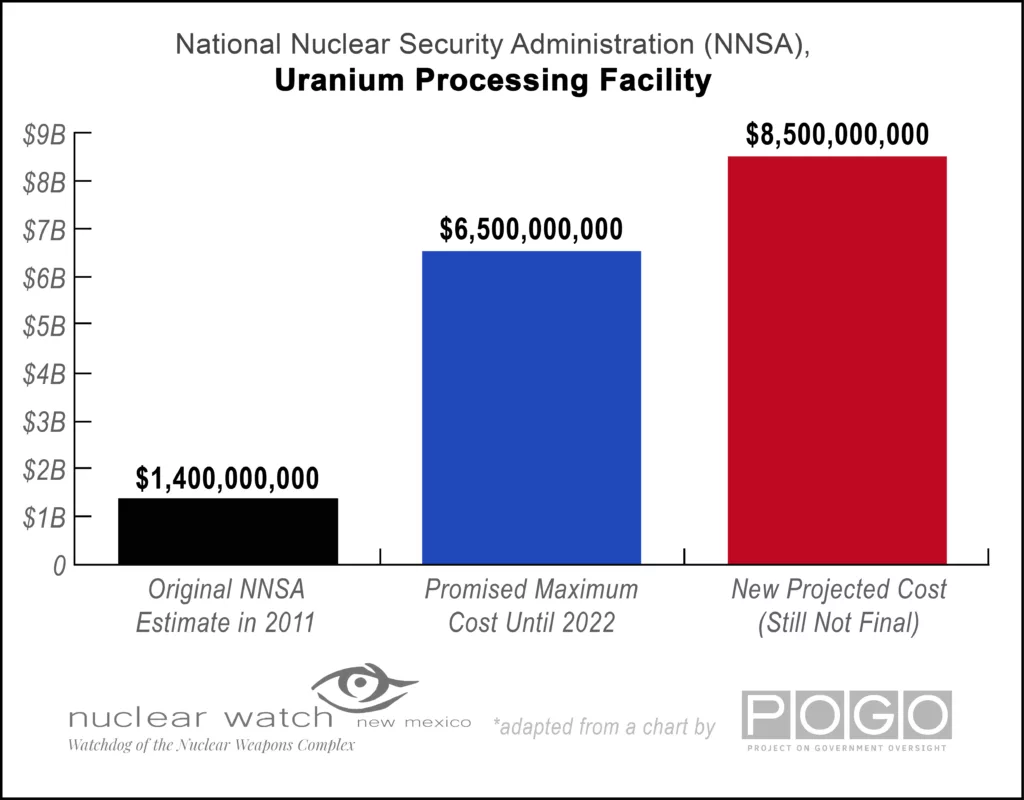 A current example is the Uranium Processing Facility (UPF) at the Y-12 Plant near Oak Ridge, Tennessee, originally estimated in 2011 to cost $1.4 to $3.5 billion. After costs started going through the roof, NNSA and Senator Lamar Alexander (R.-TN), then-chair of Senate Energy and Water Appropriations, swore that UPF would never go over $6.5 billion. But even after eliminating non-nuclear weapons production missions and a formal decision to continue operations at two old, unsafe buildings slated for replacement, the Uranium Processing Facility is now estimated to cost $8.5 billion. However, even that is not the final price, as NNSA is still to “rebaseline” UPF costs at some unspecified date.
A current example is the Uranium Processing Facility (UPF) at the Y-12 Plant near Oak Ridge, Tennessee, originally estimated in 2011 to cost $1.4 to $3.5 billion. After costs started going through the roof, NNSA and Senator Lamar Alexander (R.-TN), then-chair of Senate Energy and Water Appropriations, swore that UPF would never go over $6.5 billion. But even after eliminating non-nuclear weapons production missions and a formal decision to continue operations at two old, unsafe buildings slated for replacement, the Uranium Processing Facility is now estimated to cost $8.5 billion. However, even that is not the final price, as NNSA is still to “rebaseline” UPF costs at some unspecified date.
U.S. Strategic Posture Commission Ratchets Up Nuclear Arms Race
FOR IMMEDIATE RELEASE, October 12, 2023
Jay Coghlan – 505.989.7342 | Email
Santa Fe, NM – Today, America’s Strategic Posture, The Final Report was released by the Congressional Commission on the Strategic Posture of the United States. In its own words:
“The Congressional Commission on the Strategic Posture of the United States was established by the Fiscal Year (FY) 2022 National Defense Authorization Act (NDAA), and concludes that America’s defense strategy and strategic posture must change in order to properly defend its vital interests and improve strategic stability with China and Russia. Decisions need to be made now in order for the nation to be prepared to address the threats from these two nuclear-armed adversaries arising during the 2027-2035 timeframe. Moreover, these threats are such that the United States and its Allies and partners must be ready to deter and defeat both adversaries simultaneously.”
Los Alamos Lab’s Future at a Crossroads: Cleanup or More Nuclear Weapons? NukeWatch Applauds NM State Rejection of Fake Cleanup
FOR IMMEDIATE RELEASE, September 18, 2023
Jay Coghlan – 505.989.7342, c 505.470.3154 | Email
Scott Kovac – c. 505.316.4148 | Email
Santa Fe, NM – In an important win for genuine cleanup at the Los Alamos National Laboratory (LANL), the New Mexico Environment Department (NMED) has rejected the Lab’s plans for so-called cleanup through “cap and cover.” LANL’s plan would leave existing radioactive and toxic wastes uncharacterized and forever buried in unlined pits and trenches as a permanent threat to groundwater. At issue is remediation of the Lab’s “Material Disposal Area C” waste dump that has 7 pits and 108 shafts of radioactive and toxic wastes. Area C is located in the heart of nuclear weapons production at LANL, contiguous to the Lab’s main plutonium facility which is expanding production of plutonium “pit” bomb cores.
In a September 7, 2023 “Public Notice of Statement of Basis,” the Environment Department ruled:
“For maximum protection of human health and the environment and to ensure that the drinking water resource can be conservatively protected, NMED has determined that the selected [cleanup] remedy for MDA C must consist of waste excavation, characterization, and appropriate disposal of the buried waste… Excavation will ensure that the source of contamination at MDA C is removed…”
Oppenheimer’s Legacy: South Carolina at the Center of the New Nuclear Arms Race 8/16/23
Learn about the role of the U.S. Department of Energy – and the Savannah River Site in South Carolina particular – in production of plutonium “pits” for new nuclear weapons as a key part of the new nuclear arms race from this August 16, 2023 event: https://www.youtube.com/watch?v=ZK9YOFoT6r0
Plutonium Detections From Trinity Test Discovered 78 years After Test – Confirm RECA Must Be Expanded
FOR IMMEDIATE RELEASE, July 31, 2023
Tina Cordova, Tularosa Basin Downwind Consortium – 505.897.6787 | Email
Dr. Michael E. Ketterer – 928.853.7188 | Email
Scott Kovac, Nuclear Watch New Mexico – 505.989.7342 | Email
Santa Fe, NM – New preliminary information strongly supports Radiation Exposure Compensation Act (RECA) status for New Mexicans downwind of the Trinity Test Site. In the past weeks, Michael E. Ketterer, (Professor Emeritus, Chemistry and Biochemistry, Northern Arizona University, Flagstaff, AZ) has completed a short “proof of principle” study that directly investigates where plutonium in soils originates by analyzing isotopic ratios, in a known portion of the Trinity Test plume.
Dr. Ketterer sampled soils along highways NM 42, US 54, NM 55, US 60, and US 380. The isotopes show that there is definitely plutonium from the Trinity Test in the northeast plume, and distinguishes it from global (stratospheric) background and New Mexico regional background from Nevada Test Site fallout. Soils along all five of these highways contain plutonium that reflects mixtures of Trinity Test debris and global/Nevada regional background fallout; in some cases, nearly 100% of the Pu originates from the Trinity Test.
While Dr. Ketterer has not encountered any activities (expressed as Bq/kg or pCi/g, Becquerels or picocuries respectively) of plutonium that cause alarm from the radio-toxicity standpoint, there’s very limited data.
Nuclear Weapons Today – Peril and Promise, with Jay Coghlan and Ralph Hutchison

Nuclear Weapons Today – Peril and Promise, with Jay Coghlan and Ralph Hutchison: https://www.youtube.com/watch?v=P_0aqUG9hmw&t=15s
Biden Releases Record NNSA Nuclear Weapons Budget
FOR IMMEDIATE RELEASE, March 14, 2023
Jay Coghlan – 505.989.7342 | Email | Scott Kovac – 505.989.7342 | Email
Santa Fe, NM – President Biden has released his proposed FY 2024 budget for the Department of Energy’s semi-autonomous nuclear weapons agency, the National Nuclear Security Administration (NNSA). The budget for NNSA’s “Total Weapons Activities” for nuclear weapons research and production programs is slated to increase by 10% to $18.8 billion.
Of that $18.8 billion requested for FY 2024, over $3 billion is devoted to “Life Extension Programs” or “Alterations” that extend the service lives of existing nuclear weapons by decades while giving them new military capabilities. It also includes two new-design nuclear weapons, the W87-1 ICBM warhead (increased 50% to $1 billion) and the sub-launched W93 warhead (increased 62% to $390 million). Meanwhile, funding for dismantlements that provide a good nonproliferation example and save taxpayers’ money by eliminating long-term security costs is decreased by 4% to $53.7 million. That is a small fraction of one percent of NNSA’s Total Weapons Activities.
Two bright spots, yet still small relative to the U.S.’ planned $2 trillion nuclear weapons “modernization” program, are the zeroing out of funding for the Sea-Launched Cruise Missile (SLCM) warhead and stronger language on the retirement of the 1.2 megaton B83 bomb. Trump proposed to bring back nuclear-armed sea-launched cruise missiles, which were retired by President George H. Bush after the end of the Cold War. Biden’s 2022 Nuclear Posture Review canceled the SLCM, but Congress insisted on funding it, which will only grow stronger with Republican control the House.
In Response to Lawsuit, NNSA Releases FY 2022 Performance Evaluation Reports as “Frequently Requested Documents” as Required by FOIA; Reveals Pit Production Schedule is Likely Increasingly Delayed
FOR IMMEDIATE RELEASE, March 9, 2023
Jay Coghlan – 505.989.7342 | Email | Scott Kovac – 505.989.7342 | Email
Santa Fe, NM – Today, the National Nuclear Security Administration[1] (NNSA) finally posted its FY 2022 Performance Evaluation Reports to its electronic “FOIA Reading Room.” These reports are “Frequently Requested Documents” as defined by the Freedom of Information Act (meaning three or more requests) and are therefore required to be posted under the law. The catalyst for this was a lawsuit filed by Nuclear Watch New Mexico in September 2022.
NNSA’s Performance Evaluation Reports for its eight nuclear weapons research and production sites[2] grade annual contractor performance and award performance fees accordingly. Approximately 57,000 people are employed by the NNSA nuclear weapons complex, 95% of them contractor personnel. The Department of Energy and NNSA (or its predecessor DOE Defense Programs) have been on the independent Government Accountability Office’s “High Risk List” for project mismanagement and waste of taxpayers’ dollars since 1992.
ALLIANCE FOR NUCLEAR ACCOUNTABILITY MEDIA ADVISORY: WHAT TO LOOK FOR IN THE U.S. DEPARTMENT OF ENERGY’S FY 2024 NUCLEAR WEAPONS AND CLEANUP BUDGET REQUEST
Alliance for Nuclear Accountability | March 8, 2023 ananuclear.org
The Biden Administration is releasing its Fiscal Year 2024 federal budget on Thursday, March 9. It is expected to be a “skinny budget” with just topline financial numbers. If the pattern of the last few years for the Department of Energy’s (DOE’s) budget is continued, there can be three more releases over the next six weeks that grow progressively more detailed (there is initially little if any site-specific budget information). Historically around 60% of DOE’s funding has been earmarked for nuclear weapons production and cleanup of Cold War wastes and contamination.
The release of the presidential budget begins the annual legislative process for funding DOE programs and sites. The two bicameral congressional subcommittees that have jurisdiction over the DOE budget are the Armed Services Committee Strategic Forces Subcommittee which “authorizes” funding, and the Energy and Water Development Appropriations Subcommittee which actually provides funding. Congress has managed to pass the Defense Authorization Act for more than 50 consecutive years, but is increasingly unable to pass appropriations bills, leading to short-term Continuing Resolutions (CRs). Given bipartisan friction and the beginning of election campaigning, Continuing Resolutions are likely for this coming federal fiscal year 2024, which begins October 1, 2023.
The Alliance for Nuclear Accountability strongly opposed the massive 25% FY 2021 increase that the Trump Administration gave to the nuclear weapons programs of DOE’s semi-autonomous National Nuclear Security Administration (NNSA). The Biden Administration not only kept Trump’s increases in subsequent budgets but substantially added to them, particularly for expanded production of plutonium “pit” bomb cores for nuclear weapons. Meanwhile, dismantlements of nuclear warheads have slowed to a crawl and funding for cleanup of Cold War radioactive and hazardous wastes has remained flat.
DOE’s nuclear weapons and environmental management programs have been on the Government Accountability Office’s “High Risk List” for project mismanagement and waste of taxpayers’ dollars for more than 30 consecutive years. Defense Department and DOE costs for so-called “modernization” of U.S. nuclear forces begun under Obama is expected to be around $2 trillion over the next 30 years.
State Environment Department Begins to Rein in Work On LANL’s Chromium Plume Given Major Differences With DOE
FOR IMMEDIATE RELEASE, February 21, 2023 | Scott Kovac – 505.989.7342 | Email
At a February 9, 2023 public community forum hosted by the Department of Energy’s Environmental Management Los Alamos Office, there were strong indications that the New Mexico Environment Department (NMED) is convinced that DOE’s plans to remediate the chromium groundwater contamination plume under Los Alamos National Laboratory (LANL) is not working. Kimberly Lebak, program manager for N3B, the LANL cleanup contractor, described how it is finalizing the 2023 milestones under the Consent Order that governs cleanup, despite the fact that the NMED Groundwater Bureau has requested that DOE stop injecting treated water by April 1, 2023. DOE and NMED are not seeing eye-to-eye concerning the “Interim Measure” that N3B is using to contain the chromium plume.
The two agencies disagree on the Interim Measure, originally designed to prevent chromium from migrating across the San Ildefonso Pueblo border while DOE tries to figure out a final remedy.
District Court Denies Department of Energy’s Motion to Dismiss Plutonium Pits Suit
FOR IMMEDIATE RELEASE, February 13, 2023 | South Carolina Environmental Law Project, Savannah River Site Watch, Nuclear Watch New Mexico, Tri-Valley CAREs, Gullah/Geechee Sea Island Coalition
AIKEN, S.C. — In a win for public participation and environmental protection, the United States District Court of South Carolina denied the Department of Energy’s motion to dismiss a 2021 legal action filed by multiple citizen groups. The suit was prompted by the agencies’ failure to take the “hard look” required by the National Environmental Policy Act at their plans to more than quadruple the production of plutonium pits for new nuclear weapons and split their production between the Los Alamos National Laboratory and the Savannah River Site.
In her ruling, Judge Mary Geiger Lewis thoroughly rejected the defendants’ arguments that the plaintiffs lacked standing, saying it was “not a close call”.
“We were able to defeat yet another attempt to use standing as a weapon to keep members of the public out of the government’s decision-making process,” said Leslie Lenhardt, Senior Managing Attorney at the South Carolina Environmental Law Project (SCELP).
To date, the Department of Energy (DOE) has refused to fully examine the environmental and safety impacts of their cross-country plan, which would create massive quantities of dangerous and radioactive material, put hundreds of billions of taxpayer dollars on the line, risk a new nuclear arms race, and violate the nation’s foundational environmental law.
Top Environment Official Takes Inside Info to Nuclear Weapons Agency, Gets Puny Slap-on-Wrist for Ethical Violation; Governor Should Enforce State Code of Conduct
FOR IMMEDIATE RELEASE, February 8, 2023 | Joni Arends, Concerned Citizens for Nuclear Safety – 505.986.1973 | Email
Jay Coghlan – 505.989.7342 | Email
Santa Fe, NM – The Department of Energy (DOE) will spend $9.4 billion dollars in New Mexico during this fiscal year 2023, 10% more than the State’s entire operating budget of $8.5 billion. To help enable its agenda of expanding nuclear weapons production that will cause more radioactive wastes and contamination, the DOE’s semi-autonomous National Nuclear Security Administration (NNSA) or its contractors often go head hunting for top State officials.
The New Mexico Environment Department (NMED) has sued DOE over the slow pace of cleanup at the Los Alamos National Laboratory (LANL). Stephanie Stringer, former Deputy Cabinet Director (the number two position at NMED), applied to work for NNSA in August 2022, and resigned to take that job in November. During that time, she was privy to NMED litigation strategy against DOE and chaired the New Mexico Water Quality Control Commission that denied a citizens’ motion against one of LANL’s most crucial facilities for expanding plutonium pit production, the Radioactive Liquid Waste Treatment Facility. As a result, the New Mexico Ethics commission fined Stringer a paltry $250. Assuming that Stringer is earning at least $100,000 base salary in her new position, that fine would have cost her approximately five hours of her time.
Comment on the Lawrence Livermore National Laboratory Draft Site-Wide Environmental Impact Statement
Nuclear Watch New Mexico January 21, 2023 | Email
Via email to: LLNLSWEIS@nnsa.doe.gov
Ms. Fana Gebeyehu-Houston,
LLNL SWEIS Document Manager,
1000 Independence Ave., SW, Washington, DC 20585
Dear Ms. Fana Gebeyehu-Houston:
Thank you for the opportunity to comment on the National Nuclear Security Administration’s (NNSA) Draft Site-Wide Environmental Impact Statement (SWEIS) for the continued operation of the Lawrence Livermore National Laboratory Main Site in Livermore, CA and Site 300 high explosives testing range near Tracy, CA.
Nuclear Watch New Mexico takes particular interest in the Livermore Lab as the sister lab of the Los Alamos National Laboratory (LANL). We have long been involved in the issue of plutonium pit production at LANL. We see the two labs as inextricably linked given that LANL will be producing plutonium pits for the new W87-1 warhead, for which LLNL is the lead design agency.
Our mission statement: Nuclear Watch New Mexico seeks to promote safety and environmental protection at nuclear facilities; mission diversification away from nuclear weapons programs; greater accountability and cleanup in the nation-wide nuclear weapons complex; and consistent U.S. leadership toward a world free of nuclear weapons.
NukeWatch DNFSB 2022 Hearing Comments 1-20-23
Nuclear Watch New Mexico January 20, 2023 | Email
Defense Nuclear Facilities Safety Board
625 Indiana Avenue NW, Suite 700
Washington, DC 20004
Via email at <hearing@dnfsb.gov>
Re: Comments concerning the November 16, 2022 public hearing regarding legacy cleanup activities, nuclear safety, and increased production activities at the Los Alamos National Laboratory
Dear Safety Board:
Nuclear Watch New Mexico (NukeWatch) appreciates the opportunity to provide follow up written comments for the November 16, 2022 public hearing in Santa Fe, NM. We want to thank the Board for its continuing concern over Los Alamos National Laboratory (LANL) safety issues and for having a public hearing to begin with. Further, we are grateful for the DNFSB’s perseverance in the face of the Department of Energy’s arguably illegal attempts to restrict its access. We look forward to many more years of the Safety Board’s insights and recommendations on nuclear facilities at DOE and NNSA sites, for which the DNFSB is uniquely positioned. Your service is invaluable and irreplaceable. Thank you!
Our mission statement: Nuclear Watch New Mexico seeks to promote safety and environmental protection at nuclear facilities; mission diversification away from nuclear weapons programs; greater accountability and cleanup in the nation-wide nuclear weapons complex; and consistent U.S. leadership toward a world free of nuclear weapons.
PLUTONIUM PIT PRODUCTION BRIEFING
Jay Coghlan, Nuclear Watch New Mexico January 17, 2023 | Email
GAO report: NNSA Does Not Have a Comprehensive Schedule or Cost Estimate for Pit Production Capability, January 12, 2023, gao.gov/products/gao-23-104661
- “NNSA’s Plutonium Pit Production Scope of Work Includes Dozens of Programs, Projects, and Other Activities Managed by Multiple NNSA Offices at Multiple Sites.” p. 19
- “NNSA Does Not Have a Comprehensive Schedule or Cost Estimate for Establishing its Pit Production Capability.” p. 40
- They [NNSA officials] said they did not want to introduce uncertainty about dates and wanted to avoid releasing preliminary or unpalatable information that was subject to change.” pp. 40-41
- “NNSA will have spent billions of dollars without having an overall idea of total program costs, or when program objectives, to include the capability to produce 80 pits per year, will be reached.” pp. 55-56
Independent Government Accountability Office Releases Scathing Report on Expanding Plutonium Pit Production; Pressure Mounts on Los Alamos Lab to Increase Production
FOR IMMEDIATE RELEASE, January 12, 2023 | Jay Coghlan – 505.989.7342 | Email
Santa Fe, NM – Today, the independent Government Accountability Office (GAO) released a scathing report entitled NNSA Does Not Have a Comprehensive Schedule or Cost Estimate for Pit Production Capability. The National Nuclear Security Administration (NNSA) and its parent Department of Energy have been on the GAO’s High Risk List for project mismanagement since 1991.
Plutonium pits are the essential radioactive cores of nuclear weapons. There has been only limited production at the Los Alamos National Laboratory (LANL) since 1989 when a FBI raid investigating environmental crimes abruptly shut down production at the Rocky Flats Plant near Denver. NNSA now plans to spend $2.9 billion in FY 2023 alone to establish production of at least 30 pits per year at LANL and 50 pits per year at the Savannah River Site (SRS) in South Carolina.
The two main findings of GAO’s report are:
- NNSA’s Plutonium Pit Production Scope of Work Includes Dozens of Programs, Projects, and Other Activities Managed by Multiple NNSA Offices at Multiple Sites (p 19)
New Mexico’s Revolving Nuclear Door: Top Environment Officials Sell Out to Nuclear Weapons Labs
FOR IMMEDIATE RELEASE, November 28, 2022 |
Jay Coghlan, 505.989.7342 jay@nukewatch.org
Santa Fe, NM – As part of a long, ingrained history, senior officials at the New Mexico Environment Department (NMED) have repeatedly resigned to go to work for the nuclear weapons labs, the Department of Energy, or DOE contractors. In a number of cases that is where they came from to begin with.
The hierarchy of leadership at NMED starts with the Secretary, Deputy Secretaries and then Division Directors. The position of Resource Protection Division Director is particularly critical because it oversees the two NMED bureaus most directly involved with DOE facilities in New Mexico, the Hazardous Waste Bureau and the DOE Oversight Bureau. However, all four former or current Resource Protection Division Directors have gone or are going to work for the nuclear weapons labs, the DOE or its contractors. They are:
- Chris Catechis, currently Acting Resource Protection Division Director, is reportedly assuming a job at the Los Alamos National Laboratory (LANL) within days. Prior to NMED he had worked at the Sandia National Laboratories for 22 years.[i] See https://www.linkedin.com/in/chris-catechis-ma-b76b1a8/
- Catechis’ immediate supervisor Stephanie Stringer resigned October 31 to go to work for DOE’s semi-autonomous nuclear weapons agency, the National Nuclear Security Administration (NNSA). She was Resource Protection Division Director prior to being promoted to Deputy Cabinet Secretary for Operations (second only to NMED Secretary James Kenney).
Questionable Department of Energy benefits to New Mexico:
• DOE plans to spend $9.4 billion in New Mexico during this fiscal year 2023, 71% for nuclear weapons research and production while much of the rest is for related radioactive waste disposal. This is 10% more than the State’s entire operating budget of $8.5 billion. Forty-one percent of the National Nuclear Security Administration’s nation-wide FY 2023 nuclear weapons research and production budget will be spent in the Land of Enchantment alone(1).
• How does this really benefit New Mexicans when the Land of Enchantment:
- Has the third highest rate of poverty (18.2%) after Mississippi and Louisiana(2);
- Is fourth lowest in per capita income in 2022, 3 down from 37th in 1959; and
- Is ranked 46th in best states to live in, according to five criteria (affordability, economy, education and health, quality of life, and safety),4 dead last in quality of education(5) and dead last in quality of life for children?(6)
• At the same time, Los Alamos County is the 11th richest county in the USA(7), has the most millionaires per capita (11.6%)(8), and has been ranked the best county to live in(9). Clearly the economic benefits are for a privileged minority of the New Mexican population.
Biden’s Nuclear Posture Review Fuels the New Nuclear Arms Race
FOR IMMEDIATE RELEASE, October 27, 2022 |
Jay Coghlan, 505.989.7342 jay@nukewatch.org
Santa Fe, NM– Today, the Biden Administration has released its long awaited unclassified Nuclear Posture Review. It headlines a “Comprehensive, balanced approach to defending vital national security interests and reducing nuclear dangers.” It also declares that “deterrence alone will not reduce nuclear dangers.”
“Deterrence” against others has always been the publicly sold rationale for the United States’ nuclear weapons stockpile. First, there is the inconvenient fact that the U.S. was the first and only to use nuclear weapons in war. But secondly, the United States and the USSR (now Russia) never possessed their huge stockpiles for the sole purpose of deterrence anyway. Instead, their nuclear weapons policies have always been a hybrid of deterrence and nuclear war fighting, which threatens global annihilation to this very day.
As a pertinent example, after the Obama Administration released its 2010 Nuclear Posture Review, the Defense Department declared that, “…[t]he new guidance requires the United States to maintain significant counterforce capabilities against potential adversaries. The new guidance does not rely on a ‘counter-value’ or ‘minimum deterrence’ strategy.”[1] In simple language, that means nuclear war-fighting that could end civilization should deterrence fail, or even possible first strike. That is why we have thousands of nuclear weapons instead of just the few hundred needed for only deterrence. That is why we have the massive, $1.7 trillion “modernization” program that will keep nuclear weapons forever, for which Biden’s Nuclear Posture Review gives added policy foundation.
FULL PRESS RELEASE [PDF]
Scoping Comments to the National Nuclear Security Administration On the Los Alamos National Laboratory Site-Wide Environmental Impact Statement
A Reduced Operations Alternative is not only a reasonable alternative but is in the actual best interests of the nation.
Such an alternative would best preserve stockpile reliability by foregoing production of new pits that may deviate from tested designs; conservatively maintain the existing, extensively tested nuclear weapons stockpile; augment and accentuate nonproliferation programs, especially the development of monitoring and verification technologies that could help underpin a future world free of nuclear weapons; and augment and accentuate cleanup programs that are truly comprehensive, permanently eliminating the threat to groundwater.
October 18, 2022
LANL SWEIS COMMENTS
NNSA Los Alamos Field Office
3747 W. Jemez Road
Los Alamos, NM 87544
Via lanlsweis@nnsa.doe.gov
Dear National Nuclear Security Administration:
Nuclear Watch New Mexico hereby submits these scoping comments on the new Los Alamos National Laboratory (LANL) Site-Wide Environmental Impact Statement (SWEIS).
Executive Summary
First, NNSA should complete a new nation-wide programmatic environmental impact statement on expanded plutonium pit production. A new LANL Site-Wide Environmental Impact Statement should then be “tiered” off of that document and address all of these issues outlined in these scoping comments, and in particular the site-specific impacts of expanded plutonium pit production. In the event that NNSA continues its arguably illegal behavior in not completing a new PEIS, a new draft LANL SWEIS should nevertheless analyze the issues outlined in these scoping comments, particularly expanded plutonium pit production.
Continue reading
EDIT & SUBMIT TODAY! YOUR COMMENTS COUNT!! SAMPLE COMMENTS FOR SCOPING THE LANL SWEIS: Formal Scoping Comment to the National Nuclear Security Administration on the Los Alamos Lab Site-Wide Environmental Impact Statement
October xxxx, 2022
Via LANLSWEIS@nnsa.doe.gov
Dear National Nuclear Security Administration:
Pursuant to National Environmental Policy Act (NEPA) requirements, the following issues should be analyzed and considered within the scope of the new Site-Wide Environmental Impact Statement for Continued Operations of the Los Alamos National Laboratory.
The last Los Alamos National Laboratory (LANL) Site-Wide Environmental Impact Statement (SWEIS) was completed in 2008 and is badly outdated. Since 2018 the National Nuclear Security Administration (NNSA), the Department of Energy’s semi-autonomous nuclear weapons agency, has been aggressively expanding the production of plutonium “pit” bomb cores for nuclear weapons at the Lab.
On August 19, 2022, NNSA finally announced its intent to prepare a new LANL SWEIS, but apparently the agency will not address expanded plutonium pit production.[1] NNSA’s legally dubious claim is that it performed the required NEPA analysis for expanded plutonium pit production in a 2008 Complex Transformation Programmatic Environmental Impact Statement, the 2008 LANL SWEIS and a woefully inadequate “Supplement Analysis” of the 2008 SWEIS completed in 2020. This last document concluded that a new SWEIS was not needed, after which NNSA issued an Amended Record of Decision expanding plutonium pit production at LANL to at least 30 pits per year.[2]
Watchdogs File Suit for NNSA’s Performance Evaluation Reports
FOR IMMEDIATE RELEASE, September 15, 2022 |
Jay Coghlan, 505.989.7342 jay@nukewatch.org
Santa Fe, NM – Today, Nuclear Watch New Mexico has once again filed a lawsuit to pry loose the National Nuclear Security Administration’s (NNSA’s) full and complete Performance Evaluation Reports that evaluate contractor performance at its eight nuclear weapons sites. Approximately 57,000 people are employed by NNSA’s nuclear weapons production complex, 95% of them contractor personnel. NNSA and its parent Department of Energy have been on the independent Government Accountability Office’s “High Risk List” for project mismanagement and waste of taxpayers’ dollars since 1992.
NNSA’s Performance Evaluation Reports grade contractor performance, award performance fees and contain no classified information. Nevertheless, NNSA seeks to hide how taxpayers’ money is spent from the public, issuing only terse three page summaries instead of the full and complete Reports. Nuclear Watch sued in 2012 to obtain the full and complete Performance Evaluation Reports, after which NNSA started releasing them within three working days. But NNSA has again been releasing only summaries since 2019, despite a Freedom of Information Act request by Nuclear Watch that the agency never responded to.
To illustrate the importance of these Performance Evaluation Reports, in its FY 2021 Los Alamos Lab summary NNSA noted that the contractor “[s]ucessfully made advances in pit production processes…” Plutonium “pits” are the fissile cores of nuclear weapons whose expanded production the Pentagon has identified as the number one issue in the United States’ $2 trillion nuclear weapons “modernization” program. NNSA has directed the Los Alamos National Laboratory (LANL) to begin producing at least 30 pits per year by 2026 and the Savannah River Site (SRS) in South Carolina to begin producing at least 50 pits per year by 2030.
NNSA Finally Starts Overdue Los Alamos Lab Environmental Study for Nuclear Weapons Programs That Are Already Underway
FOR IMMEDIATE RELEASE, August 18, 2022 |
Contact: Scott Kovac, 505.989.7342 scott@nukewatch.org | Jay Coghlan, 505.989.7342 jay@nukewatch.org
Santa Fe, NM – Today, the National Nuclear Security Administration (NNSA), the semi-autonomous nuclear weapons agency with the Department of Energy, released a Notice of Intent to Prepare a Site-Wide Environmental Impact Statement for Continued Operation of the Los Alamos National Laboratory.
In its formal notice, NNSA avoids mentioning the elephant in the room, the already predetermined expanded production of plutonium “pits,” the radioactive cores of nuclear weapons. This is in direct contradiction to the National Environmental Policy Act’s requirement that federal agencies take a “hard look” at proposed actions before implementation.
Moreover, future pit production is not to maintain the safety and reliability of the existing stockpile, but instead is for speculative, untested new-design nuclear weapons for the accelerating nuclear arms race. The Los Alamos National Laboratory (LANL) is already spending billions of taxpayers’ dollars to upgrade plutonium facilities and hire more workers for more weapons of mass destruction. This site-wide EIS is a “check off the box” exercise for all the major changes since the last site-wide EIS in 2008. Since then the Lab has fundamentally changed into a nuclear weapons production site as its main mission.
The Department of Energy boosted Lab funding to $4.6 billion in FY 2023 (21% higher than FY 2022), which begins this coming October 1. Of that, $3.6 billion is slated for NNSA’s core nuclear weapons research and production programs, with expanded plutonium pit production taking the biggest slice of the pie at $1.63 billion. The percentage of nuclear weapons funding at LANL has steadily grown as the Lab increasingly banks its future on being a nuclear weapons production site. Today it is 73% of total institutional funding. country.
The Need for Independent Pit Aging Studies
June 16, 2022 | FACT SHEETS
Summary: The United States is aggressively expanding the production of plutonium “pit” bomb cores to at least 80 pits per year, which the Pentagon has called the number one issue in its $1.7 trillion plan to “modernize” nuclear forces. The average age of plutonium pits is around 40 years. Los Alamos Lab Director Thom Mason has said that “The best way to deal with this dilemma [of uncertainty about aging effects] is to take it off the table. We do that by making new pits, immediately.” Thus, he justifies spending tens of billions of dollars, creating additional occupational and public risks, generating more radioactive wastes with uncertain disposal pathways, fundamentally transforming the Lab into a nuclear weapons production site and fueling the increasingly dangerous new nuclear arms race.
But does independent review of pit aging data support this need to immediately produce new pits? The answer is no given that independent experts concluded in 2006 that pits last at least a century with no determined end date. Further, no future pit production is scheduled to maintain the safety and reliability of the existing nuclear weapons stockpile – it is all for speculative new designs which could raise reliability issues or even prompt the U.S. to resume testing.
Why Funding for the SLCM Nuclear Warhead Should Be Deleted
June 6, 2022 | FACT SHEETS
Introduction: In 1991, in response to the ongoing collapse of the Soviet Union, President George H. Bush ordered the withdrawal of all nuclear-armed sea-launched cruise missiles (SLCMs) from U.S. surface ships and submarines. In 2018 President Trump’s Nuclear Posture Review proposed to redeploy SLCMs on Virginia-class attack submarines, saying they would provide the United States with “a needed non-strategic regional presence” that would address “the increasing need for flexible and low-yield options.”1 Congress subsequently approved $15.2 million in FY 2022 funding for the Navy’s new cruise missile and nuclear warhead.
In March 2022 President Biden transmitted a new classified Nuclear Posture Review to Congress that reportedly canceled the Sea-Launched Cruise Missile. In parallel, his proposed FY 2023 budget for the National Nuclear Security Administration (NNSA) has no funding for the SLCM nuclear warhead. This has prompted some congressional pushback, with one suggested compromise being continuing modest research funding. But as a Congressional Research Service analysis put it: “The Navy indicated that the program was “cost prohibitive and the acquisition schedule would have delivered capability late to need.”
Billions of Taxpayer Dollars to be Spent on Plutonium Pit Production – NNSA Chooses Speed Over Safety, Condones Potential Lethal Radioactive Doses to Public
FOR IMMEDIATE RELEASE, April 22, 2022 |
Contact: Scott Kovac, 505.989.7342 scott@nukewatch.org | Jay Coghlan, 505.989.7342 jay@nukewatch.org
Santa Fe, NM – The National Nuclear Security Administration (NNSA), the semi-autonomous nuclear weapons agency with the Department of Energy, is no longer pursuing a safety class active confinement system at PF-4, the Los Alamos National Laboratory’s plutonium pit manufacturing facility. This is a long-running battle between the independent Defense Nuclear Facilities Safety Board (DNFSB) and NNSA.
The Safety Board has strongly recommended active confinement systems since 2004, reporting that they “will continue to function during an accident, thereby ensuring that radioactive material is captured by filters before it can be released into the environment.” [i] However, a few years ago NNSA tried to kill the messenger by seriously restricting DNFSB access to NNSA nuclear facilities across the country.
New Mexico: Number One in Nuclear Weapons and Radioactive Wastes Near Last in Citizen and Child Well-Being
FOR IMMEDIATE RELEASE, April 19, 2022 |
Contact: Jay Coghlan, 505.989.7342, jay@nukewatch.org
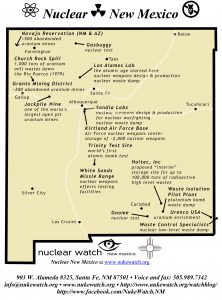
Santa Fe, NM – According to budget documents just released by the Department of Energy, DOE facilities in New Mexico will receive $9.4 billion in FY 2023, substantially larger than the state’s entire operating budget of $8.5 billion. Seventy-one percent ($6.7 billion) will be for core nuclear weapons research and production programs under the DOE’s semi-autonomous nuclear weapons agency, the National Nuclear Security Administration (NNSA). That is 40.5% of the NNSA’s total nation-wide nuclear weapons budget of $16.5 billion. It is also double that of the next closest state, since the Land of Enchantment has two of the nation’s three nuclear weapons laboratories (the Los Alamos and Sandia National Laboratories). Both of these Labs are within the Roman Catholic Archdiocese of Santa Fe, whose Archbishop John Wester has echoed Pope Francis’ call for the abolition of nuclear weapons.
In contrast, the goal of NNSA programs in New Mexico is to indefinitely extend the service lives of existing nuclear weapons while giving them new military capabilities. This will be followed by completely new nuclear weapons that cannot be tested given the global testing moratorium. Alternatively, it could prompt the U.S. back into nuclear weapons testing, which would have serious international proliferation implications. NNSA’s claimed rationale is “deterrence” which requires only a few hundred nuclear weapons. In reality the U.S. and Russia each have thousands of ready-to-launch weapons for nuclear war-fighting that would result in global catastrophe, no longer so hypothetical since Russia’s invasion of Ukraine.
Los Alamos Lab: More Plutonium, More Nuclear Weapons
FOR IMMEDIATE RELEASE, April 18, 2022 | Contact: Jay Coghlan, 505.989.7342, jay@nukewatch.org, Scott Kovac, 505.989.7342, scott@nukewatch.org,
Santa Fe, NM – On Good Friday afternoon, just before the Easter weekend, the Department of Energy (DOE) posted its “Laboratory Tables”, the best source for site specific budget information. DOE boosts funding for the Los Alamos National Laboratory (LANL) to $4.6 billion in FY 2023 (+21%), which begins October 1. With another typical $300 million in “Work for Others” (the Defense Department, FBI, CIA, etc.), LANL’s total institutional funding for FY 2023 will be approximately $4.9 billion.
Out of that, $3.6 billion is slated for core nuclear weapons research and production programs. The percentage of nuclear weapons funding at LANL has steadily grown as the Lab increasingly banks its future on plutonium “pit” bomb core production. A decade ago, nuclear weapons programs were 59% of LANL’s total institutional budget. Today it is 73%. Moreover, the remainder of Lab programs (including nonproliferation and cleanup) either directly or indirectly support nuclear weapons programs, for example through a 6% internal tax for “laboratory-directed research and development” that has historically tilted towards nuclear weapons.
LANL’s largest funding increase is for “Plutonium Modernization”, jumping 61% to $1.6 billion in FY 2023. Within that, funding to expand the production of plutonium “pit” bomb cores at LANL’s aging plutonium pit production facility is increased 68% to $588 million.
Biden’s FY 2023 Budget Fuels New Nuclear Arms Race
FOR IMMEDIATE RELEASE, April 12, 2022 | Contact: Jay Coghlan, 505.989.7342, jay@nukewatch.org, Scott Kovac, 505.989.7342, scott@nukewatch.org,
Santa Fe, NM – The Biden Administration is slow rolling its nuclear weapons budget for the federal fiscal year 2023, which will begin October 1, 2022. Top line budget numbers released on March 24 showed that Biden is increasing the National Nuclear Security Administration’s (NNSA’s) budget category for “Total Weapons Activities” by 7.4% to $16.5 billion. That may seem like a relatively modest increase, especially given accelerating inflation.
However, huge increases in specific programs have now been disclosed in an obscure budget chart entitled “Comparative Appropriation by Congressional Control FY 2023.” These NNSA programs are the tip of the spear in the United States’ $1.7 trillion nuclear weapons “modernization” program. It will rebuild every nuclear warhead in the planned stockpile with new military capabilities; design and manufacture new-design nuclear weapons as well; construct new production plants expected to be operational until the 2080’s; and procure at enormous taxpayers’ expense new missiles, subs and bombers to deliver these weapons of mass destruction. It is, in short, a program of nuclear weapons forever.
NukeWatch Lawsuit Settlement Speeds Up Cleanup at Los Alamos Lab
FOR IMMEDIATE RELEASE, March 23, 2022 | Contact: Jay Coghlan, 505.989.7342, jay@nukewatch.org, Scott Kovac, 505.989.7342, scott@nukewatch.org,
Santa Fe, NM – Today, Nuclear Watch New Mexico is announcing successful settlement of a lawsuit it brought against the Department of Energy (DOE) over its slow cleanup of the Los Alamos National Laboratory (LANL). The watchdogs’ lawsuit alleged violations of a 2005 Consent Order, which was a site-wide cleanup agreement between the New Mexico Environment Department (NMED) and DOE to address radioactive and toxic wastes at the Lab. NMED has since sued DOE to terminate a revised 2016 Consent Order issued under the Martinez Administration that is far weaker than the original 2005 Order.
After a six-year court battle, NukeWatch’s settlement agreement requires DOE to:
- Reestablish a surface water flow monitoring station near where the Los Alamos Canyon meets the Rio Grande. This is critical because the Canyon has long been a known pathway for plutonium contaminants to migrate as far as 20 miles south to Cochiti Lake, a popular recreational area. The Buckman Direct Diversion Project (BDDP), three miles south of the Canyon, supplies drinking water directly out of the river to the City and County of Santa Fe. The original monitoring station warned the BDDP to close its intake gates as a precaution during stormwater events and allowed characterization of the radioactive contaminants in the stormwater flows.” However, it was destroyed during a 2013 flood and DOE had refused to reinstall it ever since, despite repeated BDDP requests. Meanwhile, during that same period of time, funding doubled for LANL’s nuclear weapons research and production programs that caused the radioactive and toxic pollution to begin with.
NNSA Whitewashes LANL Performance, Hides Information from Taxpayers
FOR IMMEDIATE RELEASE, February 10, 2022 | Contact: Jay Coghlan, 505.989.7342, jay@nukewatch.org
Santa Fe, NM – Today the National Nuclear Security Administration (NNSA) released cursory three-page summaries of its FY 2021 Performance Evaluation Reports (PERs) which grade contractor performance at its eight nuclear weapons sites. Out of six missions goals the NNSA gave the Los Alamos National Laboratory (LANL) two “Excellent” and four “Very Good,” thereby awarding 87% of the at-risk award fee of $26 million to Triad National Security, LLC, the Management and Operating Contractor. In all, including the fixed fee of $20.5 million, Triad will receive $46.7 million for its FY 2021 contractor performance.[1]
The NNSA is releasing only summaries of the Performance Evaluation Reports (“Performance Evaluation Summaries”), which provide scant information and essentially whitewash contractor performance. For context, the Department of Energy’s nuclear weapons and cleanup programs have been on the Government Accountability Office’s High Risk List for project and contractor mismanagement for 27 consecutive years. In 2012 Nuclear Watch New Mexico sued to obtain the full and complete Performance Evaluation Reports, after which NNSA caved in and immediately provided them. However, that unfortunately resulted in no legal settlement requiring annual releases of the full and complete PERs, and now the agency is back to suppressing information of contractor performance paid for by the American taxpayer.
Groups Fire Back at Feds’ Move to Dismiss Plutonium Pit Lawsuit
Federal agencies continue to reject a full review of the public safety and environmental risks of producing nuclear bomb cores at multiple DOE sites.
Jay Coghlan, director of Nuclear Watch New Mexico, commented, “The government has yet to explain to American taxpayers why it will spend more than $50 billion to build new plutonium pit bomb cores for new-design nuclear weapons when we already have thousands of existing pits proven to be reliable for a century or more. This has nothing to do with maintaining the safety and reliability of the existing stockpile and everything to do with building up a new nuclear arms race that will threaten the entire world.”
SRS WATCH / EIN PRESSWIRE October 26, 2021
AIKEN, SOUTH CAROLINA — Public interest groups shot back at the U.S. Department of Energy and the National Nuclear Security Administration’s attempt to suppress a lawsuit seeking a comprehensive environmental review of the agencies’ plans to produce large quantities of nuclear bomb cores, or plutonium pits, at DOE sites in New Mexico and South Carolina.
Expanded Plutonium “Pit” Bomb Production Rules Over Genuine Cleanup Los Alamos Lab Plans to Make Existing Nuclear Waste Dumps Permanent Without Eliminating Threat to Groundwater
The Department of Energy (DOE) has submitted a report to the New Mexico Environment Department (NMED) declaring its preferred plan to “cap and cover” radioactive and toxic wastes at one of the Los Alamos National Laboratory’s (LANL’s) oldest dumps. DOE’s $12 million cleanup-on-the-cheap plan for Material Disposal Area C will create a permanent nuclear waste dump above our regional groundwater. In contrast, DOE has asked Congress for one billion dollars for expanded plutonium “pit” bomb core production at LANL for fiscal year 2022 alone.
LANL used to falsely claim that groundwater contamination was impossible and even asked NMED for a waiver from even having to monitor for it. We now know that there is extensive groundwater contamination from hexavalent chromium (the carcinogen in the Erin Brockovich movie) and high explosives. Traces of plutonium have been detected 1,300 feet under Area C in regional groundwater monitoring wells. The dump also has a large toxic gaseous plume of industrial solvents known as volatile organic compounds (VOCs) which threatens nearby facilities.
Lawsuit Filed Against Biden Administration Over Nuclear Bomb Core Production Plans
Federal agencies’ refusal to review cross-country expansion of plutonium pit production violates the National Environmental Policy Act and the Administrative Procedures Act, groups say.
AIKEN, S.C. – Today, a coalition of community and public interest groups filed a lawsuit against the U.S. Department of Energy (DOE) and the National Nuclear Security Administration (NNSA). This legal action is prompted by the agencies’ failure to take the “hard look” required by the National Environmental Policy Act at their plans to more than quadruple the production of plutonium pits and split their production between the Los Alamos National Laboratory in New Mexico and the Savannah River Site in South Carolina.
South Carolina Environmental Law Project and Nuclear Watchdogs Virtual Press Conference
Nuclear Watch New Mexico, along with other watchdog groups, has announced a lawsuit against the Biden administration over its expanded production of plutonium cores for the U.S. nuclear weapons “modernization” plans. There has been inadequate environmental review by federal agencies, who have failed to detail potential impacts of the projects around communities in New Mexico and South Carolina.
The lawsuit was filed against the Energy Department and the National Nuclear Security Administration demanding the federal agency that oversees U.S. nuclear research and bombmaking must “take a legally required ‘hard look’ at impacts on local communities and possible alternatives before expanding manufacturing of the plutonium cores used to trigger nuclear weapons.”
The push from U.S. officials to “modernize” the country’s nuclear arsenal cites only general global security concerns that do not justify the science and brand new, untested technology that will be necessary to the task. citing global security concerns. Although “most of the plutonium cores currently in the stockpile date back to the 1970s and 1980s,” scientific experts estimate that plutonium pits will last 100 years or more., and on warhead type, the best estimate of minimum pit life is 85–100 years.minimum.
Los Alamos National Laboratory in northern New Mexico and the Savannah River Site near Aiken, South Carolina face enormous (and, frankly, unrealistic) deadlines to produce a massive number of plutonium cores in coming years – 50 or more cores at South Carolina and 30 or more at Los Alamos National Lab. The Savannah River Site location now has estimated costs up to $11.1 billion, with a completion date ranging from 2032 to 2035. The U.S. doesn’t need the new plutonium cores with the taxpayer bearing the burden for the expense of lagging deadlines and bloated budgets.
“The watchdog groups said Tuesday that the agency took a piecemeal approach to decide on locating the production at Los Alamos and the Savannah River Site, where nearby communities are already underrepresented and underserved.”
Tom Clements of Savannah River Site Watch said the South Carolina location was picked for political reasons following the failure of a facility designed to convert weapons-grade plutonium into commercial nuclear fuel. As the Savannah River Site has never served as a storage or production site for the pits in its history, establishing pit construction there would be “a daunting technical challenge that has not been properly reviewed,” Clements said.
With very real, current threats the U.S. is facing right now, we don’t need another Rocky Flats situation in New Mexico or South Carolina where a $7 billion, yearslong cleanup is required after the facilities fail due to leaks, fires and environmental violations, doing irreparable damage to the earth and placing communities there in unequivocal peril.
MEDIA ADVISORY – South Carolina Environmental Law Project and Nuclear Watchdogs Hold Virtual Press Conference
WHAT:
Public interest groups will hold a press conference for a major announcement of a forthcoming legal action as the U.S. Department of Energy and the National Nuclear Security Administration forge ahead with plans to drastically expand production of plutonium pits, the cores of nuclear weapons, at the Savannah River Site in South Carolina and the Los Alamos National Lab in New Mexico. The legal action follows previous unanswered requests from the groups to DOE and NNSA as seen in correspondence in February and April.
Following New Mexico Environment Department Lawsuit DOE Dramatically Increases Funding for Los Alamos Lab Cleanup
Santa Fe, NM – The Biden Administration has finally released budget details for Department of Energy (DOE) programs that clean up Cold War contamination and radioactive and toxic wastes. In January the New Mexico Environment Department sued DOE in order to terminate a 2016 “Consent Order” that subordinated cleanup at the Los Alamos National Laboratory (LANL) to the budget that DOE wants, which is increased nuclear weapons production. The Biden Administration has responded by increasing proposed cleanup funding at the Lab by 33% from $226 million in FY 2021 to $333.5 million proposed for FY 2022 (which begins October 1, 2021).
Biden Continues Trump’s Bloated Nuclear Weapons Budget
Will That Change in Future Years?
Santa Fe, NM – In a classic move that discouraged media coverage, the Department of Energy’s semi-autonomous National Nuclear Security Administration (NNSA) released its long delayed FY 2022 Congressional Budget Request around 7:30 pm EST Friday, May 28, at the very beginning of the long Memorial Day weekend.
Nuclear Watch New Mexico strongly opposed the 25% FY 2021 increase that the Trump Administration bequeathed to NNSA’s nuclear weapons programs. That massive increase was originally sold in testimony to Congress as essential to maintaining the nuclear deterrence but later revealed as necessary to cover NNSA cost overruns and blown schedules.[i]
Groups Notify Biden Admin of Impending Lawsuit Over Nuclear Bomb Core Plans
Multi-state coalition says DOE’s plans to massively expand plutonium pit production violate a major environmental law and constitutes an environmental injustice.
Jay Coghlan of Nuclear Watch New Mexico commented, “Instead of maintaining the safety and reliability of the existing nuclear weapons stockpile, NNSA may actually undermine it because all future pit production is for speculative new-design nuclear weapons. This is a colossal and unnecessary waste of taxpayers’ money on top of already wasted taxpayers’ money.”
CHARLESTON, S.C. — A coalition of public interest organizations notified (PDF below) the U.S. Department of Energy (DOE) and the National Nuclear Security Administration (NNSA) urging a comprehensive review of plans to vastly ramp up production of nuclear bomb cores at the Los Alamos National Lab in New Mexico and the Savannah River Site in South Carolina.
In Tuesday’s letter to department officials, the groups say this lack of review violates the National Environmental Policy Act (NEPA) and would saddle already-burdened communities nearby the two DOE sites with significant quantities of toxic and radioactive waste, contravening President Biden’s executive order of making environmental justice a part of the mission of every agency.
Local Governments Should Leave the Regional Coalition of LANL Communities
Summary: Local governments get little in return for being members of the Regional Coalition of LANL Communities (RCLC). That is because the Coalition is ineffective, dysfunctional, wastes taxpayers’ money and stands in the way of genuine, comprehensive cleanup at the Los Alamos National Laboratory. The RCLC was created to serve the interests of the Department of Energy and Los Alamos County, both of whom strongly support expanded plutonium pit production for new nuclear weapons and supply 80% of the Coalition’s funding. The Regional Coalition brings no discernible economic benefit to local governments other than already rich Los Alamos County because the Lab’s presence is an economic net loss to them. Local governments should not put their time and money into the Coalition. Instead, their constituents would be better served if local governments left the coalition and advocated for comprehensive cleanup that would permanently protect the environment while providing hundreds of high paying jobs.
Background
In 2011 the Department of Energy pulled promised funding from the Community Involvement Fund administered by the New Mexico Community Foundation that supported independent, often critical citizen and tribal analyses of DOE cleanup programs. At the same time DOE began funding the Regional Coalition of LANL Communities modeled on earlier alliances with local governments around the Rocky Flats Plant near Denver, CO and the Mound Plant, near Mound, OH.
New Mexico Environment Department Takes Legal Action To Terminate Defective LANL Cleanup “Consent Order”
FOR IMMEDIATE RELEASE, February 25, 2021
The New Mexico Environment Department has announced that it is filing a lawsuit against the Department of Energy to terminate a “Consent Order” governing cleanup at the Los Alamos National Laboratory (LANL). Nuclear Watch New Mexico, which has fought against that Consent Order ever since it went into effect nearly five years ago, strongly supports and applauds NMED’s decision.
Much to its credit, in 2005 the State of New Mexico successfully compelled DOE to enter into a strong, enforceable Consent Order after years of tough negotiations and lawsuits brought against it by DOE and the University of California (then LANL’s manager). However, at the Lab’s request the anti-regulation Susanna Martinez Administration eviscerated that Consent Order with more than 150 milestone extensions.
Los Alamos Nuclear Weapons Lab Opens Office in the City of the Santa Fe (“Holy Faith”) of Peace and Environmental Protection
FEBRUARY 10, 2021
Santa Fe, NM – A Lab press release has announced that “[c]onnections between Los Alamos National Laboratory and the City of Santa Fe will be strengthened with the Laboratory’s opening of a new downtown office” after signing a 10-year lease on a 28,000-square-foot building. The Lab’s press release ignores LANL’s $2.9 billion nuclear weapons production budget (up 33% in one year), its proposed 46% cut to cleanup to $120 million, serious groundwater contamination and recent reports how it has neglected wildfire protection. Two catastrophic wildfires in the last 21 years on or near the Lab blanketed a large portion of northern New Mexico with possibly contaminated smoke.
The City of Santa Fe’s official name is the “La Villa Real de la Santa Fe de San Francisco de Asís” (“The Royal Town of the Holy Faith of Saint Francis of Assisi”), in honor of the beloved saint who preached peace and environmental protection and from whom the present Pope draws his name. Pope Francis has repeatedly called for the abolition of nuclear weapons and while in Japan paid homage to the victims of the Hiroshima and Nagasaki bombings. Those atomic bombs were designed and produced at the Los Alamos Lab.
LANL Falls Behind on Wildfire Protection While Expanding Nuclear Weapons Production Watchdog Calls for New Site-Wide Environmental Impact Statement
FEBRUARY 9, 2021
Santa Fe, NM – The Department of Energy’s Inspector General is reporting that the Los Alamos National Laboratory (LANL) is falling seriously behind in wildfire protection. This is despite the fact that the 2000 Cerro Grande Fire forced the mandatory evacuation of both LANL and the Los Alamos townsite, burned 3,500 acres of Lab property and came within a half-mile of Area G, its largest waste dump. At the time Area G stored above ground some 40,000 barrels of plutonium-contaminated radioactive wastes. It could have been catastrophic had they burst and sent respirable airborne plutonium across northern New Mexico (inhaled plutonium is a very serious carcinogen).
In 2011 the Los Conchas Fire raced 13 miles in 24 hours to the Lab’s western boundary, where it was stopped along State Highway 4. Both it and the Cerro Grande Fire sent huge plumes of harmful smoke across northern New Mexico, possibly carrying Lab contaminants as well (operation of radioactive air emissions monitoring equipment was suspended during the Cerro Grande Fire).
Nuclear Watch New Mexico’s Critique of Some NNSA Answers to Questions on LANL’s Planned Tritium Releases
November 4, 2020
The Los Alamos National Laboratory (LANL) proposes to vent up to 114,000 curies of radioactive tritium gas to the open atmosphere while claiming that it poses no public health and safety risks. Public outcry and congressional pressure prompted the National Nuclear Security Administration (NNSA) to host a public information virtual meeting on this issue on October 20. Due to the overwhelming turnout of some 150 interested citizens and ear-splitting technical difficulties NNSA is holding another public virtual meeting at 5:00 pm Thursday November 5.
Interested citizens can join the discussion at https://www.lanl.gov/environment/flanged-tritiumwaste-containers.shtml
If you wish to speak or ask questions you should pre-register at the same site.
DOE Issues Controversial Decision to Pursue a Plutonium Bomb Plant (PBP) at Savannah River Site (SRS); Inadequate Environmental Review and Lack of Justification for Production of 50 or More “Pits” per Year to Modernize Entire Nuclear Weapons Stockpile Open to Legal Challenge
November 5, 2020
The U.S. Department of Energy (DOE) today issued a formal decision that it will pursue a massive Plutonium Bomb Plant (PBP) at the DOE’s Savannah River Site (SRS) in South Carolina, in order to produce plutonium “pits,” or cores, for nuclear warheads. The provocative decision, which adds fuel to concerns about a new nuclear arms race with Russia and China, drew immediate opposition from public interest groups near DOE sites in South Carolina, New Mexico and California.
The issuance by DOE’s National Nuclear Security Administration (NNSA) of the “Record of Decision” (ROD) on the Environmental Impact Statement (EIS) on pit production at SRS, issued in late September, officially affirms the “preferred alternative” that DOE intends to produce a minimum of 50 plutonium “pits” per year by 2030 at SRS. Also on November 5, NNSA issued an “Amended Record of Decision” (AROD) to its 2008 nation-wide Complex Transformation Programmatic Environmental Impact Statement that incorporated its SRS pit-production decision.
Scoping Comments on the LLNL SWEIS
October 21, 2020
Ms. Fana Gebeyehu-Houston
NEPA Document Manager
National Nuclear Security Administration
Lawrence Livermore National Laboratory
P.O. Box 808, L-293, Livermore, CA 94551-0808
By Email to:LLNLSWEIS@nnsa.doe.gov
Re: Scoping Comments on the LLNL SWEIS
Dear NEPA Document Manager:
I appreciate this opportunity to submit comments on the scope of the National Nuclear Security Administration’s (NNSA) Site-Wide Environmental Impact Statement (SWEIS) for the continued operation of the Lawrence Livermore National Laboratory (LLNL) Main Site in Livermore, CA and Site 300 high explosives testing range near Tracy, CA.
Nuclear Watch New Mexico is a nonprofit watchdog organization based in Santa Fe, New Mexico. We seek to promote safety and environmental protection at nuclear facilities; mission diversification away from nuclear weapons programs; greater accountability and cleanup in the nation-wide nuclear weapons complex; and consistent U.S. leadership toward a world free of nuclear weapons.
Pursuant to the National Environmental Policy Act the purpose of scoping is: “early identification of concerns, potential impacts, relevant effects of past actions and possible alternative actions.” Therefore, I ask that the analyses I am requesting be fully undertaken – and my questions fully answered – in the draft SWEIS.
First, I am skeptical of the timing of the initiation of this new SWEIS for LLNL during the COVID-19 pandemic and just before the November 3 election. As a prerequisite, the
National Nuclear Security Administration (NNSA) should have already begun a nationwide programmatic environmental impact statement (PEIS) on expanded plutonium pit
production which would then inform the LLNL SWEIS of the Livermore Lab’s role in that national effort, which is not insignificant. Following that pit production PEIS, both a
LLNL and Los Alamos National Laboratory SWEIS should proceed in parallel. It is particularly striking that NNSA is claiming NEPA compliance while relying on an
outdated Complex Transformation Supplemental PEIS and LANL SWEIS, both completed in 2008, and refusing to prepare new or supplemental ones.
Non-Governmental Organizations Demand Resumption of Los Alamos Nuclear Bomb Plant Public Information Meetings
The NGOs request that the semi-annual public meetings resume by early fall 2020, and the CMRR Project website be updated and maintained until the RLUOB reconfiguration and PF-4 upgrades are completed. All documents and presentations from the previous 13 public meetings must be reposted. The NGOs are also asking that the unilateral decision by the DOE/National Nuclear Security Administration (NNSA) to increase the amount of plutonium equivalent allowed in the RLUOB from 8.4 grams to 400 grams be reviewed by NMED.
Los Alamos Lab Suppresses Data on Negative Economic Impact on Surrounding Counties; Wealthy White Los Alamos County Asks for 3,000 Acres Seized from Hispanics and Native Americans
“This is yet another example of the racial disparity that exists in the wake of communities like Los Alamos, established under the protective umbrella of government sanctioned white privilege. When you take something by force and don’t pay for it, that’s called stealing. So why is land stolen by the US government from the original Hispanic and Native American owners not being given back to them?…As the national reckoning over racial injustice unfolds, let us not forget how Los Alamos Lab came to be and the insult to injury that giving away land stolen from others represents.”
— Chuck Montaño, Nuclear Watch NM Steering Committee member. Mr. Montaño, born and raised in Santa Fe, NM, worked at the Los Alamos National Laboratory for 32 years where he investigated allegations of fraud, waste and abuse.
WATCHDOG GROUPS FILE LEGAL PETITION WITH ENERGY DEPT: Allege Agency is Slow Walking “Record of Decision” Re: Plutonium Bomb Core Production to Prevent Judicial Review; Stage Set for Litigation on Expanded Production

“DOE and NNSA appear to be deliberately slow-walking the issuance of a formal Record of Decision on expanded plutonium pit production in an apparent effort to prevent the federal courts from reviewing the agencies’ failure to comply with the National Environmental Policy Act.”
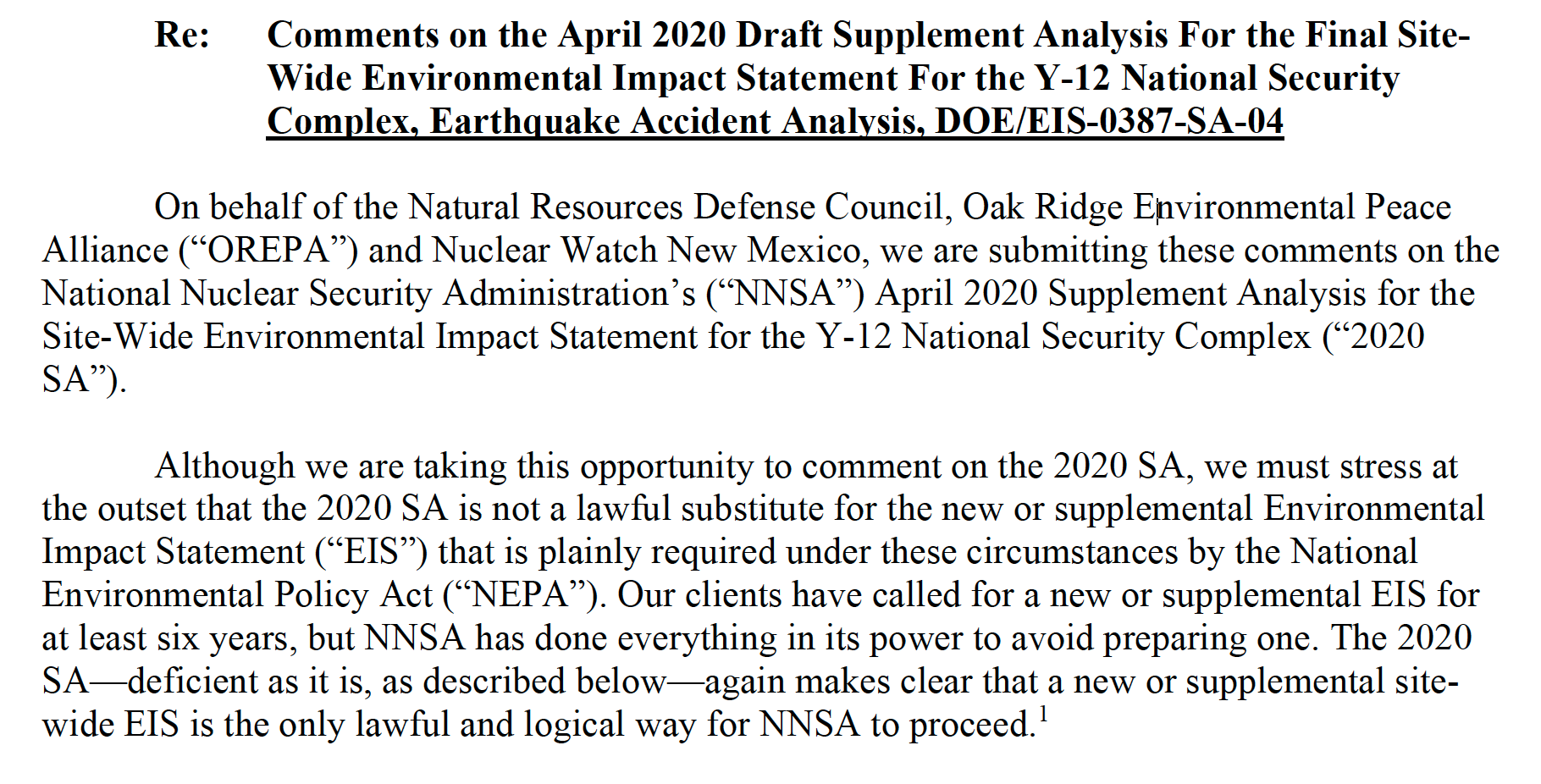
COLLECTIVE COMMENTS: on the National Nuclear Security Administration’s (NNSA’s) Draft Supplement Analysis of the 2008 Site-Wide Environmental Impact Statement for the Continued Operation of Los Alamos National Laboratory (LANL) for Plutonium Operations
These comments were signed onto by over 100 individuals and organizations.
THANK YOU to all those who participated!
Plutonium Pit Production Forum – Full Video
Workshop on expanded production of the radioactive cores of nuclear weapons at the Los Alamos National Laboratory
Presenters:
- Jon Lipsky, FBI agent that led the 1989 raid investigating environmental crimes that shut down the Rocky Flats bomb plant
- Jay Coghlan, Executive Director, Nuclear Watch New Mexico, on plutonium pit production at LANL
- Marylia Kelley, Executive Director, Tri-Valley CAREs (Livermore, CA) on the new nuclear arms race
- Scott Kovac, Nuclear Watch New Mexico, on LANL cleanup issues
Is Los Alamos Lab Half Empty or Over Full of Radioactive Wastes?
August 22, 2019
The Department of Energy’s (DOE’s) Environmental Management Los Alamos (EMLA) field office has repeatedly claimed that “> [i.e., more than] ½ of legacy cleanup has been completed.”1 This claim doesn’t explain how this is measured. Does it mean ½ of the time, ½ of the cost, ½ of the sites, or ½ of the wastes? However it is measured, New Mexicans need to know that DOE and the Los Alamos National Laboratory (LANL) are NOT talking about real comprehensive cleanup.
When EMLA and its cleanup contractor (N3B) talk about cleanup, they mean specific narrow measures for specific sites, including much paperwork and studies instead of actual cleanup. Contrary to EMLA’s self-proclaimed openness and transparency, the claim of greater that half-completed cleanup is based on decisions made without public input to leave the vast majority of radioactive and toxic wastes permanently buried above our precious groundwater.
While some Lab cleanup started in the late 1980s, tracking of the cleanup budget didn’t start until 1997, which is the date used as the beginning of “prior costs” in recent DOE Congressional Budget Requests. 2 EMLA’s current estimated date for completion of planned cleanup is 2037. That would be 22 years down and 18 to go, if we look at 1997 to 2037, which would be ½ of the time if EMLA completes its planned cleanup by 2037. If decisions are made to remove more wastes, which would be the right thing to do, cleanup could last for decades more while generating 100’s of high-paying jobs. Real, comprehensive cleanup would be well worth the wait!
| 2019
November 26, 2019 Press Release November 24, 2019 Press Release November 19, 2019 Plutonium Pit Production Workshop Presenters:
August 12, 2019 NEPA Comments NukeWatch’s 22-page formal comments on expanded plutonium pit production Until NNSA fully complies with the National Environmental Policy Act through the preparation of a programmatic environmental impact statement on expanded plutonium pit production, Nuclear Watch believes that any irreversible or irretrievable commitment of resources to either the expansion of pit production at the Los Alamos Lab or to the repurposing of the MOX Facility at the Savannah River Site is unlawful. Read/Download the Full Document HERE July 25, 2019 NEPA Comments Scoping comments on NNSA draft EIS for plutonium pit production at the Savannah River Site THE NEED FOR A PROGRAMMATIC ENVIRONMENTAL IMPACT STATEMENT: This is our first and primary concern, that NNSA must first complete a programmatic environmental impact statement (PEIS) on its nation-wide plans for plutonium pit production, in advance of the Savannah River Site-specific environmental impact statement. To get right to the point, we argue that the SRS EIS process should go no further than this scoping period and should resume only after a completed formal Record of Decision for a new or supplemental PEIS. Read/Download the Full Document HERE July 9, 2019 Plutonium Pit Production Fact Sheet Expanding Nuclear Pit Production: The Facts and What You Can Do The Facts Read/Download the Full Document HERE June 10, 2019 News Release In a victory for transparency and legal compliance by the government, the U.S. Department of Energy’s National Nuclear Security Administration (NNSA) today published a “Notice of Intent” in the Federal Register to complete environmental reviews on its controversial proposal to expand plutonium “pit” production for new and refurbished nuclear weapons. [embeddoc url="https://nukewatch.org/wp-content/uploads/2019/06/SRS-plutonium-bomb-plant6-14-19.pptx" download="all" viewer="google"] Read/Download the Full News Release HERE June 4, 2019 Press Release On behalf of three public interest organizations - Nuclear Watch New Mexico, Tri-Valley Communities Against a Radioactive Environment and Savannah River Site Watch – attorneys for the law firm of Meyer Glitzenstein & Eubanks and the Natural Resources Defense Council recently sent a 16-page letter to Lisa Gordon-Hagerty, head of the National Nuclear Security Administration (NNSA). The detailed letter warns the nuclear agency to not proceed with aggressive plans to expand plutonium pit production without first meeting its legal requirements for timely public review and comment under the National Environmental Policy Act. Read/Download the Full Press Release HERE May 31, 2019 Press Release Last Wednesday, facility operations personnel entered a service room and noticed a leak emanating from a valve on the radioactive liquid waste (RLW) system. Upon subsequent visual inspection by a radiological control technician, RLUOB engineers believe that this valve, and 6 similar valves, may be constructed of carbon steel. The RLW system handles radioactive liquid waste streams from chemistry operations that include nitric and hydrochloric acids—carbon steel valves would be incompatible with these solutions. The suspect valves are also in contact with stainless steel piping, which would create another corrosion mechanism. RLUOB management plans to drain the affected piping sections and develop a work package to replace all of the suspect valves. They will also confirm the valve materials and if shown to be incorrect, investigate the cause of this failure in the design, procurement, and installation processes. The valves were installed in 2013 as part of a modification to add straining and sampling capabilities that were not in the included in the original design. [Please note that DNFSB reports are posted a few weeks later than dated.] This immediately raises two crucial issues: 1) the National Nuclear Security Administration’s (NNSA’s) plans for expanded plutonium pit production; and 2) the current attempt by the Department of Energy to restrict Safety Board access to its nuclear weapons facilities. Read/Download the Full Press Release HERE April 26, 2019 Consent Orders Comparison On March 1, 2005, after arduous negotiations and threats of litigation, the New Mexico Environment Department (NMED), Department of Energy (DOE), and Los Alamos National Laboratory (LANL) entered into a Consent Order specifying the schedule for investigation and cleanup of the Lab’s hundreds of contaminated sites. This Consent Order (CO) was LANL’s agreement to fence-to-fence cleanup of Cold War legacy wastes, which NMED began to enforce. Read/Download the Full Comparison HERE March 25, 2019 Press Release More than 25 years after the end of the Cold War, all eight established nuclear weapons powers are “modernizing” their stockpiles. Talks have broken down with North Korea, the new nuclear weapons power. Nuclear-armed India and Pakistan narrowly averted war last month. Russian President Vladmir Putin made new nuclear threats in response to Trump’s announced withdrawal from the Intermediate-Range Nuclear Forces Treaty. This could lead to hair-trigger missile emplacements in the heart of Europe and block extension of the New Strategic Arms Reduction Treaty with Russia. If so, the world will be without any nuclear arms control at all for the first time since 1972. Meanwhile, the U.S. criticizes non-weapons states for signing a nuclear weapons ban treaty, despite the fact there have long been treaties completely banning chemical and biological weapons of mass destruction that the U.S. seeks to enforce. The pending international NonProliferation Treaty (NPT) Preparatory Committee conference at the United Nations is widely expected to collapse in failure because of the nuclear weapons powers’ failure to enter into serious negotiations leading to nuclear disarmament. The NPT’s Article VI mandate for those negotiations has been in effect since 1970, when the Treaty was signed by 189 countries (more than any other treaty). Read/Download the Full Press Release HERE March 26, 2019 NukeWatch Budget Compilation Nuclear Watch New Mexico — Department of Energy FY 2020 Nuclear Weapons Budget Request |
| 2018
November 16, 2018 Plutonium Pit Production Fact Sheet Plutonium pits are the radioactive cores or “triggers” of nuclear weapons. Their production has always been a chokepoint of resumed industrial-scale U.S. nuclear weapons production ever since a 1989 FBI raid investigating environmental crimes shut down the Rocky Flats Plant near Denver. In 1997 the mission of plutonium pit production was officially transferred to its birthplace, the Los Alamos National Laboratory (LANL) in northern New Mexico, but officially capped at not more than 20 pits per year. However, in 2015 Congress required expanded pit production by 2030 whether or not the existing nuclear weapons stockpile actually needs it. This will support new military capabilities for nuclear weapons and their potential use. Read/Download the full fact sheet pdf HERE October 31, 2018 Nuclear Watch New Mexico, Savannah River Site Watch, and Tri-Valley CAREs sent a letter of demand to the U.S. Department of Energy’s National Nuclear Security Administration (NNSA) to inform the government that its plan to quadruple the production rate of plutonium bomb cores is out of compliance with the National Environmental Policy Act (NEPA). NNSA’s premature plan to quadruple the production rate of plutonium bomb cores (“pits”), the heart of all US nuclear weapons, is out of compliance with requisite environmental law, the groups argue, as NNSA has failed to undertake a legally-mandated programmatic review and hold required public hearings. View/Download the entire press release HERE NukeWatch Comments, September 27, 2018 Nuclear Watch New Mexico is submitted formal comments to express in the strongest possible terms our opposition to DOE Order 140.1 Interface with the Defense Nuclear Facilities Safety Board. We find that the Department of Energy’s (DOE’s) attempt to restrict and suppress DNFSB access is very misguided, arrogant, and likely illegal in that it acts contrary to the Board’s enabling legislation. June 8, 2018 Press Release New Contractors Selected For Expanded Nuclear Weapons Production at Los Alamos Santa Fe, NM. Today the Department of Energy's National Nuclear Security Administration (NNSA) announced its choice for the new management and operating contract for the Los Alamos National Laboratory (LANL).The new contractor, Triad National Security, LLC, is a limited liability company consisting of the Battelle Memorial Institute, the University of California and Texas A&M University. All three are non-profits, and it is unclear how this will affect New Mexico gross receipts taxes. Battelle claims to be the world's largest non-profit technology research and development organization, and manages a number of labs including the Lawrence Livermore and Idaho National Laboratories. Texas A&M was founded in 1876 as the state's first public institution of higher learning and has the largest nuclear engineering program in the country. DOE Secretary Rick Perry is an avid A&M alumnus. May 31, 2018 Press Release Santa Fe, NM & Columbia, SC - "Two key U.S. Department of Energy documents on future production of plutonium "pits" for nuclear weapons, not previously released to the public, fail to justify new and upgraded production facilities at both the Los Alamos National Laboratory (LANL) in New Mexico and the Savannah River Site (SRS) in South Carolina." May 15, 2018 Fact Sheet May 10, 2018 Press Release What's Not in NNSA's Plutonium Pit Production Decision
- NNSA did not mention that up to 15,000 "excess" pits are already stored at the Pantex Plant near Amarillo, TX, with up to another 5,000 in "strategic reserve." The agency did not explain why new production is needed given that immense inventory of already existing plutonium pits. (In 2006 independent experts found that pits last a least a century. Plutonium pits in the existing stockpile now average around 40 years old.) May 2, 2018 Press Release "NNSA should begin nation-wide review of plutonium pit production, why it's needed, and what it will cost the American taxpayer in financial, safety and environmental risks. These are all things that the public should know." -Jay Coghlan, Director, Nuclear Watch New Mexico. April 26, 2018 NukeWatch Comments LANL Rad Lab: Formal Comments Under Nat'l Environmental Policy Act Against raising plutonium limit at LANL Rad Lab View/download Nuclear Watch comments as submitted Excerpt:
- NNSA is planning a 10-fold increase in plutonium at the LANL Rad Lab with a view to ramping up the production of plutonium pits for new nuclear weapons. March 26, 2018 Press Release United States To Begin Construction Of New Nuclear Bomb Plant The National Nuclear Security Administration (NNSA) announced on Friday, March 23, that it was authorizing the start of construction of the Uranium Processing Facility (UPF) and two sub-projects at the Y-12 National Security Complex in Oak Ridge, Tennessee. The UPF is a facility dedicated solely to the manufacture of thermonuclear cores for US nuclear bombs and warheads.
Jay Coghlan of NukeWatch points out that "This project already has a long history, and it is instructive. In 2013, DOE announced it was 85% finished with the UPF design when it ran into the 'space/fit' issue- and more than a half-billion taxpayer dollars were just written off. In private business, that kind of thing gets you fired. In DOE's world of contractors running amok, they not only didn't get fired, not one Congressional hearing was held and the UPF budget went up the next year!" - See full press release for all the details (PDF) March 1, 2018 Press Release The Regional Coalition of LANL Communities: Benefits for the Select Few Santa Fe, NM- According to media reports, Andrea Romero, Executive Director of the Regional Coalition of LANL Communities, is accused of charging some $2,200 dollars of unallowable travel costs, such as alcohol and baseball tickets, while lobbying in Washington, DC for additional funding for the Los Alamos National Laboratory (LANL). She in turn accused the nonprofit group Northern New Mexico Protects of political motivations in revealing these questionable expenses. Romero is running in the Democrat Party primary against incumbent state Rep. Carl Trujillo for Santa Fe County's 46th district in the state House of Representatives. For all the details, see full press release PDF February 28, 2018 Press Release Santa Fe, NM. On December 17, 2017, the Department of Energy (DOE) awarded a separate $1.4 billion contract for cleanup at the Los Alamos National Laboratory (LANL) to Newport News Nuclear BWXT-Los Alamos, LLC (also known as "N3B"). This award followed a DOE decision to pull cleanup from LANL's prime contractor, Los Alamos National Security, LLC (LANS), after it sent an improperly prepared radioactive waste drum that ruptured underground at the Waste Isolation Pilot Plant (WIPP). That incident contaminated 21 workers and closed WIPP for nearly three years, costing taxpayers at least $1.5 billion to reopen. (See all the details in the full press release) February 26, 2018 Press Release Detailed NNSA Budget Documents Accelerates Nuclear Weapons Arms Race Santa Fe, NM. Late Friday February 23, the Trump Administration released the detailed FY 2019 budget for the National Nuclear Security Administration (NNSA), the semi-autonomous nuclear weapons agency within the federal Department of Energy. Overall, NNSA is receiving a $2.2 billion boost to $15.1 billion, a 17% increase above the FY 2018 enacted level. Of that, a full $11 billion is for the budget category [Nuclear] "Weapons Activities", 18% above the FY 2018 level. Of concern to the American taxpayer, DOE and NNSA nuclear weapons programs have been on the congressional Government Accountability Office's High Risk List for project mismanagement, fraud, waste and abuse since its inception in 1990... (See all the details in the full press release) February 22, 2018 Press Release Santa Fe, NM. Today the National Nuclear Security Administration announced an Environmental Assessment to increase the amount of plutonium used in the Radiological Laboratory Utility and Office Building (aka the "Rad Lab") at the Los Alamos National Laboratory from 38.6 grams of plutonium-239 equivalent to 400 grams. This 10-fold increase is significant because it will dramatically expand materials characterization and analytical chemistry capabilities in the Rad Lab in support of expanded plutonium pit production for future nuclear weapons designs. It also re-categorizes the Rad Lab from a "radiological facility" to a "Hazard Category-3" nuclear facility. View/Download full press release February 12, 2018 Press Release Trump's Budget Dramatically Increases Nuclear Weapons Work Santa Fe, NM In keeping with the Trump Administration's recent controversial Nuclear Posture Review, today's just released FY 2019 federal budget dramatically ramps up nuclear weapons research and production. January 12, 2018 Press Release Draft Nuclear Posture Review Degrades National Security Yesterday evening the Huffington Post posted a leaked draft of the Trump Administration's Nuclear Posture Review (NPR). This review is the federal government's highest unclassified nuclear weapons policy document, and the first since the Obama Administration's April 2010 NPR. 2017 |
| 2017
December 22, 2017 Press Release New Mexico Environment Department Surrendered to DOE Extortion Santa Fe, NM. The New Mexico State Auditor Office recently questioned whether two settlements between the New Mexico Environment Department and the Department of Energy were in the best interests of New Mexico. That Office noted: (View/download full press release) December 20, 2017 Press Release Los Alamos Hires New Contractor - Starts Cleanup On the Cheap Santa Fe, NM- Today the Department of Energy (DOE) announced the award of the new Los Alamos National Laboratory legacy cleanup contract to Newport News Nuclear BWXT-Los Alamos, LLC. The $1.39 billion contract is for ten years, which works out to $139 million per year... View/download the full press release Public Presentation, December 2, 2017 October 31, 2017 Press Release Today, in Washington, DC, the Congressional Budget Office released its new report, "Approaches for Managing the Costs of U.S. Nuclear Forces, 2017 to 2046". The Congressional Budget Office estimates that the most recent detailed plans for nuclear forces, which were incorporated in the Obama Administration's 2017 budget request, would cost $1.2 trillion in 2017 dollars over the 2017-2046 period: more than $800 billion to operate and sustain (that is, incrementally upgrade) nuclear forces and about $400 billion to modernize them.... Driving this astronomical expense is the fact that instead of maintaining just the few hundred warheads needed for the publicly claimed policy of "deterrence," thousands of warheads are being refurbished and improved to fight a potential nuclear war. This is the little known but explicit policy of the U.S. government! October 27, 2017 Press Release Santa Fe, NM. On the evening of Wednesday October 25, the Santa Fe City Council passed a resolution requesting that the New Mexico Environment Department strengthen the revised Los Alamos National Labs cleanup order to call for additional characterization of legacy nuclear wastes, increased cleanup funding, and significant additional safety training. The resolution also called for the suspension of any planned expanded plutonium pit production until safety issues are resolved. (view/download full press release) October 6, 2017 Press Release Santa Fe, NM. Nuclear Watch New Mexico strongly applauds the awarding of the Nobel Peace Prize to the International Campaign to Abolish Nuclear Weapons (disclosure: NukeWatch is one of ICAN's ~400 member groups around the world). This award is especially apt because the peoples of the world are now living at the highest risk for nuclear war since the middle 1980's, when during President Reagan's military buildup the Soviet Union became convinced that the United States might launch a pre-emptive nuclear first strike. Today, we not only have Trump's threats to "totally destroy" North Korea and Kim Jong-un's counter threats, but also renewed Russian fears of a US preemptive nuclear attack... Generally unknown to the American taxpayer, our government has quietly tripled the lethality of the US nuclear weapons stockpile..." (view/download complete press release) NukeWatch fact sheet, September 26, 2017 The National Nuclear Security Administration's own documents have explicitly stated that expanded pit production would have no significant positive effect on job creation and the regional economy of northern New Mexico. Nuclear Watch argues that expanded plutonium pit production could actually have negative effect if it blocks other economic alternatives such as comprehensive cleanup, which could be the real job producer. Moreover, given LANL's poor safety and environmental record, expanded plutonium pit production could have a seriously negative economic impact on northern New Mexico in the event of any major accidents. September 15, 2017 Press Release Santa Fe, NM. The Los Alamos National Laboratory (LANL) has detected far more hexavalent chromium (Cr) contamination than previously estimated in the "sole source" regional groundwater aquifer that serves Los Alamos, Santa Fe and the Espanola Basin. Sampling in July from a new well meant to inject treated groundwater back into the aquifer detected chromium contamination five times greater than the New Mexico groundwater standard of 50 micrograms per liter (ug/L). View/download the full press release September 11, 2017 Press Release Talking Points: The 2016 LANL Cleanup Consent Order Should Be Rescinded The 2005 LANL Cleanup Consent Order was all about the enforceable schedules. It required DOE and LANL to investigate, characterize, and clean up hazardous and mixed radioactive contaminants from 70 years of nuclear weapons research and production. It stipulated a detailed compliance schedule that the Lab was required to meet. Under Gov. Martinez, NMED Secretary Ryan Flynn granted more than 150 compliance milestone extensions at the Lab's request, effectively eviscerating it. View/download the complete talking points July 20, 2017 Press Release Washington, DC Today, the Oak Ridge Environmental Peace Alliance (OREPA), Nuclear Watch New Mexico, and the Natural Resources Defense Council filed a federal lawsuit to stop construction of the problem-plagued Uranium Processing Facility (UPF) until legally required environmental review is completed. The UPF, located at the National Nuclear Security Administration's (NNSA's) Y-12 production plant near Oak Ridge, TN, is slated to produce new thermonuclear weapons components until the year 2080. The UPF is the tip of the spear for the U.S.'s planned one trillion dollar-plus make over of its nuclear weapons arsenal, delivery systems, and production plants. View/download the full press release June 19, 2017 Press Release Some Background on Plutonium Pit Production at the Los Alamos Lab Santa Fe, NM -The Washington Post has published the first in a series of articles on nuclear safety lapses in plutonium pit production at the Los Alamos Lab. Plutonium pits are the fissile cores of nuclear weapons that when imploded initiate the thermonuclear detonation of modern weapons. By the way, did you know? Plutonium facilities at LANL are- in principle- designed to withstand a serious earthquake of a degree expected to occur only once every 10,000 years. The last serious earthquake near the Lab is believed to have occurred 11,500 years ago. View/download the full press release ANA Report 2017: Accountability Audit May 19, 2017 Press Release SA Preview of Trump's Budget: More Nuclear Bombs and Plutonium Pit Production Santa Fe, NM. "The proposed level of funding for the National Nuclear Security Administration's (NNSA)'s Total Weapons Activities is $10.2 billion, a full billion above what was requested for FY 2017. In March, Trump's "skinny budget" stated NNSA's funding priorities as 'moving toward a responsive nuclear infrastructure', and 'advancing the existing warhead life extension programs'. Read the full press release for all the details. March 28, 2017 ANA workshop at UN Ban Treaty Conference Ban Treaty Conference: Alliance for Nuclear Accountability Panel Discussion March 28, 2017, UN, NYC:
March 2017 Fact Sheet Plutonium Pit Production at LANL (Updated March 2017) February 23, 2017 Press Release Costs Jump in Nuclear Weapons vs. Cleanup; Nuclear Weapons Winning over Environmental Protection Santa Fe, NM. America is at a crossroads, having to choose between an unnecessarily large, exorbitant, nuclear weapons stockpile, and cleanup that would protect the environment and water resources for future generations. Expanded nuclear weapons research and production, which will cause yet more contamination, is winning. Read the full press release for all the details. January 5, 2017 Press Release The National Nuclear Security Administration (NNSA) has publicly released its fiscal year 2016 Performance Evaluation Report (PER) for Los Alamos National Security, LLC (LANS), the for-profit contractor that runs the Los Alamos Lab. The Performance Evaluation Report is NNSA's annual report card on contractor performance, and overall the agency awarded LANS $59 million in profit out of a possible $65 million. The grade was 85% for the incentive part of the award. In 2012 Nuclear Watch New Mexico successfully sued NNSA to ensure that the Performance Evaluation Reports detailing taxpayers funds paid to nuclear weapons contractors are publicly available. In 2016 the NNSA decided to put the LANL management contract out for competitive bid, but granted LANS a contract extension until the end of September 2018. |
Media appearances including radio interviews are listed on the internal Media page
See the NukeWatch Channel at YouTube for our extensive playlists of key videos.
See the Nukewatch Twitter feed
See the Nukewatch Tumblr site
WatchBlog Posts:
Over 200 posts published since 2009. See archives at the WatchBlog
Earlier Work Product items are archived here


